Spitzer Space Telescope
Non-EO
NASA
Astronomy and Telescopes
Quick facts
Overview
| Mission type | Non-EO |
| Agency | NASA |
| Launch date | 25 Aug 2003 |
| End of life date | 30 Jan 2020 |
Spitzer Space Telescope (SST) Mission
Spacecraft Launch Sensor Complement Mission Status References
The Spitzer Space Telescope is the final mission in NASA's Great Observatories Program - a family of four space-based observatories, each observing the Universe in a different kind of light. The other missions in the program include the visible-light Hubble Space Telescope (HST), Compton Gamma-Ray Observatory (CGRO), and the Chandra X-Ray Observatory (CXO). 1)
Spitzer was designed to detect infrared radiation, which is primarily heat radiation. It was comprised of two major components (Ref. 1):
• The Cryogenic Telescope Assembly, which contained the 85 centimeter telescope and Spitzer's three scientific instruments.
- All of Spitzer's cold items were kept in the Cryogenic Telescope Assembly (CTA), which was made up of four main-parts: The Telescope, Multiple Instrument Chamber (Infrared Array Camera, Infrared Spectrograph, and Multiband Imaging Photometer), Cryostat, and Outer Shell Group.
• The Spacecraft, which controls the telescope, provides power to the instruments, handles the scientific data and communicates with Earth.
It may seem like a contradiction, but NASA's Spitzer Space Telescope must be simultaneously warm and cold to function properly. Everything in the Cryogenic Telescope Assembly must be cooled to only a few degrees above absolute zero (-273º Celsius). This is achieved with an onboard tank of liquid helium, or cryogen. Meanwhile, electronic equipment in The Spacecraft portion needs to operate near room temperature.
Spitzer's highly sensitive instruments allow scientists to peer into cosmic regions that are hidden from optical telescopes, including dusty stellar nurseries, the centers of galaxies, and newly forming planetary systems. Spitzer's infrared eyes also allows astronomers see cooler objects in space, like failed stars (brown dwarfs), extrasolar planets, giant molecular clouds, and organic molecules that may hold the secret to life on other planets.
Spitzer was originally built to last for a minimum of 2.5 years, but it lasted in the cold phase for over 5.5 years. On May 15, 2009 the coolant was finally depleted and the Spitzer "warm mission" began. Providing imaging with two channels (at 3.6 and 4.5 µm) in one of its instruments (IRAC), Spitzer continued to operate until January 30, 2020. The warm mission became the "Spitzer Beyond" mission in August 2016. NASA announced in May 2019 that it would end the Spitzer mission on January 30, 2020, naming the remaining mission the “Spitzer Final Voyage”.
Spacecraft
Spitzer's spacecraft referred to the uncooled portion of the observatory, including the Solar Panel Assembly, the Spacecraft Bus, and all of the components mounted in the bus that provided the Observatory engineering functions. These components included the solar arrays, the command and data handling unit, the reaction control subsystem, the telecommunications subsystem, the power generation and distribution subsystem, the pointing control subsystem, and the flight software.
The spacecraft consisted of two main parts: the solar panels, which provided electrical power to the spacecraft and shielded the Cryogenic Telescope Assembly from the Sun; and the spacecraft bus: an octagonal structure that housed the avionics and the warm electronics parts of the science instruments. The spacecraft provided electrical power to the science instruments, oriented and stabilized the telescope, stored and compressed the data from the science instruments for later transmission to Earth, executed the stored commands to carry out the planned observing schedule, and communicated with the ground system. All communications with Spitzer took place through NASA's Deep Space Network.
Spacecraft bus: Spitzer's bus was an octagonal structure at the base of the Observatory that housed the avionics and the warm electronic parts of the science instruments. The Spacecraft Bus supplied the science instruments with the electrical power generated by the Solar Panel Assembly, oriented and stabilized the telescope, collected, compressed and stored the science data for transmission to Earth, executed the stored commands to carry out the planned observing schedule, and communicated with the ground systems.
The bus structure had nine bays in which the equipment was housed, made up of four side modules, four corner modules, two heat pipe equipment panels, and six equipment panels. The equipment panels were sandwiched between the modules and were bolted and bonded together for maximum stiffness and structural integrity. On the outside of the bays, panels were bolted to the modules. These panels were removable, and provided access to the outer bays during the assembly and testing of the Observatory. The center bay of the nine was assessed through the top of the bus.
The bus was also the mounting point for the star tracker and gyroscopes that allowed Spitzer to orient itself in space. The main antenna for communication with Earth, called the High Gain Antenna was mounted on the back of the bus, and the secondary antennae (the Low Gain Antennae) were mounted on the side. The maneuvering thrusters were mounted on outriggers attached to the bus.
The Spitzer flight hardware consists of a spacecraft that operates at roughly ambient temperature and a cryogenic telescope assembly (CTA) that is cooled by a combination of superfluid liquid helium, helium boil-off gas, and radiative cooling and operates at much lower temperatures. The spacecraft was built by Lockheed Martin, Sunnyvale, California, and the CTA by Ball Aerospace. The two components are thermally isolated from each other by a system of low-thermal-conductivity struts and shields. 2)
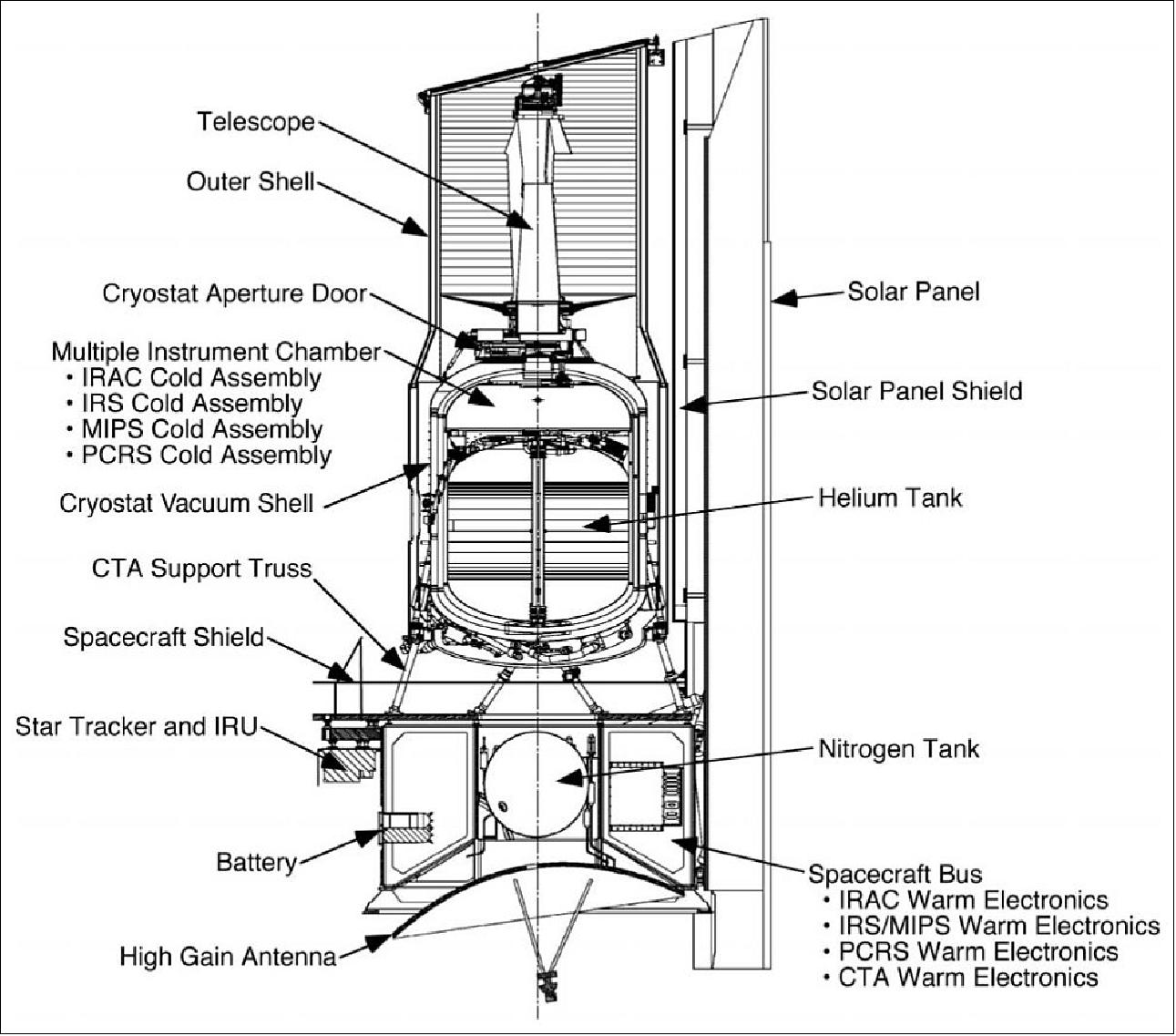
Total Observatory mass at launch | 861 kg |
Dimensions (height ;diameter) | 4.5 m x 2.1 m |
Average operation power | 375 W |
Solar array generating capacity at launch | 500 W |
Nitrogen reaction control gas at launch | 15.59 kg |
Estimated reaction control gas lifetime | 17 years |
Mass memory capacity | 2 GB |
Telescope primary diameter | 85 cm |
Telescope central obscuration | 14.2% |
Superfluid helium at launch | 337 liter |
Estimated nominal cryogenic lifetime | 5.3 years |
Data transmission rate (high-gain antenna up to 0.58 AU from Earth) | 2.2 Mbit/s |
Command communication rate | 2 kbit/s |
The Spitzer spacecraft handles the observatory’s power generation, pointing and momentum control, data processing and storage, and telecommunications functions. It also contains the warm electronics portions of the three scientific instruments. The spacecraft structure itself is octagonally shaped, constructed from graphite composite and aluminum honeycomb material, and is mounted to the cold CTA (Cryogenic Telescope Assembly) with low thermal conductivity gamma-alumina struts. A set of aluminized Mylar thermal blankets and aluminum/graphite epoxy honeycomb radiation shields dramatically reduces the radiative thermal load from the warm spacecraft onto the CTA. A similar system of thermal shields attenuates the thermal radiation from the solar array, which is cantilevered from the spacecraft structure without any physical connection to the cold CTA. There are approximately 1500 wires that run from the warm spacecraft to the cold CTA. These were constructed of very low thermal conductivity materials and carefully heat-sunk so that they caused minimal parasitic heat input. The spacecraft avionics are fully redundant, as are the components of the pointing and control system (PCS) and reaction control system (RCS).
The PCS comprises reaction wheels, gyroscopes, and star trackers. Four reaction wheels mounted in a pyramid arrangement provide redundancy against a single wheel failure. As the spacecraft is well outside the Earth’s magnetic field, accumulated angular momentum is removed through an ambient-temperature, pressurized nitrogen gas RCS. The nitrogen gas plume does not affect the infrared environment or the sensitive CTA thermal control surfaces. Twice a day a redundant pair of visible-light sensors (pointing calibration reference sensors [PCRS]) in the telescope focal plane provide calibration of the telescope boresight to the star trackers, which are mounted to the spacecraft structure.
The CTA (Cryogenic Telescope Assembly) consists of the telescope assembly, the cryogenic portions of the three science instruments, a superfluid helium Dewar, and various thermal shields. Spitzer employs a novel thermal design (hereafter referred to as the ‘‘warm launch’’ design), in which most of the mass of the CTA, including the telescope and its baffles, is external to the cryostat vacuum shell and is launched at ambient temperature, only beginning to cool when on-orbit. This allows for a much smaller vacuum pressure vessel and a smaller total observatory mass than would a design based on the more conventional ‘‘cold launch’’ architecture used in the earlier Infrared Astronomical Satellite (IRAS) and Infrared Space Observvatory (ISO) missions. The components of the CTA external to the cryostat are cooled after launch by a combination of radiation and helium boil-off vapor under a concept developed by F. Low and described in more detail in Lysek et al. (1995).
A very low temperature CTA outer shell is critical to the achievement of a long mission lifetime with a small cryostat, but requires excellent thermal isolation between warm and cold components as well as tight restrictions on the orientation of the flight hardware with respect to the Sun. The CTA outer shell is painted with high-emissivity black paint on the side that faces away from the Sun and is polished aluminum on the sides that face the thermal shields, solar array, and warm spacecraft components. The Spitzer warm launch design and the wide range of infrared wavelengths observed by the focal plane instruments require an open aperture in the vacuum cryostat after launch to allow the passage of infrared light from the telescope into the instrument chamber. For this purpose a removable vacuum window was constructed of gold-film–coated sapphire to allow the cold instruments to perform visible and near-infrared alignment of the CTA optical train on the ground without having to deploy the window prior to launch. A dust cover over the outer shell aperture that was ejected 4.9 days after launch, and 0.9 days prior to the opening of the cryostat window, was the only other deployable mechanism on the Spitzer observatory.
The telescope optics and metering structure are constructed entirely of beryllium, minimizing changes in both the telescope prescription and its alignment with the focal plane as the telescope cools on-orbit. A moveable secondary capable of motion only along the optical axis was installed to compensate for any changes in focus due to gravity release and uncertainties in the ground testing of the telescope. The telescope optics are not cooled directly by the helium bath but are thermally coupled to the cryostat vacuum shell, which is cooled by the superfluid helium boil-off vapor. The higher the boil-off rate, the colder the telescope. The telescope temperature necessary to keep thermal emission from the optics negligible compared to the natural zodiacal background decreases with wavelength, reaching 5.6 K for the 160 µm channel in the Multiband Infrared Photometer for Spitzer (MIPS) instrument. MIPS itself does not dissipate enough power in its cold assemblies to provide the necessary boil-off rate for this temperature; a small adjustable heater in the cryogen provides a few extra milliwatts of power if needed. The helium liquid-gas interface is constrained within a porous plug phase separator, preventing rapid helium coolant loss.
Launch
The Spitzer Space Telescope with a launch mass of 950 kg was launched on 25 August 2003 (05:35:39 UTC) on a Delta 7920H ELV rocket from Florida's Cape Canaveral Air Force Base.
Orbit: Earth-trailing heliocentric orbit. As seen from Earth, Spitzer recedes at about 0.12 AU yr-1 and will reach a distance of 0.62 AU in five years. The Earth-trailing orbit has several major advantages over a low-Earth orbit for Spitzer. The principal advantage is being away from the heat of the Earth; this enables the warm launch architecture and the extensive use of radiative cooling which makes Spitzer’s cryo-thermal design extremely efficient. More precisely, the solar orbit allows the spacecraft always to be oriented with the solar array pointed at the Sun while the black side of the outershell has a complete hemispherical view of deep space with no interfering heat sources, enabling the radiative cooling of the outer shell described earlier. The absence of eclipses in the solar orbit makes for an extremely stable thermal configuration and reduces variability of the alignment between the cold telescope and the warm star tracker and inertial reference unit (gyroscopes) to less than 0.5 arcseconds over timescales of days. Operationally, the orbit permits excellent sky viewing and observing efficiency. Finally, while in a solar orbit the observatory is not affected by the charged particles in the Van Allen radiation belts. These thermal and charged particle advantages are shared by the L2 orbit contemplated for JWST. Unlike an L2 orbit, however, Spitzer’s heliocentric orbit eliminates the need for station-keeping, allowing the use of a smaller and less-costly launch vehicle (Ref. 2).
The orbit has two disadvantages. Firstly, as Spitzer moves away from the Earth, the power margins for data transmission and command communication decrease, forcing changes in communication strategy and, eventually, somewhat reduced efficiency as more time is spent communicating with the ground stations. The data are transmitted to the antennae of the DSN (Deep Space Network) by orienting the S/C so that a fixed X-band antenna located on the bottom of the spacecraft is pointed at the Earth. Our current data transmission strategy of two ~45-minute passes per day at a data rate of 2.2 Mbit/s is robust for at least the first 2.5 years of the mission Secondly, outside of the protection of the Earth’s magnetosphere Spitzer is more susceptible to solar proton storms and is subject to a higher quiescent galactic cosmic rate flux. However, as mentioned above Spitzer is also free from the daily passages through the South Atlantic Anomaly which provide the main radiation dose in LEO (Low Earth Orbit).
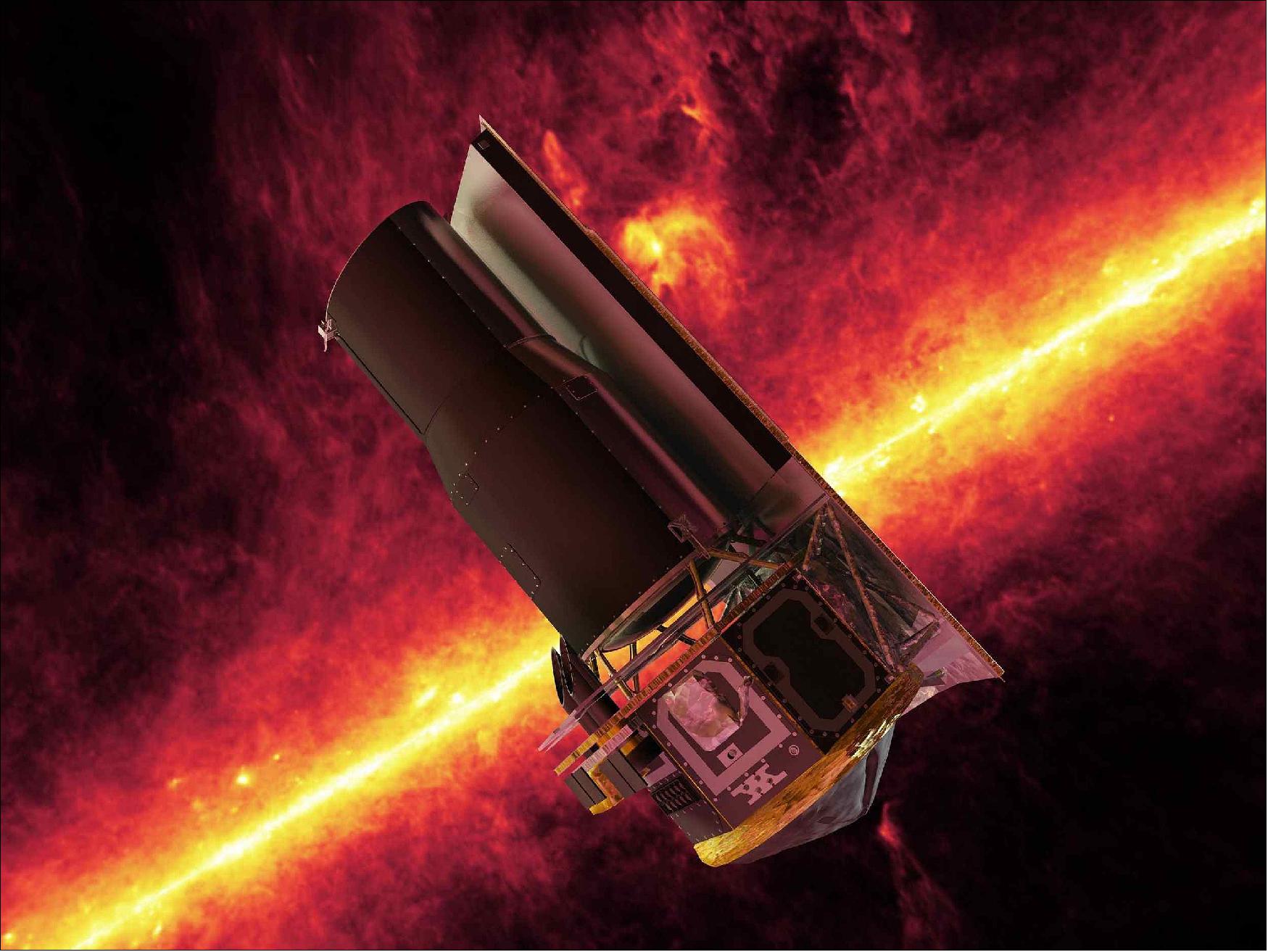
Sensor Complement (IRAC, IRS, MIPS)
The three infrared instruments IRAC (Infrared Array Camera), IRS (Infrared Spectrogrph) and MIPS (Multiband Infrared Photometer for Spitzer) share a common focal plane. Their fields of view are defined by pick-off mirrors, as shown in Figure 3. The top level design and performance characteristics of the instruments are described in Tables 2–4 (Ref. 2).
The IRAC instrument was built at NASA/GSFC. PI: G. G. Fazio, Smithsonian Astrophysical Observatory.
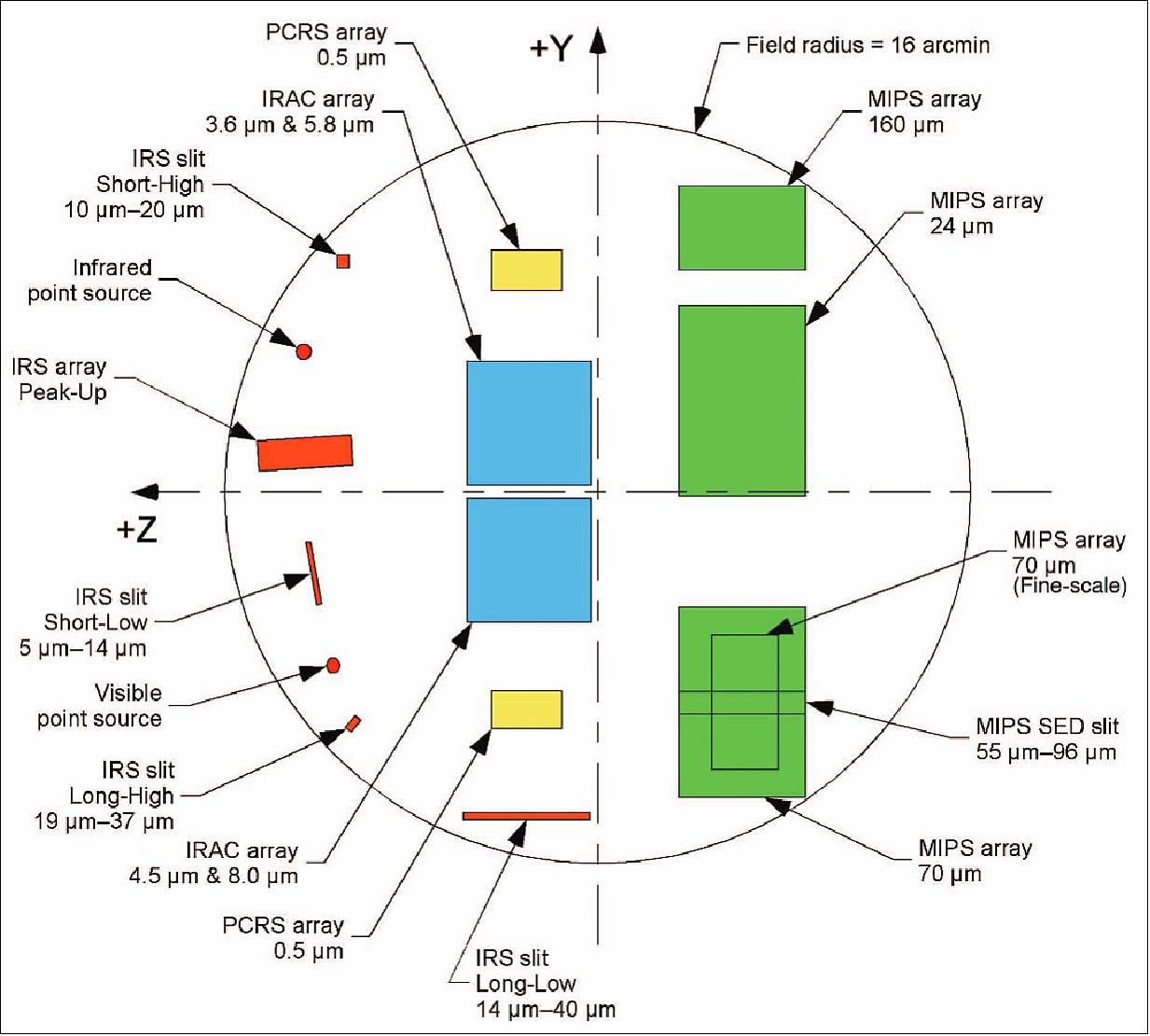
Channel | Wavelength (µm) | FOV (Field of View), arcmin | Detector |
1 | 3.19–3.94 | 5.2 x 5.2 | 256 x 256 InSb |
2 | 4.00–5.02 | 5.2 x 5.2 | 256 x 256 InSb |
3 | 4.98–6.41 | 5.2 x 5.2 | 256 x 256 Si:As |
4 | 6.95-9.34 | 5.2 x 5.2 | 256 x 256 Si:As |
The IRS instrument was built at Ball Aerospace. PI: J. R. Houck, Cornell University.
Module | Wavelength Range (µm) | Slit Dimension (arcsec) | Spectral Resolution (λ/Δλ) |
Short-Low | 5.2–7.7, second-order | 3.6 x 57 | 80-128 |
Long-Low | 14.0-21.3 second order | 10.5 x 168 | 80-128 |
Short-High | 9.9-19.6 | 4.7 x 11.3 | ~600 |
Long-High | 18.7-37.2 | 11.1 x 22.3 | ~600 |
Peak-up array (blue) | 13.3-18.7 | 56 x 80 | 3 |
Peak-up array (red) | 18.5-26.0 | 54 x 82 | 3 |
The MIPS instrument was built at Ball Aerospace. PI: G. H. Rieke of the University of Arizona.
Band Identification | Wavelength Range (µm) | FOV (arcmin) | Detector Array |
24 µm | 21.5-26.2 | 5.4 x 5.4 | 128 x 128 Si:As |
70 µm | 62.5-81.5 | 5.2 x 5.2a | 32 x 32 Ge:Ga |
160 µm | 139.5–174.5b | 5.3 x 0.5 | 2 x 20 stressed Ge:Ga |
SED (λ/Δλ=15-25) | 51-106 | 2.7 x 0.34 | 32 x 24 Ge:Ga |
Note: a The MIPS 70 µm array consists of two 5'.2 x 2'.6 halves. Because the problem in the cold cabling, one of the halves has significantly worse sensitivity than the other.
Note: b The MIPS 160 µm channel has a short-wavelength filter leak that admits some 1.6 µm light that must be accounted for when observing blue objects.
Mission Status
Note: At this stage of the mission (summer 2021), no attempt is being made to recover all facets of Spitzer mission regarding the spacecraft, instrumentation and the past history (it would have required a constant accompaniment of the mission with all updates over its lifetime). Instead, some fairly recent events of the mission and the operational status of the mission are presented in reversed order. Most of the various events are taken from the reference: https://www.spitzer.caltech.edu/news?type=news_releases
• July 7, 2022: A new study using archival observations by the now-retired Spitzer Space Telescope found a common trait among distant worlds where the exotic clouds form. 3)
- Most clouds on Earth are made of water, but beyond our planet they come in many chemical varieties. The top of Jupiter’s atmosphere, for example, is blanketed in yellow-hued clouds made of ammonia and ammonium hydrosulfide. And on worlds outside our solar system, there are clouds composed of silicates, the family of rock-forming minerals that make up over 90% of Earth’s crust. But researchers haven’t been able to observe the conditions under which these clouds of small dust grains form.
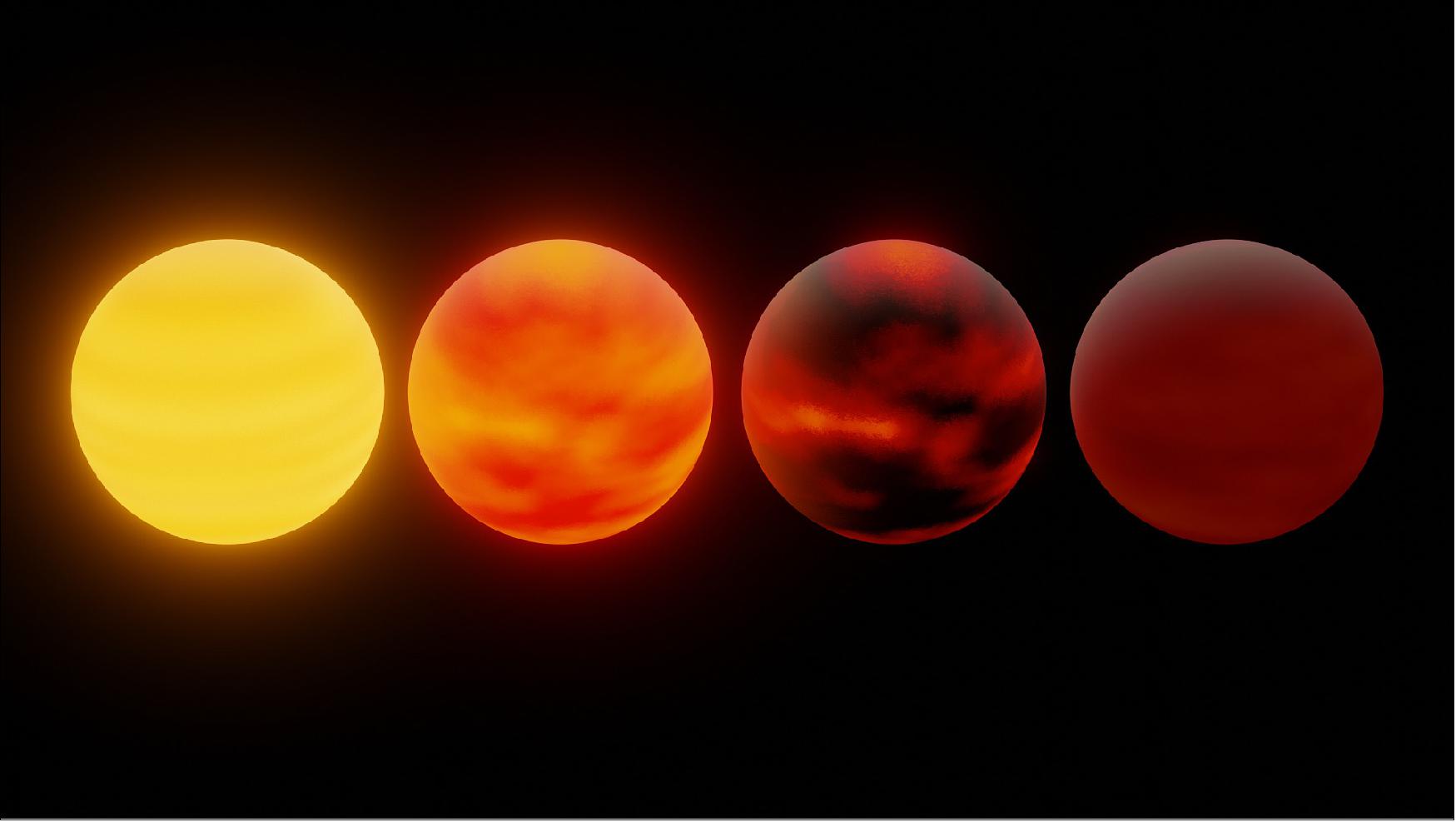
- A new study appearing in the Monthly Notices of the Royal Astronomical Society provides some insight: The research reveals the temperature range at which silicate clouds can form and are visible at the top of a distant planet’s atmosphere. The finding was derived from observations by NASA’s retired Spitzer Space Telescope of brown dwarfs – celestial bodies that fall in between planets and stars – but it fits into a more general understanding of how planetary atmospheres work.
- “Understanding the atmospheres of brown dwarfs and planets where silicate clouds can form can also help us understand what we would see in the atmosphere of a planet that’s closer in size and temperature to Earth,” said Stanimir Metchev, a professor of exoplanet studies at Western University in London, Ontario, and co-author of the study.
Cloudy Chemistry
- The steps to make any type of cloud are the same. First, heat the key ingredient until it becomes a vapor. Under the right conditions, that ingredient could be a variety of things, including water, ammonia, salt, or sulfur. Trap it, cool it just enough for it to condense, and voilà – clouds! Of course, rock vaporizes at a much higher temperature than water, so silicate clouds are visible only on hot worlds, such as the brown dwarfs used for this study and some planets outside our solar system.
- Although they form like stars, brown dwarfs aren’t massive enough to kick-start fusion, the process that causes stars to shine. Many brown dwarfs have atmospheres almost indistinguishable from those of gas-dominated planets, such as Jupiter, so they can be used as a proxy for those planets.
- Before this study, data from Spitzer already suggested the presence of silicate clouds in a handful of brown dwarf atmospheres. (NASA’s James Webb Space Telescope will be able to confirm these types of clouds on distant worlds.) This work was done during the first six years of the Spitzer mission (which launched in 2003), when the telescope was operating three cryogenically cooled instruments. In many cases, though, the evidence of silicate clouds on brown dwarfs observed by Spitzer was too weak to stand on its own.
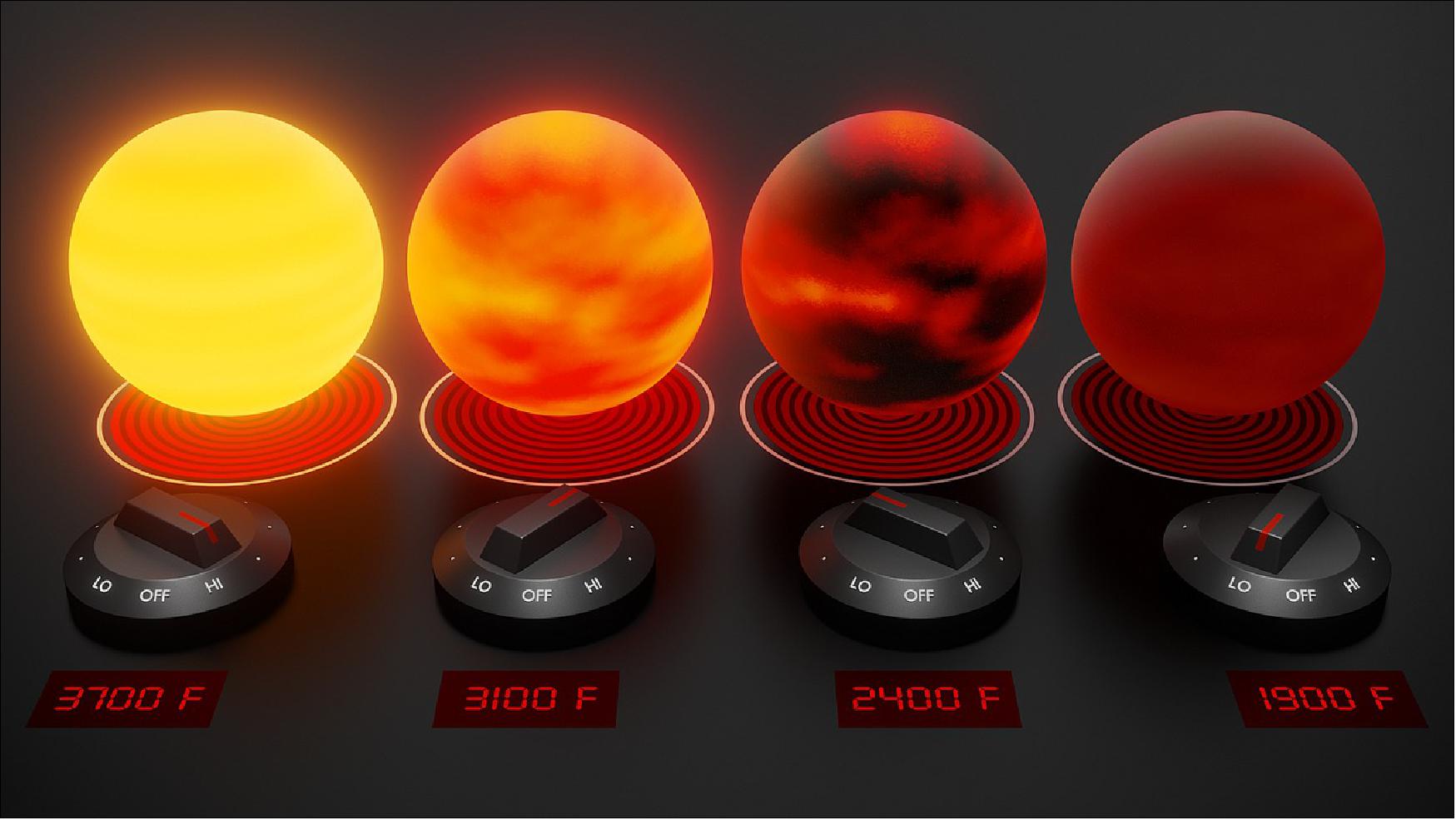
- For this latest research, astronomers gathered more than 100 of those marginal detections and grouped them by the temperature of the brown dwarf. All of them fell within the predicted temperature range for where silicate clouds should form: between about 1,900 degrees Fahrenheit (about 1,000º Celsius) and 3,100 ºF (1,700 ºC). While the individual detections are marginal, together they reveal a definitive trait of silicate clouds.
- “We had to dig through the Spitzer data to find these brown dwarfs where there was some indication of silicate clouds, and we really didn’t know what we would find,” said Genaro Suárez, a postdoctoral researcher at Western University and lead author of the new study. “We were very surprised at how strong the conclusion was once we had the right data to analyze.”
- In atmospheres hotter than the top end of the range identified in the study, silicates remain a vapor. Below the bottom end, the clouds will turn into rain or sink lower in the atmosphere, where the temperature is higher.
- In fact, researchers think that silicate clouds exist deep in Jupiter’s atmosphere, where the temperature is much higher than it is at the top, owing to atmospheric pressure. The silicate clouds can’t rise higher, because at lower temperatures the silicates will solidify and won’t remain in cloud form. If the top of the atmosphere were thousands of degrees hotter, the planet’s ammonia and ammonium hydrosulfide clouds would vaporize and the silicate clouds could potentially rise to the top.
- Scientists are finding an increasingly varied menagerie of planetary environments in our galaxy. For example, they have found planets with one side permanently facing their star and the other permanently in shadow – a planet where clouds of different compositions might be visible, depending on the side observed. To understand those worlds, astronomers will first need to understand the common mechanisms that shape them.
More About the Mission
- The entire body of scientific data collected by Spitzer during its lifetime is available to the public via the Spitzer data archive, housed at the Infrared Science Archive at IPAC at Caltech in Pasadena, California. NASA’s Jet Propulsion Laboratory, a division of Caltech, managed Spitzer mission operations for the agency’s Science Mission Directorate in Washington. Science operations were conducted at the Spitzer Science Center at IPAC at Caltech. Spacecraft operations were based at Lockheed Martin Space in Littleton, Colorado.
• March 18, 2022: Most of the rocky planets and satellites in our solar system, including Earth and the Moon, were formed or shaped by massive collisions early in the solar system’s history. By smashing together, rocky bodies can accumulate more material, increasing in size, or they can break apart into multiple smaller bodies. 4)
- Astronomers using NASA’s now-retired Spitzer Space Telescope have in the past found evidence of these types of collisions around young stars where rocky planets are forming. But those observations didn’t provide many details about the smashups, such as the size of the objects involved.
- Figure 6 shows what a debris cloud around the young star called HD 166191 might look like up close. Astronomers using NASA's now-retired Spitzer Space Telescope saw a debris cloud briefly block the light from that star. The cloud was likely created by a smashup between two large asteroid-sized objects that might be the seeds of future planets around the star.
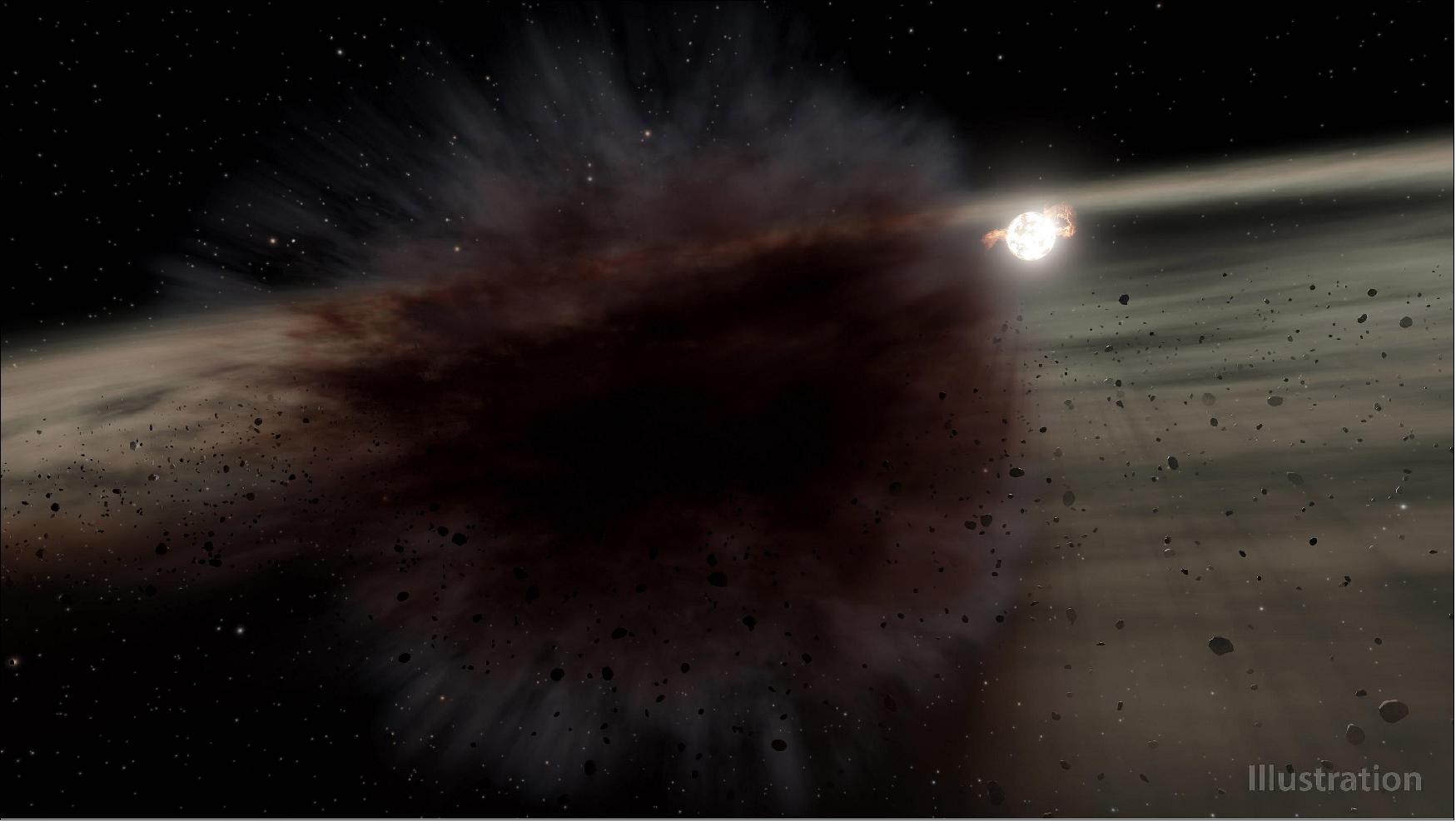
- In a new study in the Astrophysical Journal, a group of astronomers led by Kate Su of the University of Arizona report the first observations of a debris cloud from one of these collisions as it passed in front of its star and briefly blocked the light. Astronomers call this a transit. Coupled with knowledge about the star’s size and brightness, the observations enabled the researchers to directly determine the size of the cloud shortly after impact, estimate the size of the objects that collided, and watch the speed with which the cloud dispersed. 5)
- “There is no substitute for being an eyewitness to an event,” said George Rieke, also at the University of Arizona and a coauthor of the new study. “All the cases reported previously from Spitzer have been unresolved, with only theoretical hypotheses about what the actual event and debris cloud might have looked like.”
- Beginning in 2015, a team led by Su started making routine observations of a 10 million-year-old star called HD 166191. Around this early time in a star’s life, dust left over from its formation has clumped together to form rocky bodies called planetesimals – seeds of future planets. Once the gas that previously filled the space between those objects has dispersed, catastrophic collisions between them become common.
- Anticipating they might see evidence of one of these collisions around HD 166191, the team used Spitzer to conduct more than 100 observations of the system between 2015 and 2019. While the planetesimals are too small and distant to resolve by telescope, their smashups produce large amounts of dust. Spitzer detected infrared light – or wavelengths slightly longer than what human eyes can see. Infrared is ideal for detecting dust, including the debris created by protoplanet collisions.
- In mid-2018, the space telescope saw the HD 166191 system become significantly brighter, suggesting an increase in debris production. During that time, Spitzer also detected a debris cloud blocking the star. Combining Spitzer’s observation of the transit with observations by telescopes on the ground, the team could deduce the size and shape of the debris cloud.
- Their work suggests the cloud was highly elongated, with a minimum estimated area three times that of the star. However, the amount of infrared brightening Spitzer saw suggests only a small portion of the cloud passed in front of the star and that the debris from this event covered an area hundreds of times larger than that of the star.
- To produce a cloud that big, the objects in the main collision must have been the size of dwarf planets, like Vesta in our solar system – an object 330 miles (530 kilometers) wide located in the main asteroid belt between Mars and Jupiter. The initial clash generated enough energy and heat to vaporize some of the material. It also set off a chain reaction of impacts between fragments from the first collision and other small bodies in the system, which likely created a significant amount of the dust Spitzer saw.
- Over the next few months, the large dust cloud grew in size and became more translucent, indicating that the dust and other debris were quickly dispersing throughout the young star system. By 2019, the cloud that passed in front of the star was no longer visible, but the system contained twice as much dust as it had before Spitzer spotted the cloud. This information, according to the paper’s authors, can help scientists test theories about how terrestrial planets form and grow.
- “By looking at dusty debris disks around young stars, we can essentially look back in time and see the processes that may have shaped our own solar system,” said Su. “Learning about the outcome of collisions in these systems, we may also get a better idea of how frequently rocky planets form around other stars.”
• January 13, 2022: The infrared observatory may help answer questions about planets outside our solar system, or exoplanets, including how they form and what drives weather in their atmospheres. 6)
- Two new studies using data from NASA’s retired Spitzer Space Telescope shed light on giant exoplanets and brown dwarfs, objects that aren’t quite stars but aren’t quite planets either. Both studies will be the focus of virtual news conferences hosted by the American Astronomical Society on Jan. 13.
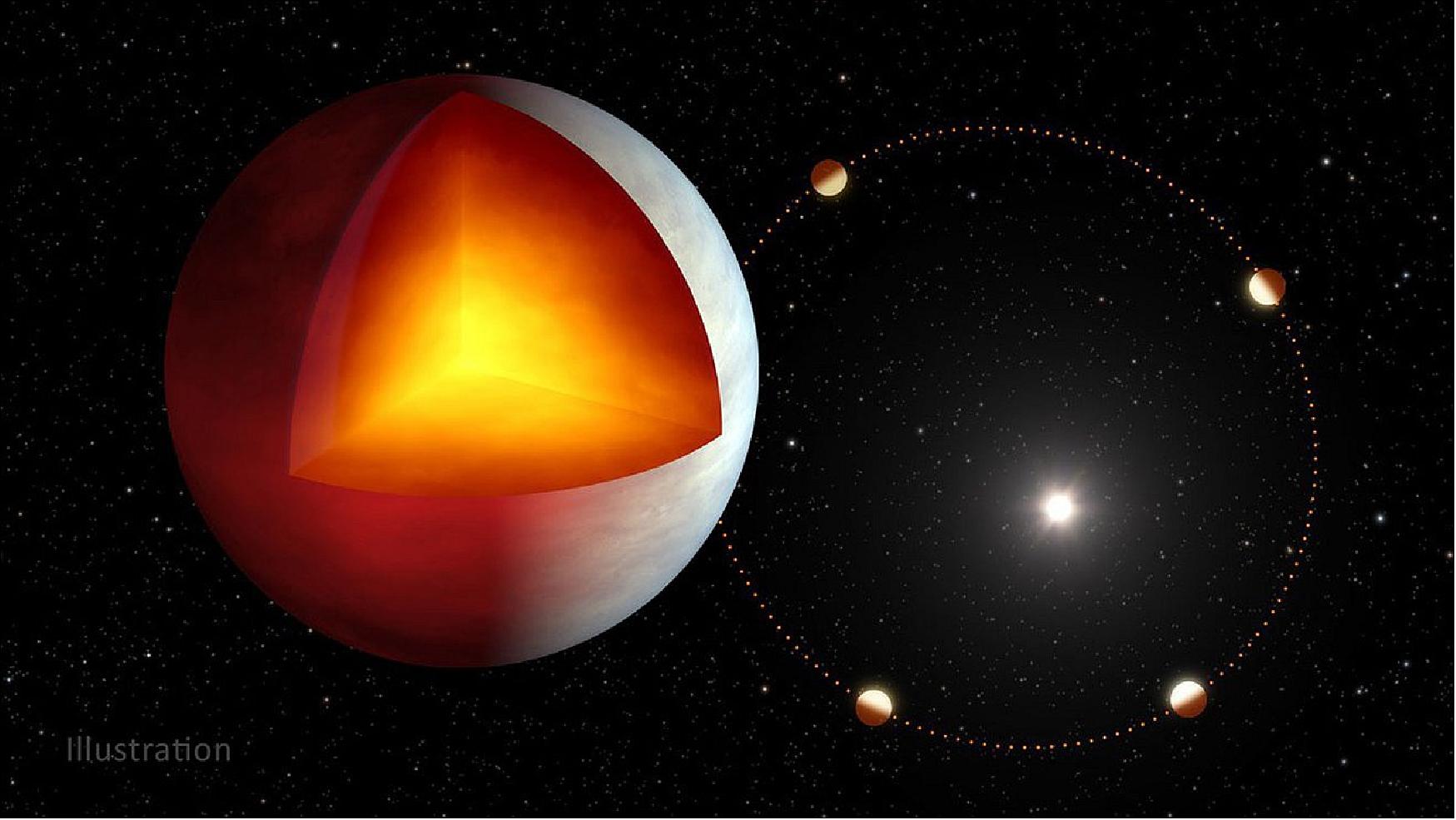
- One investigation shows that the weather on brown dwarfs – which form like stars but don’t have sufficient mass to start burning hydrogen in their cores as stars do – varies with age. Brown dwarfs and giant exoplanets are similar in diameter, mass, and composition, so understanding the atmospheric properties of one can provide insights about those of the other.
- The second study belongs to a body of work looking at hot Jupiters – gas exoplanets that orbit extremely close to their parent stars. How do these massive planets come to be, and could there be subclasses of hot Jupiters with different formation stories? To look for answers, the study authors looked at exoplanet XO-3b, a rare example of a hot Jupiter observed while migrating closer to its host star.
Exoplanet Analogs
- Age often brings stability in humans, and that appears to be true for cosmic objects as well. Johanna Vos, an astrophysicist at the American Museum of Natural History in New York, will discuss a Spitzer survey published in the Astrophysical Journal that found higher variability in the weather on young brown dwarfs compared to old ones.
- With regard to brown dwarfs, the word variability refers to short-term changes in the intensity of different wavelengths of infrared light coming from the object’s atmosphere. Astronomers think these variations are caused by clouds, which reflect and absorb light in the atmosphere.
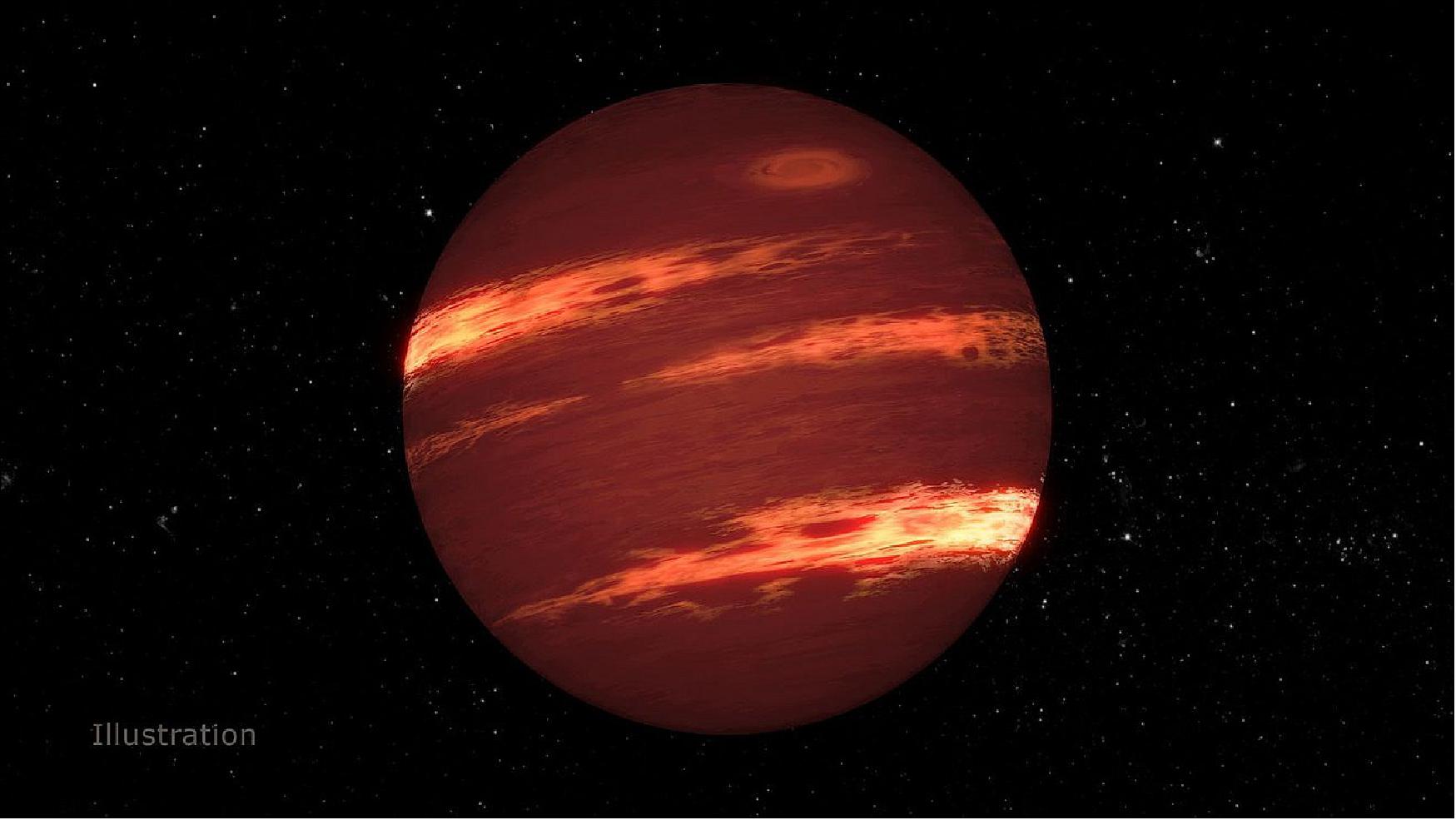
- High variability might indicate a major atmospheric feature, perhaps like Jupiter’s Great Red Spot – a storm larger than Earth that’s been swirling for hundreds of years. It can also indicate a rapidly changing atmosphere, which can have multiple causes such as major temperature differences in the atmosphere or turbulence (sometimes caused by powerful winds).
- Comparing the young brown dwarfs to previous Spitzer observations of older brown dwarfs, the authors found that the young objects are more likely to show atmospheric variation. They also found that variations are larger and more dramatic in younger brown dwarfs. Vos and her colleagues attribute the difference to the fact that brown dwarfs are puffier when they’re young but become more compact as they age, which likely makes the atmosphere appear more uniform.
- Young brown dwarfs are similar in diameter, mass, and composition to giant exoplanets primarily made of gas. But studying large exoplanets is complicated by the close presence of their parent stars: The companion irradiates the planet’s atmosphere, which changes the temperature, or even the chemistry, and affects the weather. The bright light from the star also makes seeing the much fainter planet more difficult.
- Brown dwarfs, on the other hand, can act as a sort of control group and be observed in isolation in space. The study’s authors plan to incorporate the new finding into models of how brown dwarf and giant exoplanet atmospheres evolve with age.
Migrating Giants
- Though hot Jupiters are the most studied type of exoplanet, major questions remain about how they form. For example, do these planets take shape far from their parent stars – at a distance where it’s cold enough for molecules such as water to become solid – or closer? The first scenario fits better with theories about how planets in our own solar system are born, but what would drive these types of planets to migrate so close to their parent stars remains unclear.
- Lisa Dang, an exoplanet scientist at McGill University in Montreal, and her colleagues used Spitzer data to study an exoplanet named XO-3b, which has an eccentric (oval) orbit rather than the circular orbit of almost all other known hot Jupiters. The eccentric orbit indicates XO-3b may have recently migrated toward its parent star; if that’s the case, it will eventually settle into a more circular orbit.
- Observations by Gaia, an ESA (European Space Agency) space observatory, and Spitzer both suggest the planet produces some of its own heat, but scientists don’t know why. The Spitzer data also provides a map of the planet’s climate patterns. It’s possible that the excess warmth is coming from the planet’s interior, through a process called tidal heating. The star’s gravitational squeeze on the planet oscillates as the irregular orbit takes the planet farther and then closer to the star. The resulting changes in interior pressure produce heat.
- For Dang, an unusual hot Jupiter provides an opportunity to test ideas about which formation processes may produce certain characteristics in these exoplanets. For example, could tidal heating in other hot Jupiters also be a sign of recent migration? XO-3b alone won’t solve the mystery, but it serves as an important test for emerging ideas about these scorching giants.
More About the Mission
- The entire body of scientific data collected by Spitzer during its lifetime is available to the public via the Spitzer data archive, housed at the Infrared Science Archive at IPAC at Caltech in Pasadena, California. NASA's Jet Propulsion Laboratory in Southern California managed the Spitzer Space Telescope mission for NASA's Science Mission Directorate in Washington.
- Science operations were conducted at the Spitzer Science Center at IPAC. Spacecraft operations were based at Lockheed Martin Space in Littleton, Colorado.
• October 25, 2021: Just like clouds on Earth, clouds of gas and dust in space can sometimes resemble familiar objects, or even popular movie creatures. 7)
- Do you see a monster in this picture? Do the bright spots near the top of the image look like the piercing eyes and elongated snout of Godzilla?
- In reality, this colorful image shows a nebula – a cloud of gas and dust in space – captured by NASA’s Spitzer Space Telescope. Over billions of years, countless stars have formed in the material there. During their lifetimes, the radiation they release carves away the gas and dust, reshaping the cloud. Major changes also occur when massive stars die and explode, becoming supernovae. When viewed in visible light, the kind human eyes can detect, this region is almost entirely obscured by dust clouds. But infrared light (wavelengths longer than what our eyes can perceive) can penetrate the clouds, revealing hidden regions like this one.
- Four colors (blue, cyan, green, and red) are used to represent different wavelengths of infrared light; yellow and white are combinations of those wavelengths. Blue and cyan represent wavelengths primarily emitted by stars; dust and organic molecules called hydrocarbons appear green; and warm dust that’s been heated by stars or supernovae appears red.
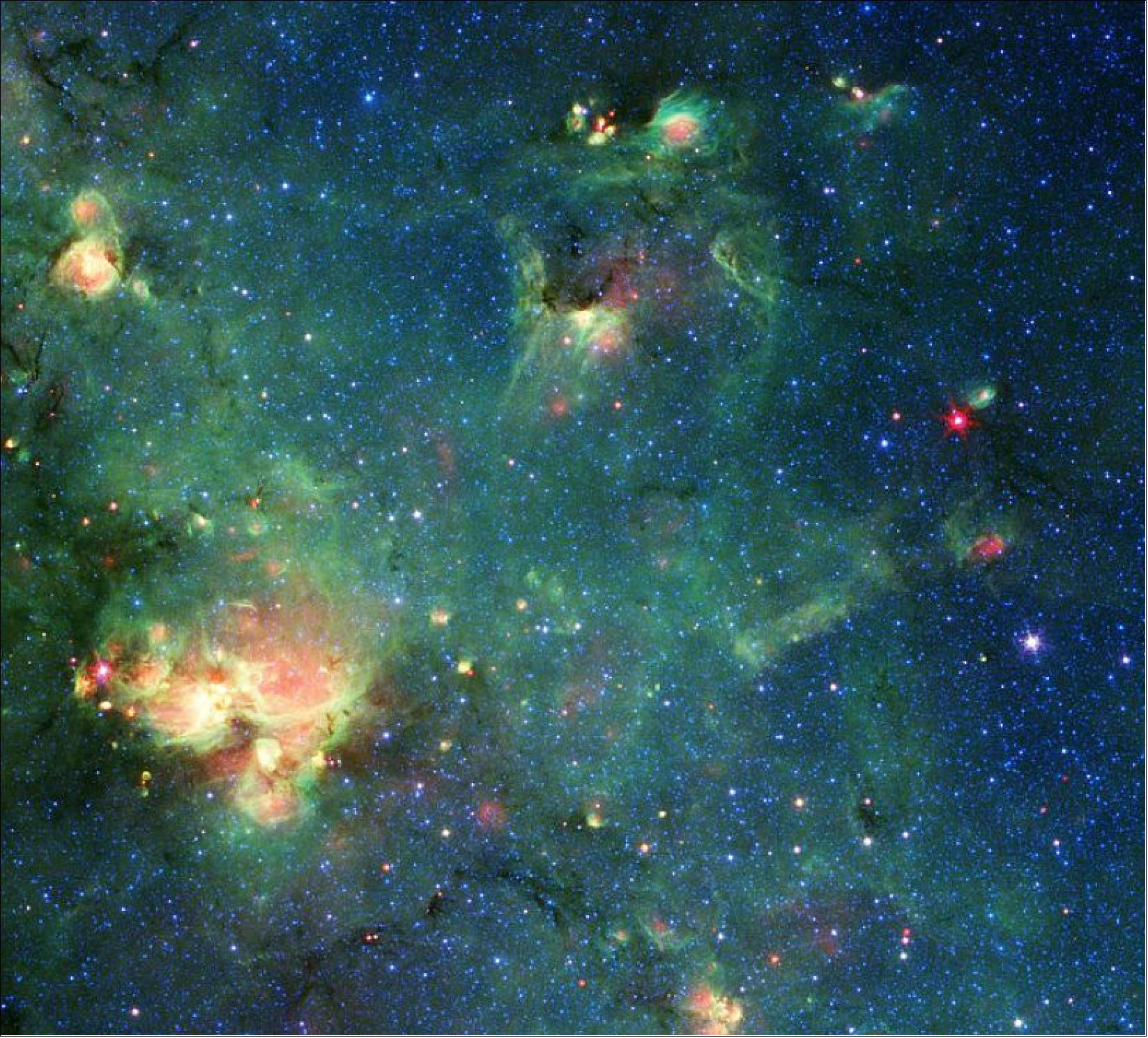
- This image was processed by Caltech astronomer Robert Hurt, who is responsible for the vast majority of public images created from Spitzer data since the observatory’s launch in 2003. Hurt is also the one who spotted Godzilla in the image.
- “I wasn’t looking for monsters,” he said. “I just happened to glance at a region of sky that I’ve browsed many times before, but I’d never zoomed in on. Sometimes if you just crop an area differently, it brings out something that you didn’t see before. It was the eyes and mouth that roared ‘Godzilla’ to me.”
- Hurt isn’t alone in his tendency to see Earth-bound objects in pictures of the cosmos. Pareidolia is the scientific name for the human tendency to perceive a specific, often meaningful image in a random or ambiguous visual pattern. Other scientists have spied a black widow spider, a Jack-o-Lantern, a snake, an exposed human brain, and the Starship Enterprise, among other things, in Spitzer images.
- Managed by NASA’s Jet Propulsion Laboratory in Southern California, the Spitzer spacecraft was retired in January 2020, but scientists continue to mine its massive dataset for new information about the universe. And Hurt continues to look for engaging images.
- “It’s one of the ways that we want people to connect with the incredible work that Spitzer did,” he said. “I look for compelling areas that can really tell a story. Sometimes it’s a story about how stars and planets form, and sometimes it’s about a giant monster rampaging through Tokyo.”
- The Godzilla-like nebula is located is in the constellation Sagittarius, along the plane of the Milky Way, which was part of Spitzer’s GLIMPSE Survey (Galactic Legacy Infrared Mid-Plane Survey Extraordinaire). Stars in the upper right (where this cosmic Godzilla’s eyes and snout would be) are an unknown distance from Earth but within our galaxy. Located about 7,800 light-years from Earth, the bright region in the lower left (Godzilla’s right hand) is known as W33.
- Not convinced this dramatic star-forming region looks like Godzilla? You can draw your own cosmic creature with the Spitzer Artistronomy web app. New nebulae, including this one, were added to the app this month. The app features drawing tools and pictures of nine nebulae captured by Spitzer, so users can illustrate their own visions of cosmic creatures. Spitzer’s infrared view of the universe made it particularly apt at finding nebulae that were too cold to radiate visible light, or those that were hidden behind dust clouds.
- The entire body of scientific data collected by Spitzer during its lifetime is available to the public via the Spitzer data archive, housed at the Infrared Science Archive at IPAC at Caltech in Pasadena, California. JPL, a division of Caltech, managed Spitzer mission operations for NASA's Science Mission Directorate in Washington. Science operations were conducted at the Spitzer Science Center at IPAC at Caltech. Spacecraft operations were based at Lockheed Martin Space in Littleton, Colorado.
• August 17, 2021: Scientists have spotted a previously unrecognized feature of our Milky Way galaxy: A contingent of young stars and star-forming gas clouds is sticking out of one of the Milky Way’s spiral arms like a splinter poking out from a plank of wood. Stretching some 3,000 light-years, this is the first major structure identified with an orientation so dramatically different than the arm’s. 8)
- Astronomers have a rough idea of the size and shape of the Milky Way’s arms, but much remains unknown: They can’t see the full structure of our home galaxy because Earth is inside it. It’s akin to standing in the middle of Times Square and trying to draw a map of the island of Manhattan. Could you measure distances precisely enough to know if two buildings were on the same block or a few streets apart? And how could you hope to see all the way to the tip of the island with so many things in your way?
- To learn more, the authors of the new study focused on a nearby portion of one of the galaxy’s arms, called the Sagittarius Arm. Using NASA’s Spitzer Space Telescope prior to its retirement in January 2020, they sought out newborn stars, nestled in the gas and dust clouds (called nebulae) where they form. Spitzer detects infrared light that can penetrate those clouds, while visible light (the kind human eyes can see) is blocked. 9)
- Young stars and nebulae are thought to align closely with the shape of the arms they reside in. To get a 3D view of the arm segment, the scientists used the latest data release from the ESA (European Space Agency) Gaia mission to measure the precise distances to the stars. The combined data revealed that the long, thin structure associated with the Sagittarius Arm is made of young stars moving at nearly the same velocity and in the same direction through space.
- “A key property of spiral arms is how tightly they wind around a galaxy,” said Michael Kuhn, an astrophysicist at Caltech and lead author of the new paper. This characteristic is measured by the arm’s pitch angle. A circle has a pitch angle of 0 degrees, and as the spiral becomes more open, the pitch angle increases. “Most models of the Milky Way suggest that the Sagittarius Arm forms a spiral that has a pitch angle of about 12 degrees, but the structure we examined really stands out at an angle of nearly 60 degrees.”
- Similar structures – sometimes called spurs or feathers – are commonly found jutting off the arms of other spiral galaxies. For decades scientists have wondered whether our Milky Way’s spiral arms are also dotted with these structures or if they are relatively smooth.
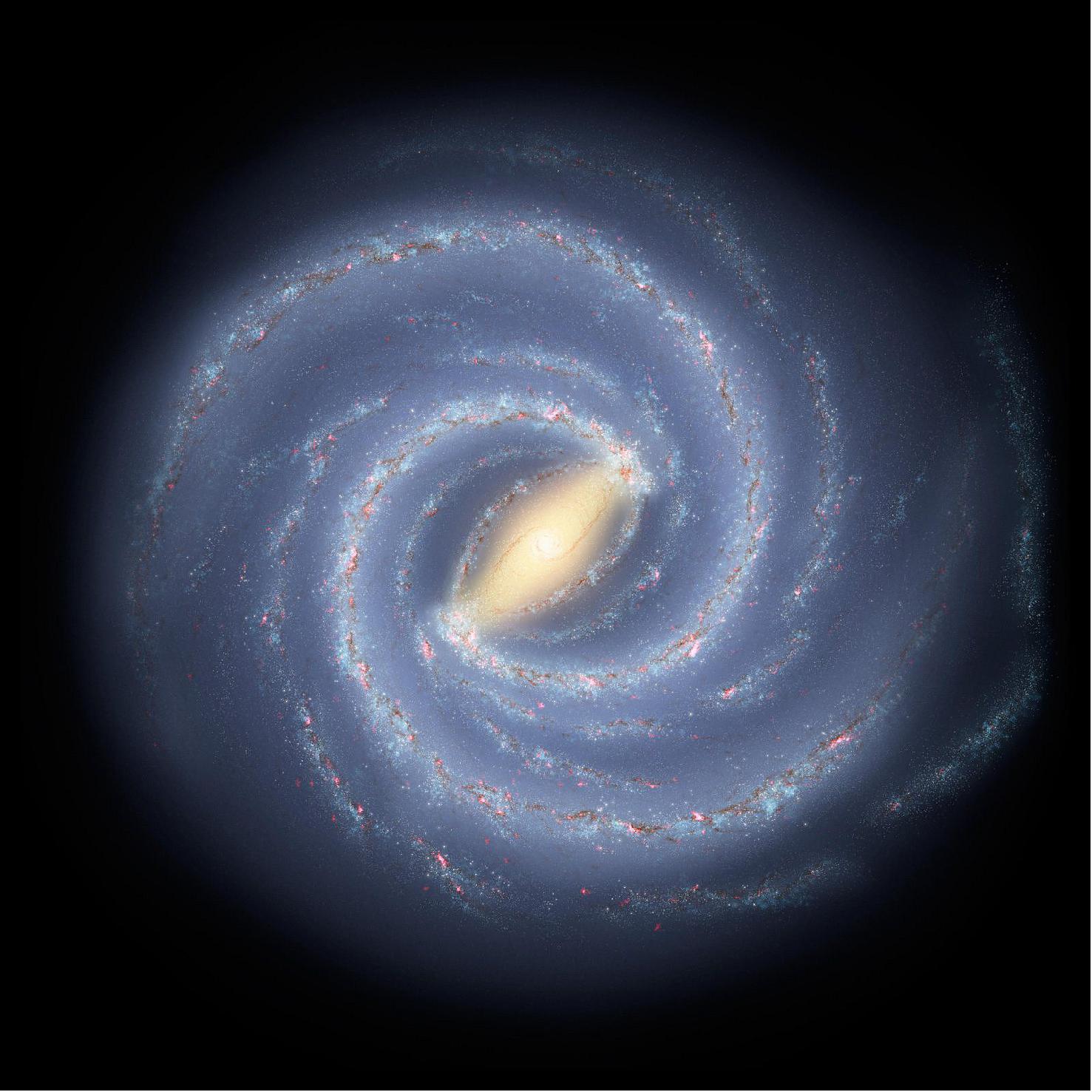
Measuring the Milky Way
- The newly discovered feature contains four nebulae known for their breathtaking beauty: the Eagle Nebula (which contains the Pillars of Creation), the Omega Nebula, the Trifid Nebula, and the Lagoon Nebula. In the 1950s, a team of astronomers made rough distance measurements to some of the stars in these nebulae and were able to infer the existence of the Sagittarius Arm. Their work provided some of the first evidence of our galaxy’s spiral structure.
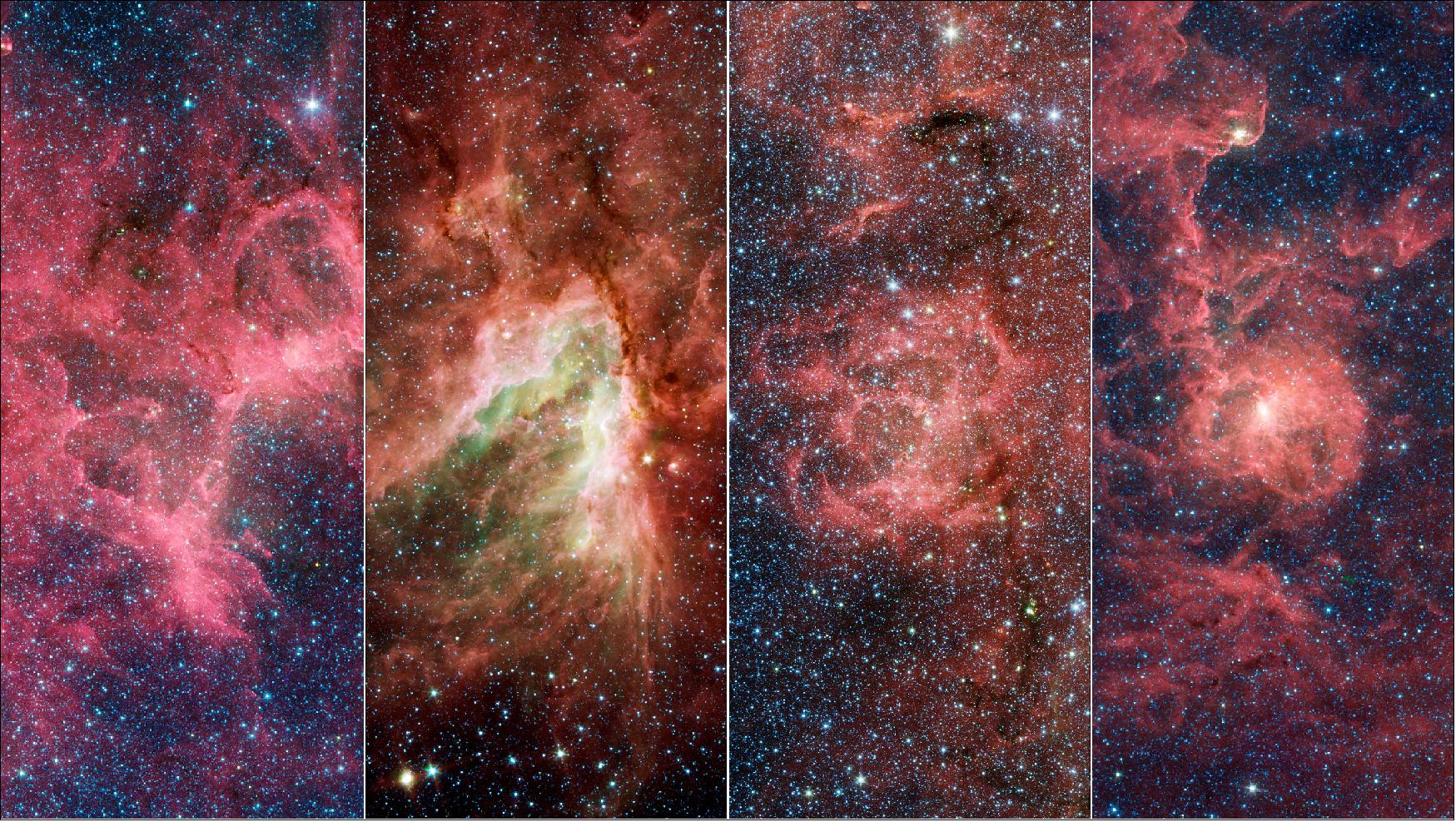
- “Distances are among the most difficult things to measure in astronomy,” said co-author Alberto Krone-Martins, an astrophysicist and lecturer in informatics at the University of California, Irvine and a member of the Gaia Data Processing and Analysis Consortium (DPAC). “It is only the recent, direct distance measurements from Gaia that make the geometry of this new structure so apparent.”
- In the new study, researchers also relied on a catalog of more than a hundred thousand newborn stars discovered by Spitzer in a survey of the galaxy called the Galactic Legacy Infrared Mid-Plane Survey Extraordinaire (GLIMPSE).
- “When we put the Gaia and Spitzer data together and finally see this detailed, three-dimensional map, we can see that there’s quite a bit of complexity in this region that just hasn’t been apparent before,” said Kuhn.
- Astronomers don’t yet fully understand what causes spiral arms to form in galaxies like ours. Even though we can’t see the Milky Way’s full structure, the ability to measure the motion of individual stars is useful for understanding this phenomenon: The stars in the newly discovered structure likely formed around the same time, in the same general area, and were uniquely influenced by the forces acting within the galaxy, including gravity and shear due to the galaxy’s rotation.
- “Ultimately, this is a reminder that there are many uncertainties about the large-scale structure of the Milky Way, and we need to look at the details if we want to understand that bigger picture,” said one the paper’s co-authors, Robert Benjamin, an astrophysicist at the University of Wisconsin-Whitewater and a principal investigator on the GLIMPSE survey. “This structure is a small piece of the Milky Way, but it could tell us something significant about the Galaxy as a whole.”
More About the Mission
- The Gaia spacecraft operations team works from the European Space Operations Centre (ESOC) in Germany, while the science operations are performed at the European Space Astronomy Centre (ESAC) in Spain. A consortium of more than 400 scientists and engineers are responsible for the processing of the data. -More information on the Gaia Data Releases can be found here: https://www.cosmos.esa.int/web/gaia/release
• August 4, 2021: Exploding stars generate dramatic light shows. Infrared telescopes like Spitzer can see through the haze and to give a better idea of how often these explosions occur. 10)
- You’d think that supernovae – the death throes of massive stars and among the brightest, most powerful explosions in the universe – would be hard to miss. Yet the number of these blasts observed in the distant parts of the universe falls way short of astrophysicists’ predictions.
- A new study using data from NASA’s recently retired Spitzer Space Telescope reports the detection of five supernovae that, going undetected in optical light, had never been seen before. Spitzer saw the universe in infrared light, which pierces through dust clouds that block optical light – the kind of light our eyes see and that unobscured supernovae radiate most brightly. 11)
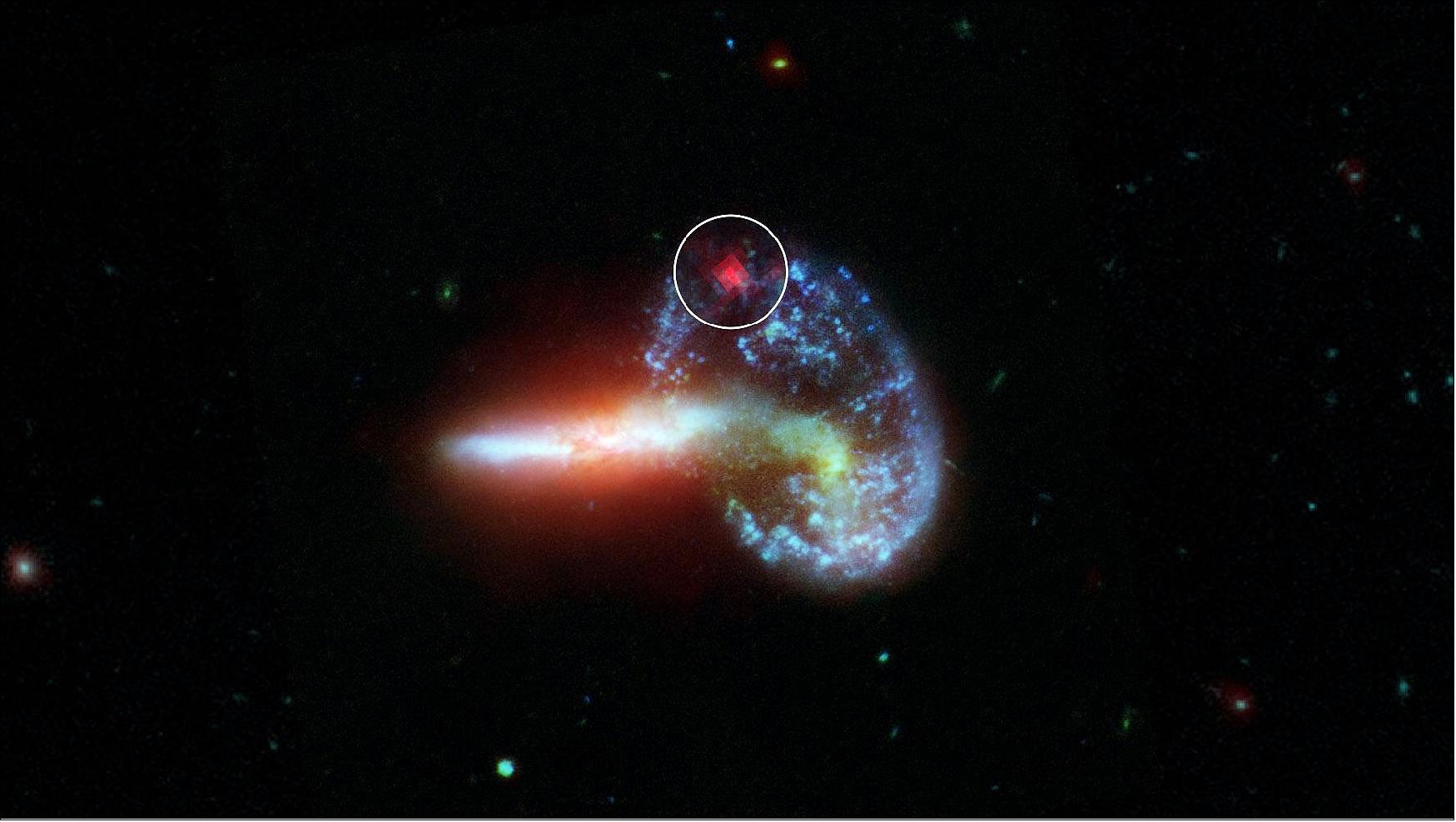
- To search for hidden supernovae, the researchers looked at Spitzer observations of 40 dusty galaxies. (In space, dust refers to grain-like particles with a consistency similar to smoke.) Based on the number they found in these galaxies, the study confirms that supernovae do indeed occur as frequently as scientists expect them to. This expectation is based on scientists’ current understanding of how stars evolve. Studies like this are necessary to improve that understanding, by either reinforcing or challenging certain aspects of it.
- “These results with Spitzer show that the optical surveys we’ve long relied on for detecting supernovae miss up to half of the stellar explosions happening out there in the universe,” said Ori Fox, a scientist at the Space Telescope Science Institute in Baltimore, Maryland, and lead author of the new study, published in the Monthly Notices of the Royal Astronomical Society. “It’s very good news that the number of supernovae we’re seeing with Spitzer is statistically consistent with theoretical predictions.”
- The “supernova discrepancy” – that is, the inconsistency between the number of predicted supernovae and the number observed by optical telescopes – is not an issue in the nearby universe. There, galaxies have slowed their pace of star formation and are generally less dusty. In the more distant reaches of the universe, though, galaxies appear younger, produce stars at higher rates, and tend to have higher amounts of dust. This dust absorbs and scatters optical and ultraviolet light, preventing it from reaching telescopes. So researchers have long reasoned that the missing supernovae must exist and are just unseen.
- “Because the local universe has calmed down a bit since its early years of star-making, we see the expected numbers of supernovae with typical optical searches,” said Fox. “The observed supernova-detection percentage goes down, however, as you get farther away and back to cosmic epochs where dustier galaxies dominated.”
- Detecting supernovae at these far distances can be challenging. To perform a search for supernovae shrouded within murkier galactic realms but at less extreme distances, Fox’s team selected a local set of 40 dust-choked galaxies, known as luminous and ultra-luminous infrared galaxies (LIRGs and ULIRGs, respectively). The dust in LIRGs and ULIRGs absorbs optical light from objects like supernovae but allows infrared light from these same objects to pass through unobstructed for telescopes like Spitzer to detect.
- The researchers’ hunch proved correct when the five never-before-seen supernovae came to (infrared) light. “It’s a testament to Spitzer’s discovery potential that the telescope was able to pick up the signal of hidden supernovae from these dusty galaxies,” said Fox.
- “It was especially fun for several of our undergraduate students to meaningfully contribute to this exciting research,” added study co-author Alex Filippenko, a professor of astronomy at the University of California, Berkeley. “They helped answer the question, ‘Where have all the supernovae gone?’”
- The types of supernovae detected by Spitzer are known as “core-collapse supernovae,” involving giant stars with at least eight times the mass of the Sun. As they grow old and their cores fill with iron, the big stars can no longer produce enough energy to withstand their own gravity, and their cores collapse, suddenly and catastrophically.
- The intense pressures and temperatures produced during the rapid cave-in forms new chemical elements via nuclear fusion. The collapsing stars ultimately rebound off their ultra-dense cores, blowing themselves to smithereens and scattering those elements throughout space. Supernovae produce “heavy” elements, such as most metals. Those elements are necessary for building up rocky planets, like Earth, as well as biological beings. Overall, supernova rates serve as an important check on models of star formation and the creation of heavy elements in the universe.
- “If you have a handle on how many stars are forming, then you can predict how many stars will explode,” said Fox. “Or, vice versa, if you have a handle on how many stars are exploding, you can predict how many stars are forming. Understanding that relationship is critical for many areas of study in astrophysics.”
- Next-generation telescopes, including NASA’s Nancy Grace Roman Space Telescope and the James Webb Space Telescope, will detect infrared light, like Spitzer.
- “Our study has shown that star formation models are more consistent with supernova rates than previously thought,” said Fox. “And by revealing these hidden supernovae, Spitzer has set the stage for new kinds of discoveries with the Webb and Roman space telescopes.”
The 75th anniversary of the publication that paved the way for space telescopes 12)
• July 30, 2021: Seventy-five years ago, astronomer Lyman Spitzer envisioned a future for space exploration that deepened humanity’s curiosity about the cosmos. A visionary behind the Hubble Space Telescope, Spitzer was among the earliest astronomers pioneering a revolutionary way to explore the universe through astronomical satellites. His vision came over a decade before the launch of the first satellite, Sputnik, as well as the establishment of NASA itself. While the fundamental concept of sending a large telescope into space wasn’t new, the reality of doing so was.
With the publication of his famed paper in 1946, “Astronomical Advantages of an Extra-terrestrial Observatory,” Spitzer explored the benefits and feasibility of launching a large reflecting telescope into orbit around our planet. He wrote that by operating above Earth’s atmosphere, space telescopes would have greater access to wavelengths of light not visible from the ground. They could also take higher quality images.
Ultraviolet and infrared light from space are mostly absorbed by Earth’s atmosphere, making it virtually impossible to observe these wavelengths from ground-based telescopes. In addition to blocking certain light, atmospheric turbulence that circulates air throughout the atmosphere can have a serious impact on the quality of ground-based telescope images. Placing large telescopes above Earth’s atmosphere eliminates these limitations, allowing the observatories to operate at their full capabilities.
With his proposal, Spitzer made a strong case for large space telescopes that would allow humanity to access unimagined parts of the universe. Understanding the magnitude of the universe and exploring the structures of galaxies, globular star clusters, and other planets in the cosmos were the ultimate goals of extraterrestrial observatories.
Spitzer’s vision in 1946 marked a new era for the field of astronomy. Now, 75 years later, space-based telescopes are our biggest window to the cosmos. Above Earth’s atmosphere, we are able to see billions of light-years back in time, helping us understand the evolution of galaxies and the universe itself. This unimpeded view of our universe paved the way for telescopes like Hubble to discover myriad galaxies beyond our own, enabled us to see celestial objects and phenomena through light invisible to the human eye, and offered us a new perspective of our place in the universe.
As noted by Spitzer in his report, the primary contribution of orbital astronomical observatories would be to enable humanity to explore beyond our frontier of knowledge; “not to supplement our present ideas of the universe we live in, but rather to uncover new phenomena not yet imagined, and perhaps to modify profoundly our basic concepts of space and time."
NASA named the Spitzer Space Telescope after Lyman Spitzer, who died in 1997. The infrared observatory, which operated from 2003 to 2020, indeed made discoveries about our solar system and beyond that the original mission team never anticipated. Its accomplishments included a map of the Milky Way, the discovery of a ring around Saturn, and the revelation that there are seven rocky, Earth-size planets encircling a small star called TRAPPIST-1.
Spitzer’s legacy lives on in all of NASA’s satellites, especially Hubble, which he personally worked to establish. To this day, the Hubble Space Telescope remains a testament to Spitzer’s vision and a reminder of what is yet to be discovered.
• July 26, 2021: Among the first, and strangest, planets to be detected around other stars is a variety known as “hot Jupiters” – star-hugging, superheated giants once thought so unlikely that many scientists doubted their existence. 13)
- But 25 years later, hot Jupiters have been confirmed across the galaxy and even in our stellar neighborhood. Now a survey using data from NASA’s Spitzer Space Telescope, switched off in 2020, is teasing out important features of hot Jupiter atmospheres and providing a few surprises for scientists.
- Spitzer’s parting gift also offers a glimmer of the future – a coming revolution in our understanding of exoplanets, the worlds orbiting other stars.
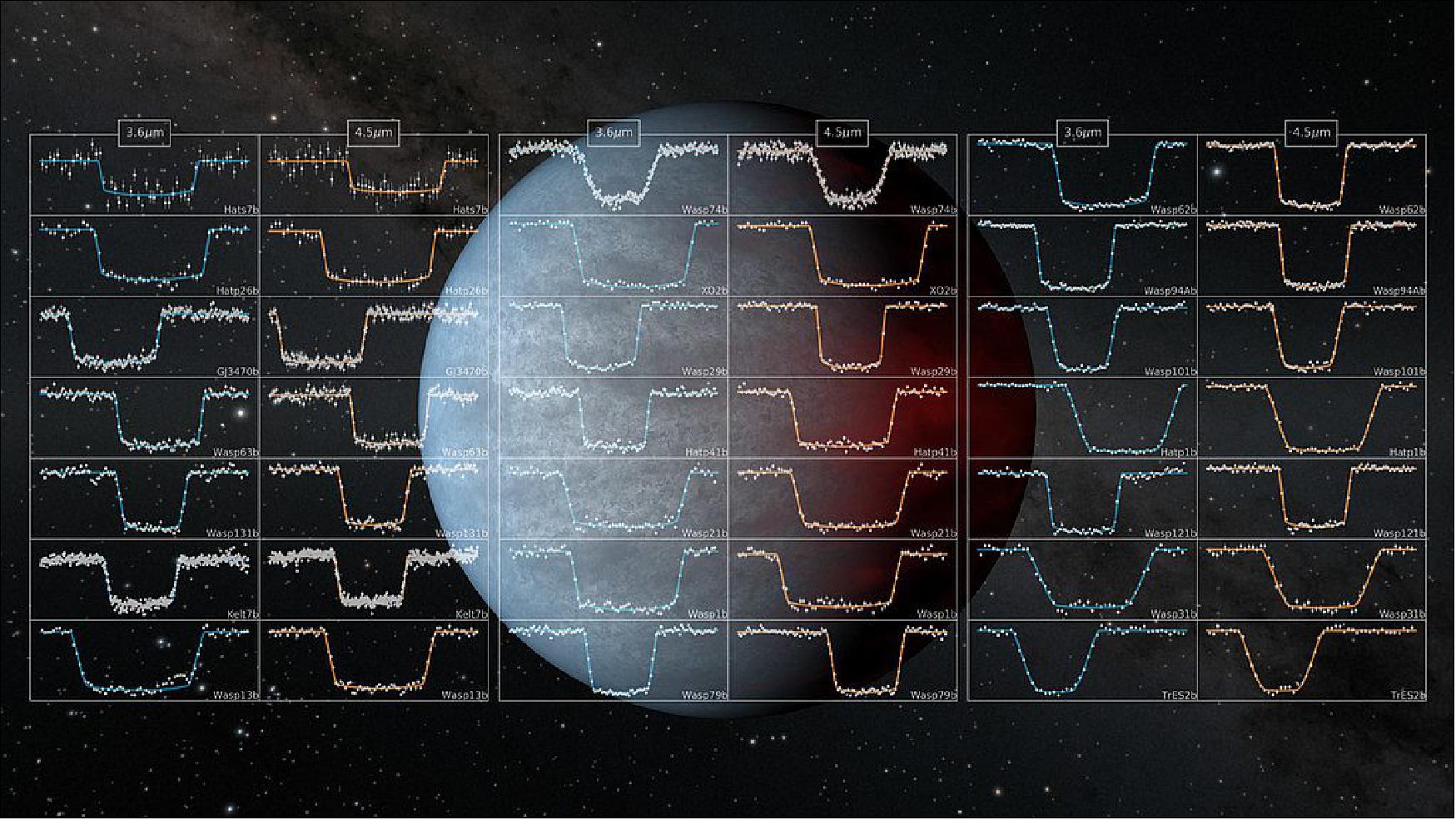
- Measurements of the temperature and chemical properties of hot Jupiters, and how these affect their cauldron-like atmospheres, were made by gathering light from the infrared part of the spectrum – the “heat maps” that were Spitzer’s specialty.
- Far more detailed observations in the same tradition are expected from the James Webb Space Telescope, which will launch in 2021, and other instruments to come in the decades ahead.
- “To me, the transition is going from more than 15 years of exoplanetary science with Spitzer to a new era,” said Jean-Michel Desert, an astronomer at the University of Amsterdam and a co-author of the new study. “The legacy of Spitzer for the future – that to me is the key moment.”
Families of Planets
- Hot Jupiters are gas giants, in some ways similar to our own Jupiter in terms of mass and size, but with far higher temperatures. They orbit their stars so tightly that a “year” – once around the star – can take just a few days. This short orbital leash keeps them infernally hot.
- Astronomers have found more than 700 so far in our galaxy – so many that they now have been able to conduct the largest statistical survey of these extreme planets using Spitzer data.
- The new study, involving 49 hot Jupiters – chosen in part because molecular signatures in their atmospheres could be measured more precisely – begins to reveal trends and commonalities in an entire population.
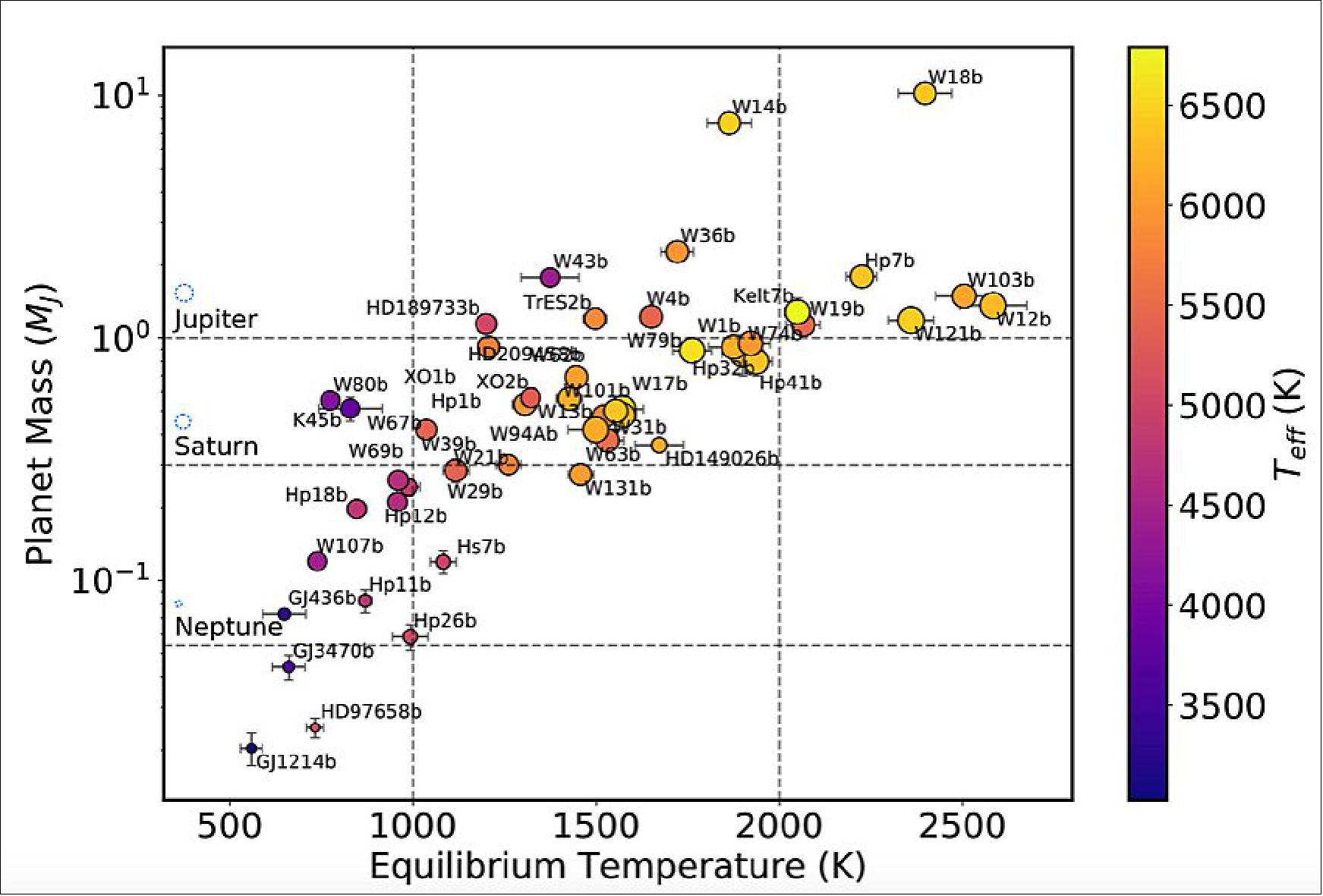
- ”Hot Jupiters – all of them are quite peculiar,” Desert said. “But we do see families of [these] exoplanets.”
- They seem to group into three families, the science team found: the “cooler” hot Jupiters, with atmospheric temperatures up to about 1,300º Fahrenheit (700º Celsius), “hot” hot Jupiters, from about 1,300º to 3,100º Fahrenheit (700º to 1,700º Celsius), and ultra-hot Jupiters, those above 3,100º Fahrenheit (1,700º Celsius).
- The most unexpected finding for scientists who study these behemoths: Among the cooler hot Jupiters, no trace of methane was seen in their atmospheres.
- Computer models – simulations of hot Jupiter atmospheres – that are calculated using common scientific assumptions predicted methane in abundance for these worlds. The gas is present in small amounts in the atmosphere of our own (non-hot) Jupiter and plentiful in the gas giants Uranus and Neptune.
- “We saw that some atmospheres behave differently compared to the [simpler models],” lead author Claire Baxter, also of the University of Amsterdam, wrote in an email. “To not find methane in any of the planets [at temperatures lower than about 1,300 degrees Fahrenheit] was surprising with the basic assumptions we had made.”
- A few papers in previous years suggested a lack of methane on these planets, Desert said, but the question was whether these were anomalies or not. The new studies show, instead, that lack of methane at the cool end of the hot Jupiter spectrum is a widespread character trait.
- “We know that simple models can’t match the data, and that we have to include more accurate physics into those basic models,” Desert said.
- Another important result among the ultra-hot Jupiters is the evidence of vertical mixing in their atmospheres. Carbon monoxide and methane are stirred together on these planets, as interpreted from Spitzer data, with the strongest mixing on the hottest planets. Such a stew is best explained by mixing of the atmosphere’s upper and lower regions.
- “Seeing the evidence for vertical mixing in a statistical sense is an important step because it is predicted by models and was also previously seen in brown dwarfs [a kind of failed star],” Baxter wrote. “Now we have collected evidence that this effect is also seen in exoplanet atmospheres.”
A Chip Off the Old Parent Star
- A third finding helps improve understanding of a long-running mystery. Some previous analyses suggested that hot Jupiters might have a higher metal content than their stars, which would be difficult to explain.
- But the Spitzer data from the new survey appears to put that concern in a different light. The Spitzer observations fit the picture of planets with about the same chemical composition as their stars, which would be expected from planets and stars that formed from the same protoplanetary disk.
- As in most families, the various members of the hot Jupiter groups have plenty of individual quirks, while still maintaining close relations.
- “We’re not necessarily claiming we’re the first to see diversity [among hot Jupiters],” Desert said. “What is nice is that we see it statistically, looking at 50 objects that we’ve analyzed and interpreted in a systematic way.”
- And while the Webb telescope and its successors will be able to analyze the atmospheres of individual planets more deeply, another broad survey of hot Jupiters – analyzing a large population to find common characteristics – might not be possible in the immediate future. The European Space Agency’s ARIEL mission, which will carry the CASE instrument developed by NASA’s Jet Propulsion Laboratory and is expected to launch in 2029, is designed to conduct a broad-scale survey of exoplanet atmospheres.
- The new study, in a way, also brings the retired Spitzer Space Telescope full circle. One of the earliest news releases issued about Spitzer’s discoveries, in 2005, involved its capturing of infrared light from two hot Jupiters – a “first” at the time.
- That also was hailed as the start of a new era in planetary science.
- The extensive data collected by Spitzer continues to yield discoveries, but the baton is being passed to a new generation of more powerful infrared instruments. They will seek to unravel more mysteries, perhaps including the formation of small, rocky, potentially habitable worlds like our own.
- “Our work is the result of the huge efforts of Spitzer in the field of exoplanet science over the last 15 years,” Baxter wrote. “Our work will serve as a benchmark for infrared studies in the future of exoplanet science. It allows us to understand planetary atmospheres in a broad context, which helps us understand planet formation and evolution.”
• January 22, 2021: Precise measurements reveal that the exoplanets have remarkably similar densities, which provides clues about their composition. 14)
- The red dwarf star TRAPPIST-1 is home to the largest group of roughly Earth-size planets ever found in a single stellar system. Located about 40 light-years away, these seven rocky siblings provide an example of the tremendous variety of planetary systems that likely fill the universe.
![Figure 16: Measuring the mass and diameter of a planet reveals its density, which can give scientists clues about its composition. Scientists now know the density of the seven TRAPPIST-1 planets with a higher precision than any other planets in the universe, other than those in our own solar system [image credit: NASA/JPL-Caltech/R. Hurt (IPAC)]](https://www.eoportal.org/ftp/satellite-missions/s/Spitzer_080722/Spitzer_Auto14.jpeg)
- A new study published today in the Planetary Science Journal shows that the TRAPPIST-1 planets have remarkably similar densities. That could mean they all contain about the same ratio of materials thought to compose most rocky planets, like iron, oxygen, magnesium, and silicon. But if this is the case, that ratio must be notably different than Earth’s: The TRAPPIST-1 planets are about 8% less dense than they would be if they had the same makeup as our home planet. Based on that conclusion, the paper authors hypothesized a few different mixtures of ingredients could give the TRAPPIST-1 planets the measured density.
- Some of these planets have been known since 2016, when scientists announced that they’d found three planets around the TRAPPIST-1 star using the Transiting Planets and Planetesimals Small Telescope (TRAPPIST) in Chile. Subsequent observations by NASA’s now-retired Spitzer Space Telescope, in collaboration with ground-based telescopes, confirmed two of the original planets and discovered five more. Managed by NASA’s Jet Propulsion Laboratory in Southern California, Spitzer observed the system for over 1,000 hours before being decommissioned in January 2020. NASA’s Hubble and now-retired Kepler space telescopes have also studied the system.
- All seven TRAPPIST-1 planets, which are so close to their star that they would fit within the orbit of Mercury, were found via the transit method: Scientists can’t see the planets directly (they’re too small and faint relative to the star), so they look for dips in the star’s brightness created when the planets cross in front of it.
- Repeated observations of the starlight dips combined with measurements of the timing of the planets’ orbits enabled astronomers to estimate the planets’ masses and diameters, which were in turn used to calculate their densities. Previous calculations determined that the planets are roughly the size and mass of Earth and thus must also be rocky, or terrestrial – as opposed to gas-dominated, like Jupiter and Saturn. The new paper offers the most precise density measurements yet for any group of exoplanets – planets beyond our solar system.
Iron’s Reign
- The more precisely scientists know a planet’s density, the more limits they can place on its composition. Consider that a paperweight might be about the same size as a baseball yet is usually much heavier. Together, width and weight reveal each object’s density, and from there it is possible to infer that the baseball is made of something lighter (string and leather) and the paperweight is made of something heavier (usually glass or metal).
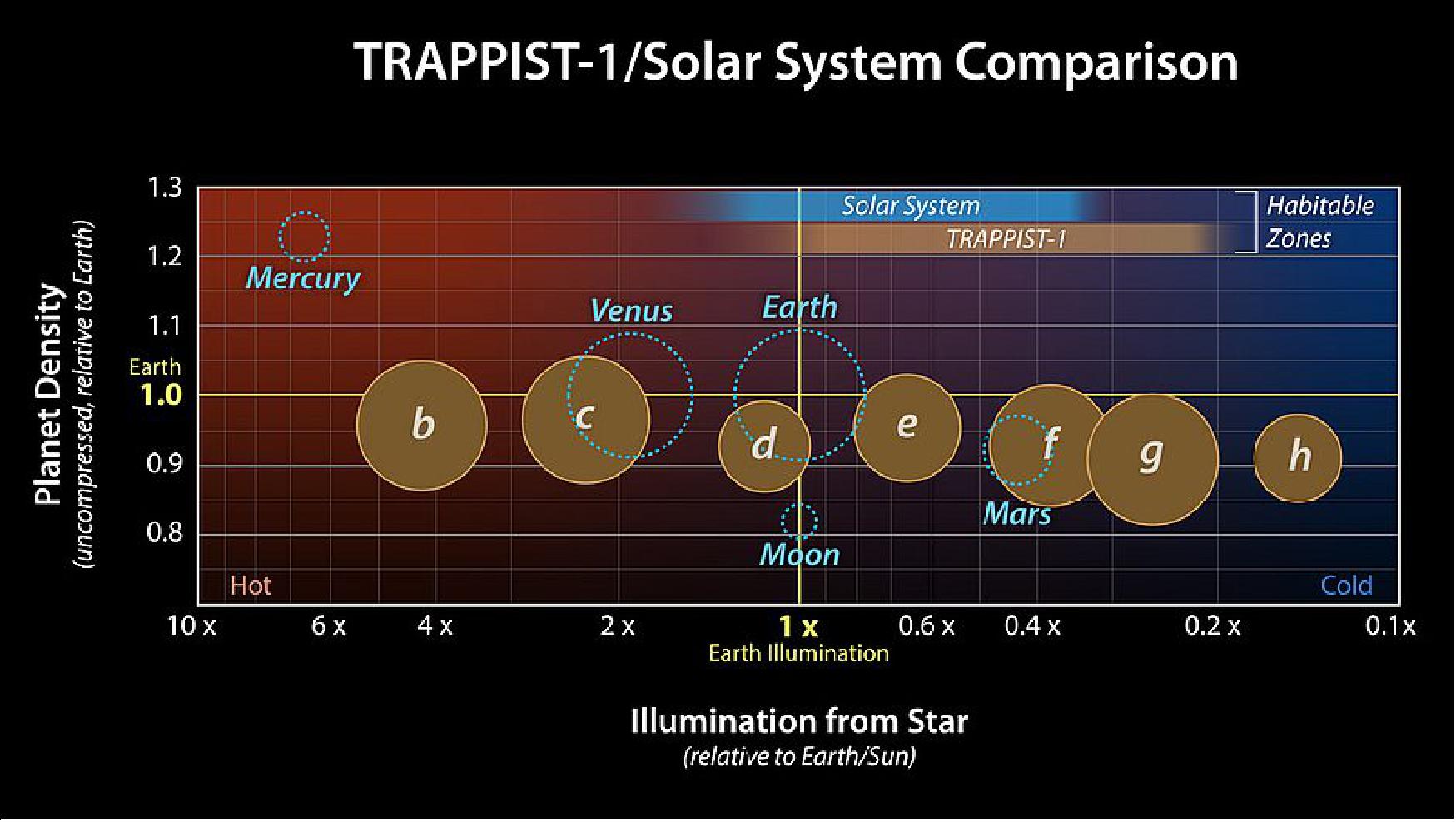
- The densities of the eight planets in our own solar system vary widely. The puffy, gas-dominated giants – Jupiter, Saturn, Uranus, and Neptune – are larger but much less dense than the four terrestrial worlds because they’re composed mostly of lighter elements like hydrogen and helium. Even the four terrestrial worlds show some variety in their densities, which are determined by both a planet’s composition and compression due to the gravity of the planet itself. By subtracting the effect of gravity, scientists can calculate what’s known as a planet’s uncompressed density and potentially learn more about a planet’s composition.
- The seven TRAPPIST-1 planets possess similar densities – the values differ by no more than 3%. This makes the system quite different from our own. The difference in density between the TRAPPIST-1 planets and Earth and Venus may seem small – about 8% – but it is significant on a planetary scale. For example, one way to explain why the TRAPPIST-1 planets are less dense is that they have a similar composition to Earth, but with a lower percentage of iron – about 21% compared to Earth’s 32%, according to the study.
- Alternatively, the iron in the TRAPPIST-1 planets might be infused with high levels of oxygen, forming iron oxide, or rust. The additional oxygen would decrease the planets’ densities. The surface of Mars gets its red tint from iron oxide, but like its three terrestrial siblings, it has a core composed of non-oxidized iron. By contrast, if the lower density of the TRAPPIST-1 planets were caused entirely by oxidized iron, the planets would have to be rusty throughout and could not have solid iron cores.
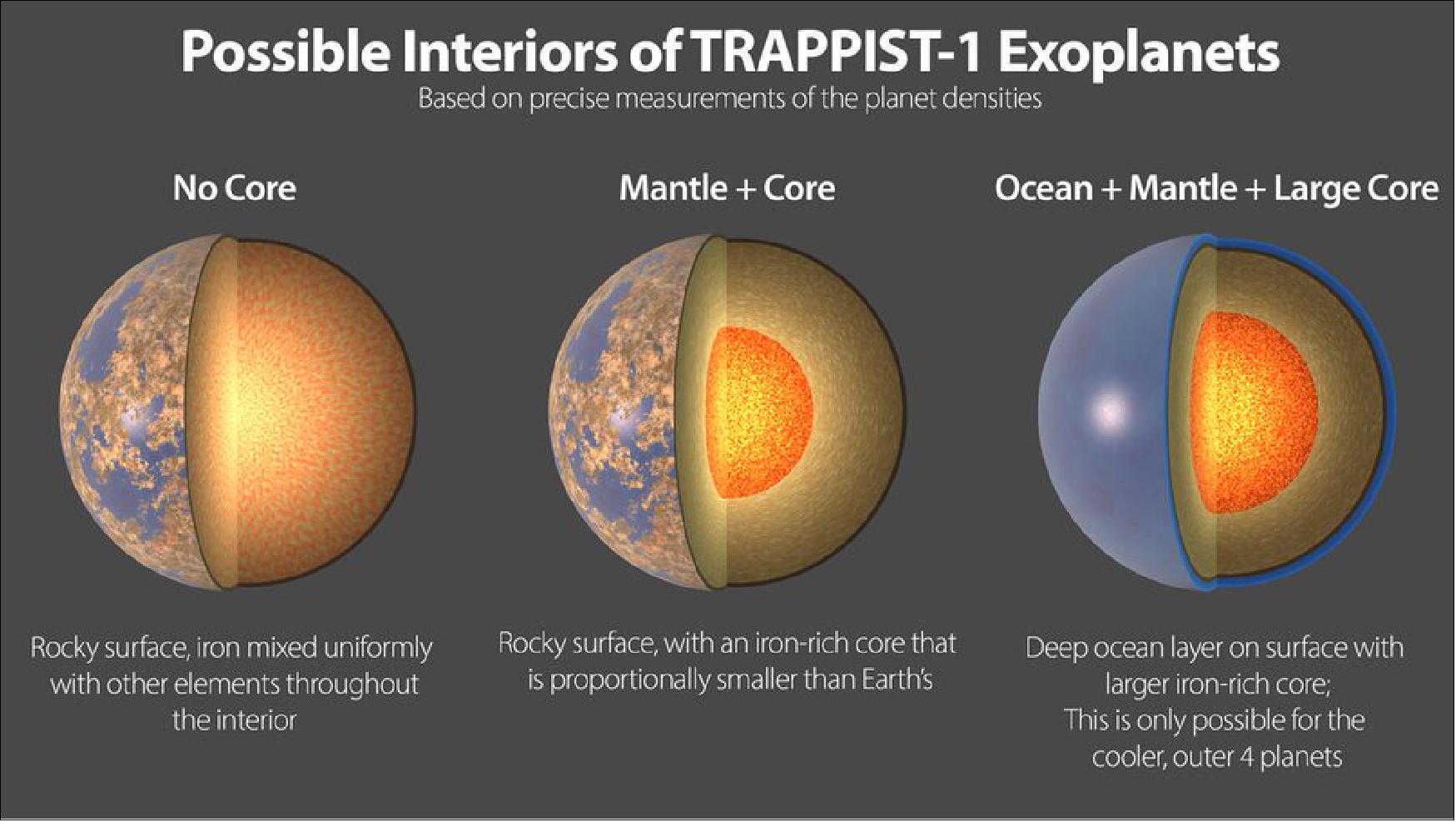
- Eric Agol, an astrophysicist at the University of Washington and lead author of the new study, said the answer might be a combination of the two scenarios – less iron overall and some oxidized iron.
- The team also looked into whether the surface of each planet could be covered with water, which is even lighter than rust and which would change the planet’s overall density. If that were the case, water would have to account for about 5% of the total mass of the outer four planets. By comparison, water makes up less than one-tenth of 1% of Earth’s total mass.
- Because they’re positioned too close to their star for water to remain a liquid under most circumstances, the three inner TRAPPIST-1 planets would require hot, dense atmospheres like Venus’, such that water could remain bound to the planet as steam. But Agol says this explanation seems less likely because it would be a coincidence for all seven planets to have just enough water present to have such similar densities.
- “The night sky is full of planets, and it’s only been within the last 30 years that we’ve been able to start unraveling their mysteries,” said Caroline Dorn, an astrophysicist at the University of Zurich and a co-author of the paper. “The TRAPPIST-1 system is fascinating because around this one star we can learn about the diversity of rocky planets within a single system. And we can actually learn more about a planet by studying its neighbors as well, so this system is perfect for that.”
- JPL, a division of Caltech in Pasadena, California, managed the Spitzer mission for NASA’s Science Mission Directorate in Washington. Science operations were conducted at the Spitzer Science Center at IPAC at Caltech. Spitzer’s entire science catalogue is available via the Spitzer data archive, housed at the Infrared Science Archive at IPAC. Spacecraft operations were based at Lockheed Martin Space in Littleton, Colorado.
• January 13, 2021: Is our solar system located in a typical Milky Way neighborhood? Scientists have gotten closer to answering this question, thanks to the NASA-funded Backyard Worlds: Planet 9 project, a “citizen science” collaboration between professional scientists and members of the public. 15)
- Scientists tapped into the worldwide network of 150,000 volunteers using Backyard Worlds: Planet 9 to find new examples of brown dwarfs. These objects are balls of gas that are not heavy enough to be stars, since they can’t power themselves through nuclear fusion the way stars do. And while “brown” is in the name, they would appear magenta or orange-red if a person could see them close up. By making a complete map of these objects, scientists could find out whether different kinds of brown dwarfs are evenly distributed in our solar system’s neighborhood.
- Telescopes can detect brown dwarfs because they emit heat, in the form of infrared light, left over from their formation. Infrared light is invisible to human eyes, but it can reveal tantalizing details about brown dwarfs and other objects throughout the universe.
- The result of the new citizen science effort is the most complete map to date of L, T and Y dwarfs in the vicinity of the solar system. These brown dwarf varieties can have temperatures of up to thousands of degrees Fahrenheit, but the Y dwarfs, which are the coolest, may have below-freezing temperatures and clouds made of water.
- Of course, an astronomer’s idea of a neighborhood is different in space than on Earth. The map encompasses a radius of 65 light-years, or about 400 trillion miles, with “close neighbors” inhabiting space within about 35 light-years, or 200 trillion miles.
- Since 2017, citizen scientists have been searching for brown dwarf candidates as part of Backyard Worlds, using data from NASA’s Near-Earth Object Wide-Field Infrared Survey Explorer (NEOWISE) satellite along with all-sky observations collected between 2010 and 2011 under its previous moniker, WISE. The Backyard Worlds team also collaborated with Caltech’s Summer Research Connection program to involve high school students in finding brown dwarfs. Both worldwide volunteers and high school students in the Pasadena, California, area are listed as co-authors of the study, which was presented at the 237th meeting of the American Astronomical Society.
- While brown dwarfs are millions to billions of years old, this team of professional and citizen scientists had a much shorter deadline to find them. They knew that NASA’s Spitzer Space Telescope was the only operating observatory that could confirm the distances and positions of the brown dwarfs they were interested in, and Spitzer was set to retire in January 2020. It was a frantic rush to find as many brown dwarfs as they could so Spitzer could reveal their locations more precisely.
- Fortunately, citizen scientists helped save the day – they discovered dozens of new brown dwarfs.
- “Without the citizen scientists, we couldn't have created such a complete sample in so short a time,” said J. Davy Kirkpatrick, scientist at Caltech/IPAC in Pasadena and lead author of the study. “Having the power of thousands of inquiring eyes on the data enabled us to find brown dwarf candidates much faster.”
- Professional astronomers then used Spitzer to observe 361 local brown dwarfs of types L, T, and Y, and combined them with previous discoveries to make a 3D map of 525 brown dwarfs. Besides the citizen science discoveries, scientists made use of CatWise, a NASA-funded catalog of objects from WISE and NEOWISE, to complete their census.
- And there’s a surprise: One of our solar system’s neighbors – the galaxy’s coldest known Y dwarf, with temperatures likely below freezing – represents a rare resident in the cosmic neighborhood. Astronomers would have expected to find a lot more of them in the vicinity. But this may be because current telescopes aren’t sensitive enough to find them, since these objects are so faint.
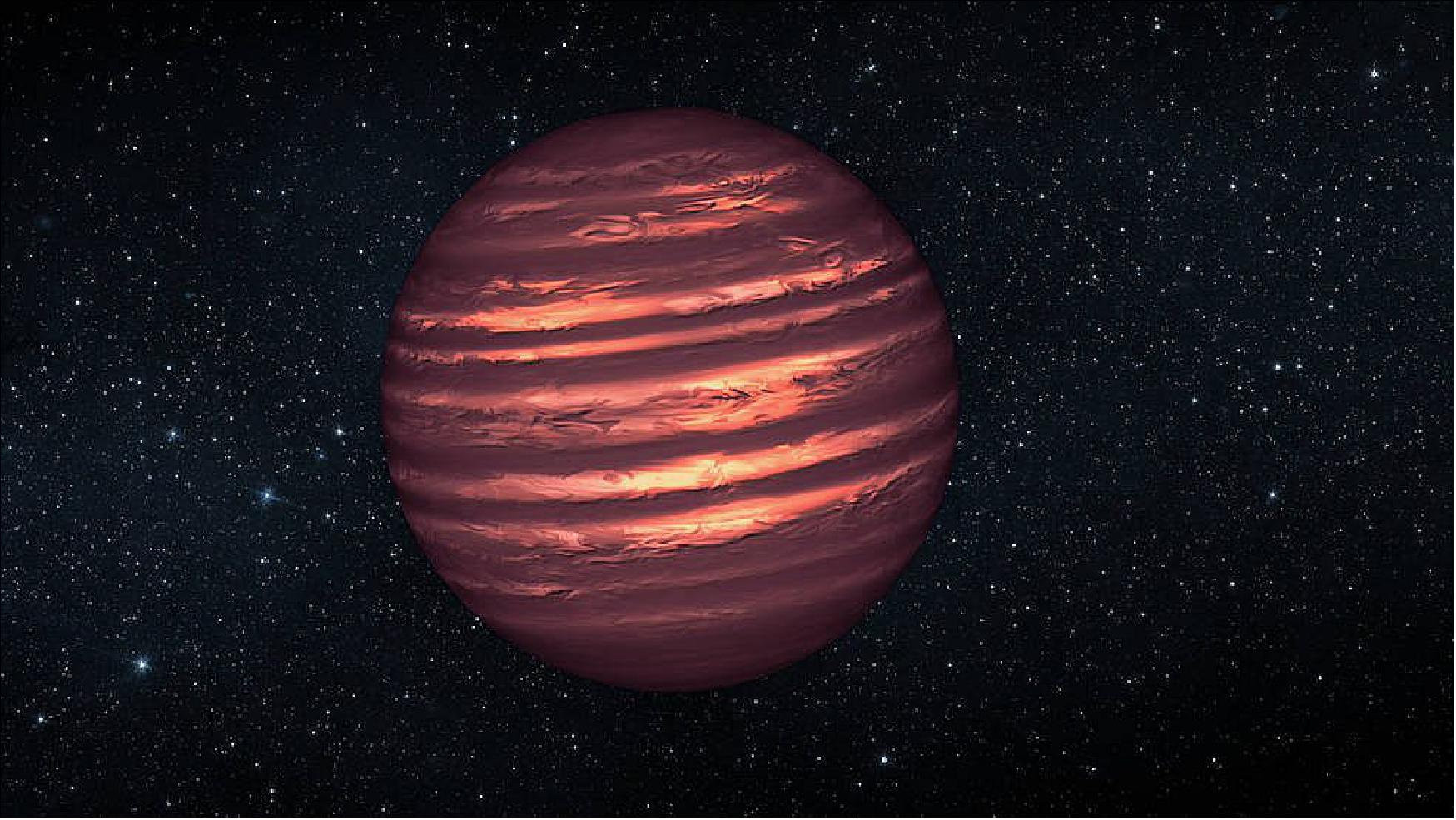
- As previous research has found, of the seven objects nearest to our solar system, three are rare types of brown dwarfs. The rest are normal stars: red dwarfs Proxima Centauri and Barnard’s Star, and Sun-like stars Alpha Centauri A and B.
- “If you were to put the Sun at a random place within our 3D map and you were to ask, ‘Typically, what do its neighbors look like?’ We find that they would look very different from what our actual neighbors are,” said Aaron Meisner, assistant scientist at the National Science Foundation’s NOIRLab and co-author of the study.
- So, is the Sun in an unusually diverse cosmic neighborhood, or is it just that nearby Y dwarfs are easiest to spot? Astronomers will need to investigate further to find out.
- Some of these L, T, and Y dwarfs have masses and temperatures similar to exoplanets – planets beyond our solar system. Getting details about distant planets can be challenging because if they orbit other stars, starlight is a lot brighter than the planet. Since brown dwarfs in this study do not orbit stars, a telescope does not have to subtract starlight to look at them. This makes brown dwarfs a new kind of laboratory for understanding exoplanets.
- Scientists will learn even more about brown dwarfs with NASA’s forthcoming James Webb Space Telescope, which will examine these mysterious objects in detail in infrared light. NASA’s upcoming SPHEREx mission, which will be an all-sky infrared survey, also presents new opportunities to characterize more brown dwarfs.
- The Backyard Worlds: Planet 9 project is ongoing and open to anyone worldwide who wants to join the quest to find more mysterious objects in spacecraft data. In addition to a total of about 3,000 brown dwarfs, volunteers have helped find the oldest, coldest white dwarf surrounded by a disk of debris.
- “I enjoy this project because the objects that we send to the researchers might get observed with a big telescope,” said Melina Thévenot, a citizen scientist in Germany who is listed as a co-author of the new study. “I think we volunteers can really see the fruits of our efforts with this project and the publications by the science team.”
• December 16, 2020: NASA’s Spitzer Space Telescope was officially decommissioned on January 30, 2020, but Spitzer’s discoveries will continue for years to come. A great way to learn about these science tidbits is to continue to follow Spitzer’s social media feeds under their new branding of “ExploreAstro at Caltech IPAC.” 16)
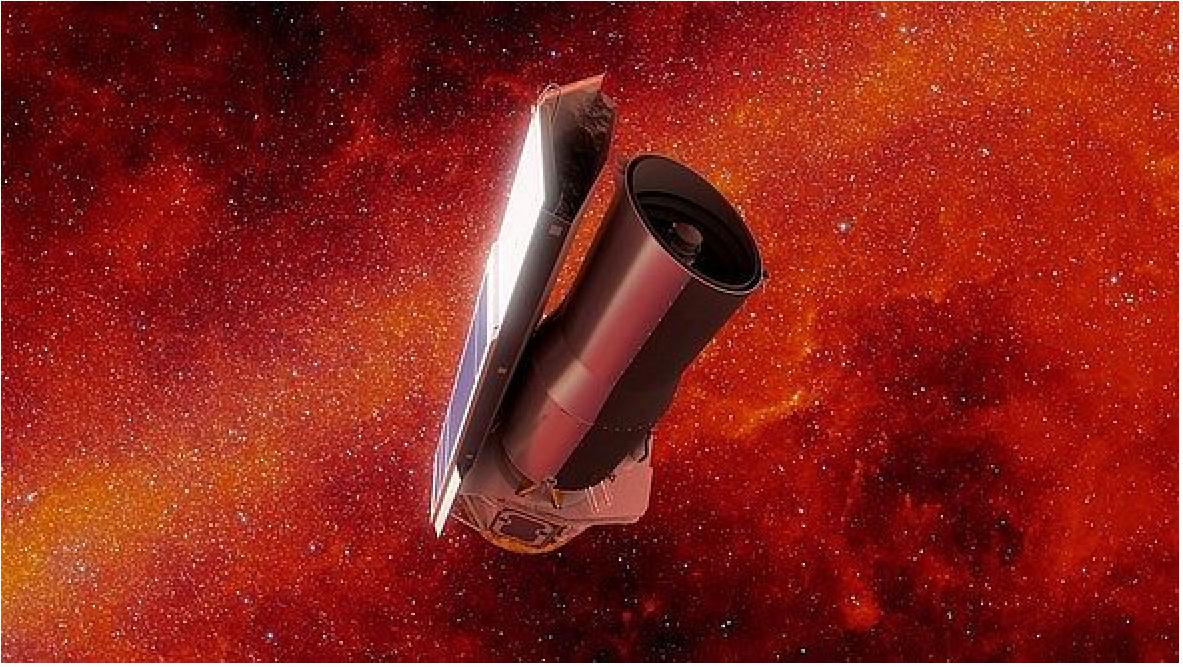
- NASA’s Spitzer Science Center will be winding down operations in 2021, but many of its services will continue to be a part of IPAC, a science and data center for astrophysics and planetary science based at the California Institute of Technology in Pasadena, California. Spitzer data will continue to be served to the community through NASA's Infrared Science Archive (IRSA), which is based at IPAC.
- The social media rebranding from “NASA Spitzer” to “ExploreAstro” reflects this transition of Spitzer from an active project to one of the many historic missions IPAC has supported over the decades, including IRAS, ISO, 2MASS, WISE, Herschel, and Planck, to name a few. Subscribers can expect to continue the Spitzer story as the channels expand to include even more exciting developments from other missions.
• November 18, 2020: The Blue Ring Nebula, which perplexed scientists for over a decade, appears to be the youngest known example of two stars merged into one. 17)
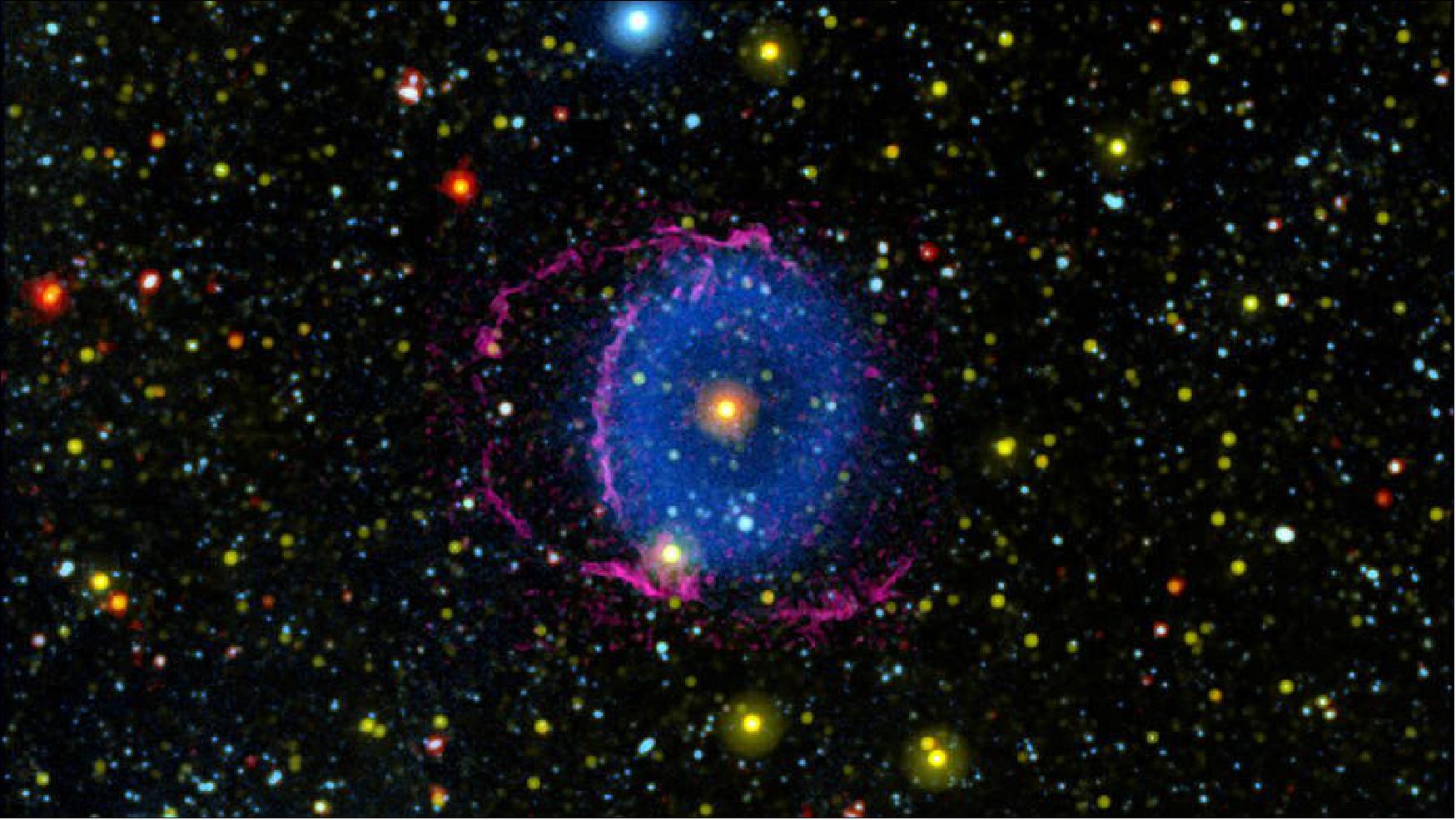
- In 2004, scientists with NASA's space-based Galaxy Evolution Explorer (GALEX) spotted an object unlike any they'd seen before in our Milky Way galaxy: a large, faint blob of gas with a star at its center. In the GALEX images, the blob appeared blue – though it doesn't actually emit light visible to the human eye – and subsequent observations revealed a thick ring structure within it. So the team nicknamed it the Blue Ring Nebula. Over the next 16 years, they studied it with multiple Earth- and space-based telescopes, but the more they learned, the more mysterious it seemed.
- A new study published online on Nov. 18 in the journal Nature may have cracked the case. By applying cutting-edge theoretical models to the slew of data that has been collected on this object, the authors posit the nebula – a cloud of gas in space – is likely composed of debris from two stars that collided and merged into a single star.
- While merged star systems are thought to be fairly common, they are nearly impossible to study immediately after they form because they're obscured by debris the collision kicks up. Once the debris has cleared – at least hundreds of thousands of years later – they're challenging to identify because they resemble non-merged stars. The Blue Ring Nebula appears to be the missing link: Astronomers are seeing the star system only a few thousand years after the merger, when evidence of the union is still plentiful. It appears to be the first known example of a merged star system at this stage.
- Operated between 2003 and 2013 and managed by NASA's Jet Propulsion Laboratory in Southern California, GALEX was designed to help study the history of star formation throughout most of the universe by taking a census of young star populations in other galaxies. To do this, the mission observed both near-UV light (wavelengths slightly shorter than visible light) and far-UV. Most objects seen by GALEX radiated both near-UV (represented as yellow in GALEX images) and far-UV (represented as blue), but the Blue Ring Nebula stood out because it emitted only far-UV light.
- The object's size was similar to that of a supernova remnant, which forms when a massive star runs out of fuel and explodes, or a planetary nebula, the puffed-up remains of a star the size of our Sun. But the Blue Ring Nebula had a living star at its center. What's more, supernova remnants and planetary nebulas radiate in multiple light wavelengths outside the UV range, while further research showed that the Blue Ring Nebula did not.
Phantom Planet
- In 2006, the GALEX team looked at the nebula with the 200-inch (5.1-meter) Hale telescope at the Palomar Observatory in San Diego County, California, and then with the even more powerful 10-meter (33-foot) telescopes at the W. M. Keck Observatory in Hawaii. They found evidence of a shockwave in the nebula, suggesting the gas composing the Blue Ring Nebula had indeed been expelled by some kind of violent event around the central star. Keck data also suggested the star was pulling a large amount of material onto its surface. But where was the material coming from?
- "For quite a long time we thought that maybe there was a planet several times the mass of Jupiter being torn apart by the star, and that was throwing all that gas out of the system," said Mark Seibert, an astrophysicist with the Carnegie Institution for Science and a member of the GALEX team at Caltech, which manages JPL.
- But the team wanted more data. In 2012, using the first full-sky survey from NASA's Wide-field Infrared Survey Explorer (WISE), a space telescope that studied the sky in infrared light, the GALEX team identified a disk of dust orbiting closely around the star. (WISE was reactivated in 2013 as the asteroid-hunting NEOWISE mission.) Archival data from three other infrared observatories, including NASA's Spitzer Space Telescope, also spotted the disk. The finding didn't rule out the possibility that a planet was also orbiting the star, but eventually the team would show that the disk and the material expelled into space came from something larger than even a giant planet. Then in 2017, the Habitable Zone Planet Finder on the Hobby-Eberly Telescope in Texas confirmed there was no compact object orbiting the star.
- More than a decade after discovering the Blue Ring Nebula, the team had gathered data on the system from four space telescopes, four ground-based telescopes, historical observations of the star going back to 1895 (in order to look for changes in its brightness over time), and with the help of citizen scientists through the American Association of Variable Star Observers (AAVSO). But an explanation for what had created the nebula still eluded them.
Stellar Sleuthing
- By the time Keri Hoadley began working with the GALEX science team in 2017, "the group had kind of hit a wall" with the Blue Ring Nebula, she said. But Hoadley, an astrophysicist at Caltech, was fascinated by the object and its bizarre features, so she accepted the challenge of trying to solve the mystery. It seemed likely that the solution would not come from more observations of the system, but from cutting-edge theories that could make sense of the existing data. So Chris Martin, principal investigator for GALEX at Caltech, reached out to Brian Metzger of Columbia University for help.
- As a theoretical astrophysicist, Metzger makes mathematical and computational models of cosmic phenomena, which can be used to predict how those phenomena will look and behave. He specializes in cosmic mergers – collisions between a variety of objects, whether they be planets and stars or two black holes. With Metzger on board and Hoadley shepherding the work, things progressed quickly.
- "It wasn't just that Brian could explain the data we were seeing; he was essentially predicting what we had observed before he saw it," said Hoadley. "He'd say, 'If this is a stellar merger, then you should see X,' and it was like, 'Yes! We see that!'"
- The team concluded that the nebula was the product of a relatively fresh stellar merger that likely occurred between a star similar to our Sun and another star only about one-tenth that size (or about 100 times the mass of Jupiter). Nearing the end of its life, the Sun-like star began to swell, creeping closer to its companion. Eventually, the smaller star fell into a downward spiral toward its larger companion. Along the way, the larger star tore the smaller star apart, wrapping itself in a ring of debris before swallowing the smaller star entirely.
- This was the violent event that led to the formation of the Blue Ring Nebula. The merger launched a cloud of hot debris into space that was sliced in two by the gas disk. This created two cone-shaped debris clouds, their bases moving away from the star in opposite directions and getting wider as they travel outward. The base of one cone is coming almost directly toward Earth and the other almost directly away. They are too faint to see alone, but the area where the cones overlap (as seen from Earth) forms the central blue ring GALEX observed.
- Millennia passed. The expanding debris cloud cooled and formed molecules and dust, including hydrogen molecules that collided with the interstellar medium, the sparse collection of atoms and energetic particles that fill the space between stars. The collisions excited the hydrogen molecules, causing them to radiate in a specific wavelength of far-UV light. Over time, the glow became just bright enough for GALEX to see.
- Stellar mergers may occur as often as once every 10 years in our Milky Way galaxy, meaning it's possible that a sizeable population of the stars we see in the sky were once two.
- "We see plenty of two-star systems that might merge some day, and we think we've identified stars that merged maybe millions of years ago. But we have almost no data on what happens in between," said Metzger. "We think there are probably plenty of young remnants of stellar mergers in our galaxy, and the Blue Ring Nebula might show us what they look like so we can identify more of them."
- Though this is likely the conclusion of a 16-year-old mystery, it may also be the beginning of a new chapter in the study of stellar mergers.
- "It's amazing that GALEX was able to find this really faint object that we weren't looking for but that turns out to be something really interesting to astronomers," said Seibert. "It just reiterates that when you look at the universe in a new wavelength or in a new way, you find things you never imagined you would."
• October 26, 2020: An international team of scientists recently measured the spectrum of the atmosphere of a rare hot Neptune exoplanet, whose discovery by NASA's Transiting Exoplanet Survey Satellite (TESS) was announced just last month. 18) 19)
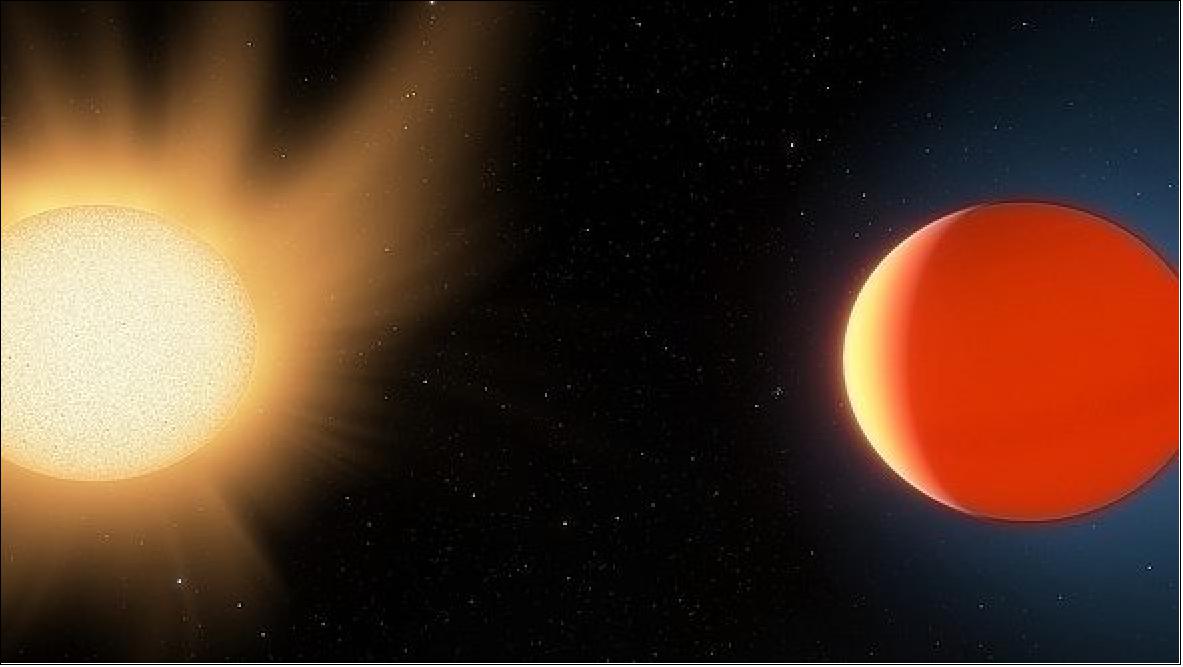
- The discovery was made with data provided from the now-retired NASA Spitzer Space Telescope, which allows a unique, infrared view of the universe to look into regions of space that are hidden from optical telescopes.
- One of the main goals of NASA’s TESS mission is to find new, small planets that would be good targets for atmospheric characterization. Early in its mission, it found LTT9779b, a planet orbiting a Sun-like star located 260 light years away from Earth. This planet, a little larger than Neptune, orbits very close to its star. The planet is found in the "hot Neptune desert," where planets shouldn't exist. Indeed, most close-in hot exoplanets are either gas giants the size of Jupiter or Saturn that have enough mass to retain most of their atmosphere using their high gravity against the evaporation caused by the star, or small rocky exoplanets that have lost their atmosphere to the star long ago.
- “This ultra-hot Neptune is a ‘medium-sized’ exoplanet that orbits very close to its star (it takes just 19 hours to complete an orbit), but its low density indicates that it still has an atmosphere weighing at least 10 percent of the planet’s mass,” explained University of New Mexico Physics and Astronomy Assistant Professor Diana Dragomir, who is leading the work which involved more than 25 institutions.
- The age of this system is 2 billion years. At this high temperature, the planet’s atmosphere should have evaporated long ago, early in the system’s life. “Hot Neptunes are rare, and one in such an extreme environment as this one is difficult to explain because its mass isn’t large enough to hold on to an atmosphere for very long. So how did it manage? LTT9779b had us scratching our heads, but the fact that it has an atmosphere gives us a rare way to investigate this type of planet, so we decided to probe it with another telescope,” Dragomir added.
- To investigate its atmospheric composition and shed further light on its origin, scientists obtained secondary eclipse observations with the Spitzer Infrared Array Camera (IRAC) of the hot Neptune. The Spitzer observations confirmed an atmospheric presence and enabled a measurement of the planet's very high temperature, approximately 2,000 Kelvin (about 3,000 º Fahrenheit). “For the first time, we measured light coming from a planet that shouldn’t exist!” Said Dragomir.
- After combining the Spitzer observations with a measurement of the secondary eclipse in the TESS bandpass, the scientists studied the resulting emission spectrum and identified evidence of molecular absorption in the planet’s atmosphere, which they believe is likely due to carbon monoxide. This molecule is not unexpected in the atmospheres of hot large planets (hot Jupiters), but to find it in a hot Neptune may provide clues on the origin of this planet and how it managed to hold onto its atmosphere. This result constitutes the first detection of atmospheric features in an exoplanet discovered by TESS, and the first-ever for an ultra-hot Neptune.
- “If there’s a lot of atmosphere surrounding the planet, as is the case for LTT9779b, then you can study it more easily,” said Dragomir. “A smaller atmosphere would be much harder to observe.” The results indicate that LTT9779b is an excellent target for additional characterization with NASA’s upcoming James Webb Space Telescope (JWST), which could also verify whether the observed molecular absorption is indeed due to carbon monoxide.
- A companion paper, led by Kansas University Assistant Professor Ian Crossfield, also found signs that point to the planet’s atmosphere having a higher level of heavy elements than expected. This is additionally intriguing because the two similarly-sized planets in our Solar System, Neptune and Uranus, are primarily composed of light elements like hydrogen and helium.
- “LTT9779 is one of those super-exciting targets, a very rare gemstone for our understanding of hot Neptunes. We believe we detected carbon-monoxide in its atmosphere and that the permanent dayside is very hot, while very little heat is transported to the night side,” said Björn Benneke, professor at Université de Montréal and member of the Institute for Research on exoplanets (iREx). “Both findings make LTT9779b say that there is a very strong signal to be observed making the planet a very intriguing target for future detailed characterization with JWST.”
- Together, these results set the stage for similar investigations of a larger sample of exoplanets discovered in this hot Neptune desert, which are key to uncovering the origin of this unique population of exoplanets. 20)
• August 25, 2020: The nebula known as W51 is one of the most active star-forming regions in the Milky Way galaxy. First identified in 1958 by radio telescopes, it makes a rich cosmic tapestry in this image from NASA's recently retired Spitzer Space Telescope. 21)
- Located about 17,000 light-years from Earth, in the direction of the constellation Aquila in the night sky, W51 is about 350 light-years - or about 2 quadrillion miles - across. It is almost invisible to telescopes that collect visible light (the kind human eyes detect), because that light is blocked by interstellar dust clouds that lie between W51 and Earth. But longer wavelengths of light, including radio and infrared, can pass unencumbered through the dust. When viewed in infrared by Spitzer, W51 is a spectacular sight: Its total infrared emission is the equivalent of 20 million Suns.
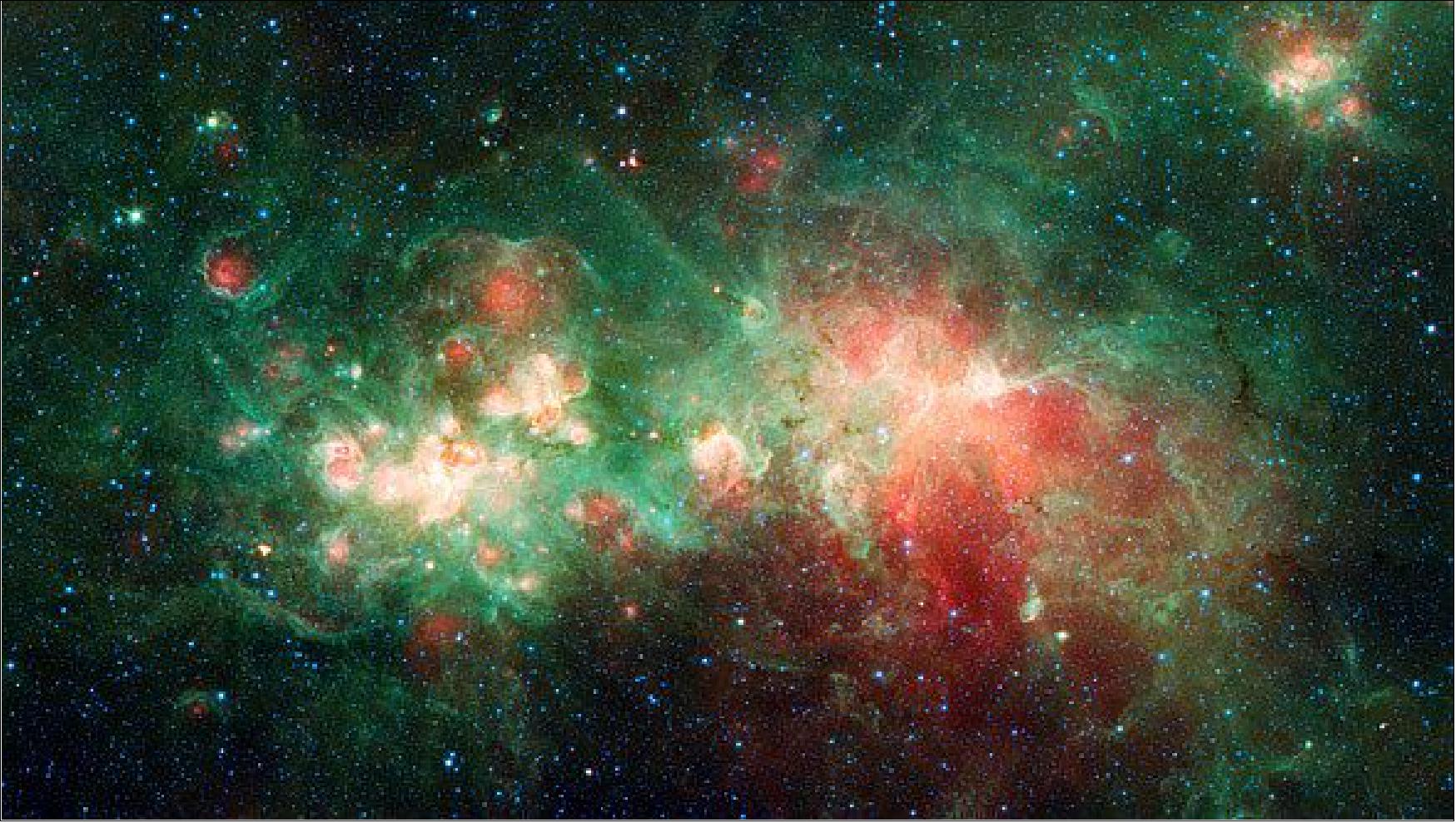
- If you could see it with your naked eye, this dense cloud of gas and dust would appear about as large as the full Moon. The Orion Nebula - another well-known star-forming region and a favorite observing target for amateur astronomers - occupies about the same size area in the sky. But W51 is actually much farther from Earth than Orion and thus much larger, and it's about 75 times more luminous. While Orion contains four known O-type stars - the most massive stars in the universe - W51 contains over 30.
- "Star factories" like this one can operate for millions of years. The cavernous red region on the right side of W51 is older, evident in the way it has already been carved out by winds from generations of massive stars (those at least 10 times the mass of our Sun). The dust and gas in the region are swept around even more when those stars die and explode as supernovas. On the nebula's younger left side, many stars are just beginning to clear away the gas and dust in the same way the stars in the older region have done. It's apparent that many of these young stars are in the process of forming bubbles of empty space around themselves.
- "The really spectacular images provided by Spitzer via the GLIMPSE survey - in concert with data from many other, complementary telescopes - give us insight into how massive stars form in our Milky Way, and then how their powerful winds and radiation interact with the remaining ambient material," said Breanna Binder, an assistant professor of physics and astronomy at California State Polytechnic University, Pomona, who studies the life cycles of massive stars. "We can't observe star-forming regions in other galaxies in anywhere near the level of detail that we can in our own galaxy. So regions like W51 are really important for advancing our understanding of star formation in the Milky Way, which we can then extrapolate to how star formation proceeds in other, nearby galaxies."
• June 24, 2020: The newly discovered planet's parent star is still encircled by the disk of material from which both objects formed, giving scientists a glimpse at early planet evolution. 22)
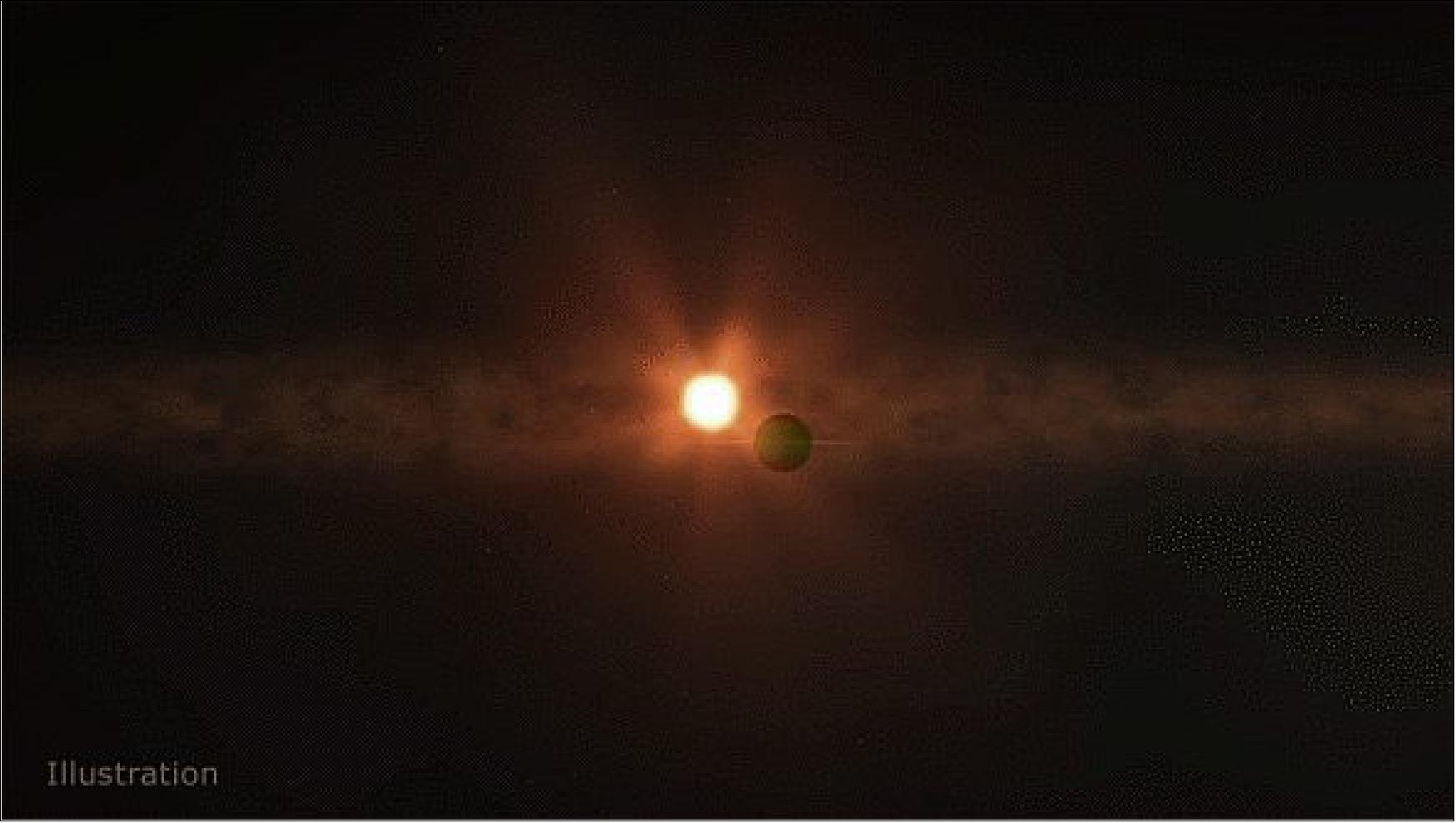
- The system, known as AU Mic for short, provides a one-of-kind laboratory for studying how planets and their atmospheres form, evolve and interact with their stars.
- "AU Mic is a young, nearby M dwarf star. It's surrounded by a vast debris disk in which moving clumps of dust have been tracked, and now, thanks to TESS and Spitzer, it has a planet with a direct size measurement," said Bryson Cale, a doctoral student at George Mason University in Fairfax, Virginia. "There is no other known system that checks all of these important boxes."
- The new planet, AU Mic b, is described in a paper coauthored by Cale and led by his advisor Peter Plavchan, an assistant professor of physics and astronomy at George Mason. Their report was published on Wednesday, July 15, in the journal Nature. 23)
- AU Mic b is featured in a new NASA poster available in English and Spanish, part of a Galaxy of Horrors series. The fun but informative series resulted from a collaboration of scientists and artists and was produced by NASA's Exoplanet Exploration Program Office.
- AU Mic is a cool red dwarf star with an age estimated at 20 million to 30 million years, making it a stellar infant compared to our Sun, which is at least 150 times older. The star is so young that it primarily shines from the heat generated as its own gravity pulls it inward and compresses it. Less than 10% of the star's energy comes from the fusion of hydrogen into helium in its core, the process that powers stars like our Sun.
- The system is located 31.9 light-years away in the southern constellation Microscopium. It's part of a nearby collection of stars called the Beta Pictoris Moving Group, which takes its name from a bigger, hotter A-type star that harbors two planets and is likewise surrounded by a debris disk.
- Although the systems have the same age, their planets are markedly different. The planet AU Mic b almost hugs its star, completing an orbit every 8.5 days. It weighs less than 58 times Earth's mass, placing it in the category of Neptune-like worlds. Beta Pictoris b and c, however, are both at least 50 times more massive than AU Mic b and take 21 and 3.3 years, respectively, to orbit their star.
- "We think AU Mic b formed far from the star and migrated inward to its current orbit, something that can happen as planets interact gravitationally with a gas disk or with other planets," said coauthor Thomas Barclay, an associate research scientist at the University of Maryland, Baltimore County and an associate project scientist for TESS at NASA's Goddard Space Flight Center in Greenbelt, Maryland. "By contrast, Beta Pictoris b's orbit doesn't appear to have migrated much at all. The differences between these similarly aged systems can tell us a lot about how planets form and migrate."
- Detecting planets around stars like AU Mic poses a particular challenge. These stormy stars possess strong magnetic fields and can be covered with starspots — cooler, darker and highly magnetic regions akin to sunspots — that frequently erupt with powerful stellar flares. Both the spots and their flares contribute to the star's brightness changes.
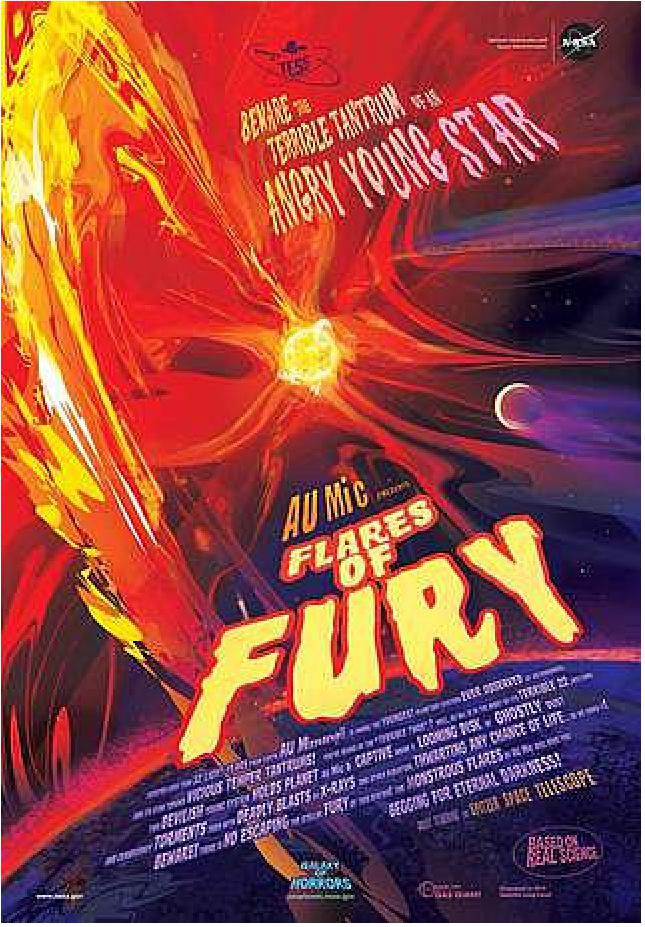
- In July and August 2018, when TESS was observing AU Mic, the star produced numerous flares, some of which were more powerful than the strongest flares ever recorded on the Sun. The team performed a detailed analysis to remove these effects from the TESS data.
- When a planet crosses in front of its star from our perspective, an event called a transit, its passage causes a distinct dip in the star's brightness. TESS monitors large swaths of the sky, called sectors, for 27 days at a time. During this long stare, the mission's cameras regularly capture snapshots that allow scientists to track changes in stellar brightness.
- Regular dips in a star's brightness signal the possibility of a transiting planet. Usually, it takes at least two observed transits to recognize a planet's presence.
- "As luck would have it, the second of three TESS transits occurred when the spacecraft was near its closest point to Earth. At such times, TESS is not observing because it is busy downlinking all of the stored data," said coauthor Diana Dragomir, a research assistant professor at the University of New Mexico in Albuquerque. "To fill the gap, our team was granted observing time on Spitzer, which caught two additional transits in 2019 and enabled us to confirm the orbital period of AU Mic b."
• June22, 2020: Jupiter-size planets orbiting close to their stars have upended ideas about how giant planets form. Finding young members of this planet class could help answer key questions. 24)
- For most of human history our understanding of how planets form and evolve was based on the eight (or nine) planets in our solar system. But over the last 25 years, the discovery of more than 4,000 exoplanets, or planets outside our solar system, changed all that.
- Among the most intriguing of these distant worlds is a class of exoplanets called hot Jupiters. Similar in size to Jupiter, these gas-dominated planets orbit extremely close to their parent stars, circling them in as few as 18 hours. We have nothing like this in our own solar system, where the closest planets to the Sun are rocky and orbiting much farther away. The questions about hot Jupiters are as big as the planets themselves: Do they form close to their stars or farther away before migrating inward? And if these giants do migrate, what would that reveal about the history of the planets in our own solar system?
- To answer those questions, scientists will need to observe many of these hot giants very early in their formation. Now, a new study in the Astronomical Journal reports on the detection of the exoplanet HIP 67522 b, which appears to be the youngest hot Jupiter ever found. It orbits a well-studied star that is about 17 million years old, meaning the hot Jupiter is likely only a few million years younger, whereas most known hot Jupiters are more than a billion years old. The planet takes about seven days to orbit its star, which has a mass similar to the Sun's. Located only about 490 light-years from Earth, HIP 67522 b is about 10 times the diameter of Earth, or close to that of Jupiter. Its size strongly indicates that it is a gas-dominated planet.
- HIP 67522 b was identified as a planet candidate by NASA's Transiting Exoplanet Survey Satellite (TESS), which detects planets via the transit method: Scientists look for small dips in the brightness of a star, indicating that an orbiting planet has passed between the observer and the star. But young stars tend to have a lot of dark splotches on their surfaces — starspots, also called sunspots when they appear on the Sun — that can look similar to transiting planets. So scientists used data from NASA's recently retired infrared observatory, the Spitzer Space Telescope, to confirm that the transit signal was from a planet and not a starspot. (Other methods of exoplanet detection have yielded hints at the presence of even younger hot Jupiters, but none have been confirmed.)
- The discovery offers hope for finding more young hot Jupiters and learning more about how planets form throughout the universe — even right here at home.
- "We can learn a lot about our solar system and its history by studying the planets and other things orbiting the Sun," said Aaron Rizzutto, an exoplanet scientist at the University of Texas at Austin who led the study. "But we will never know how unique or how common our solar system is unless we're out there looking for exoplanets. Exoplanet scientists are finding out how our solar system fits in the bigger picture of planet formation in the universe."
Migrating Giants?
- There are three main hypotheses for how hot Jupiters get so close to their parent stars. One is that they simply form there and stay put. But it's hard to imagine planets forming in such an intense environment. Not only would the scorching heat vaporize most materials, but young stars frequently erupt with massive explosions and stellar winds, potentially dispersing any newly emerging planets.
- It seems more likely that gas giants develop farther from their parent star, past a boundary called the snow line, where it's cool enough for ice and other solid materials to form. Jupiter-like planets are composed almost entirely of gas, but they contain solid cores. It would be easier for those cores to form past the snow line, where frozen materials could cling together like a growing snowball.
- The other two hypotheses assume this is the case, and that hot Jupiters then wander toward closer to their stars. But what would be the cause and timing of the migration?
- One idea posits that hot Jupiters begin their journey early in the planetary system's history while the star is still surrounded by the disk of gas and dust from which both it and the planet formed. In this scenario, the gravity of the disk interacting with the mass of the planet could interrupt the gas giant's orbit and cause it to migrate inward.
- The third hypothesis maintains that hot Jupiters get close to their star later, when the gravity of other planets around the star can drive the migration. The fact that HIP 67522 b is already so close to its star so early after its formation indicates that this third hypothesis probably doesn't apply in this case. But one young hot Jupiter isn't enough to settle the debate on how they all form.
- "Scientists would like to know if there is a dominant mechanism that forms most hot Jupiters," said Yasuhiro Hasegawa, an astrophysicist specializing in planet formation at NASA's Jet Propulsion Laboratory who was not involved in the study. "In the community right now there is no clear consensus about which formation hypothesis is most important for reproducing the population we have observed. The discovery of this young hot Jupiter is exciting, but it's only a hint at the answer. To solve the mystery, we will need more."
- TESS is a NASA Astrophysics Explorer mission led and operated by MIT in Cambridge, Massachusetts, and managed by NASA's Goddard Space Flight Center. Additional partners include Northrop Grumman, based in Falls Church, Virginia; NASA's Ames Research Center in California's Silicon Valley; the Harvard-Smithsonian Center for Astrophysics in Cambridge, Massachusetts; MIT's Lincoln Laboratory; and the Space Telescope Science Institute in Baltimore. More than a dozen universities, research institutes and observatories worldwide are participants in the mission.
- NASA's Spitzer Space Telescope was retired on Jan. 30, 2020. Science data continues to be analyzed by the science community via the Spitzer data archive located at the Infrared Science Archive housed at IPAC at Caltech in Pasadena, California. JPL managed Spitzer mission operations for NASA's Science Mission Directorate in Washington. Science operations were conducted at the Spitzer Science Center at IPAC at Caltech. Spacecraft operations were based at Lockheed Martin Space in Littleton, Colorado. Caltech manages JPL for NASA.
• April 28, 2020: The recently retired infrared observatory was the only telescope to spot a far-off flash of light that holds clues about the physical characteristics of these cosmic mysteries. 25)
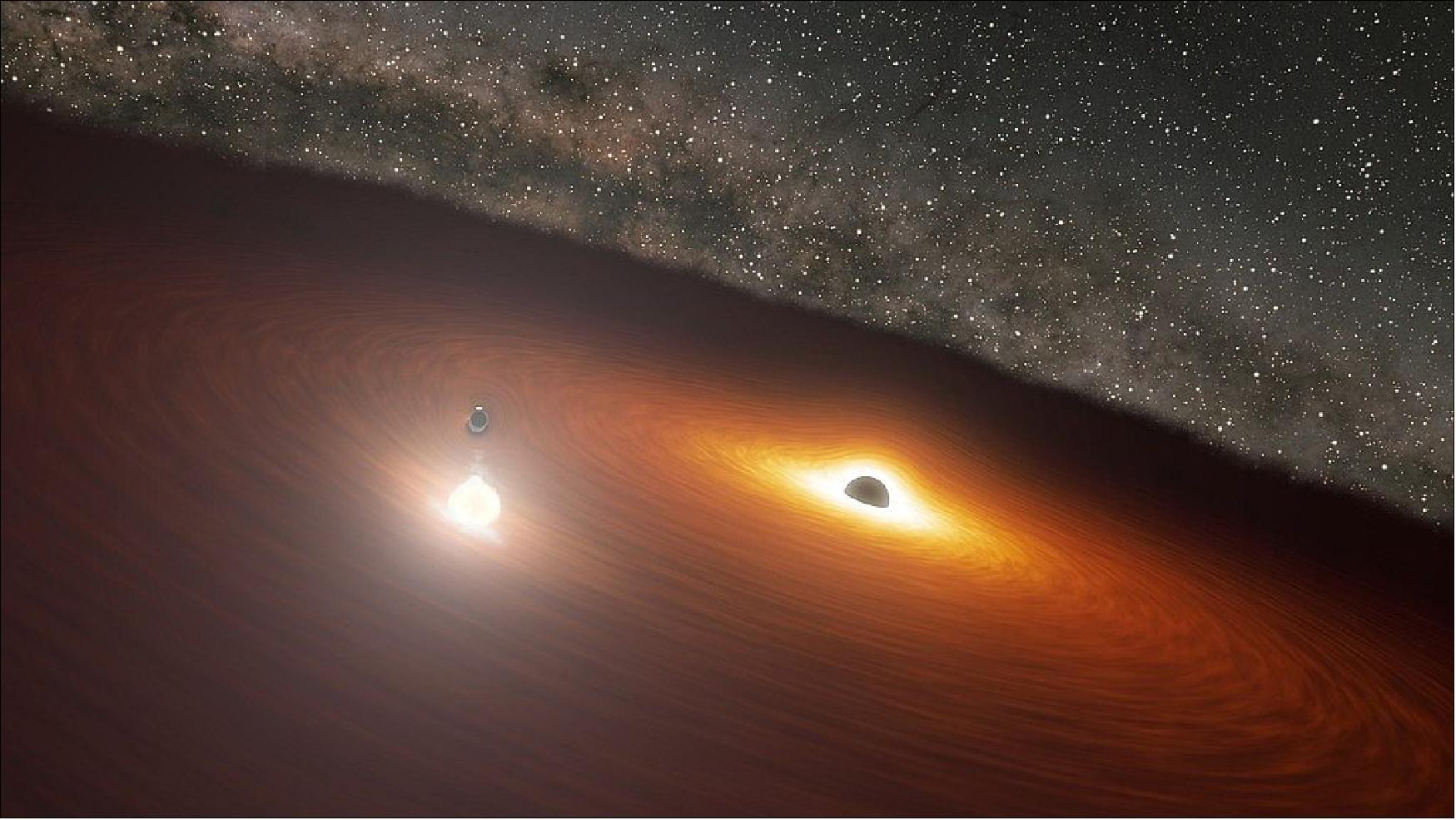
- Black holes aren't stationary in space; in fact, they can be quite active in their movements. But because they are completely dark and can't be observed directly, they're not easy to study. Scientists have finally figured out the precise timing of a complicated dance between two enormous black holes, revealing hidden details about the physical characteristics of these mysterious cosmic objects.
- The OJ 287 galaxy hosts one of the largest black holes ever found, with over 18 billion times the mass of our Sun. Orbiting this behemoth is another black hole with about 150 million times the Sun's mass. Twice every 12 years, the smaller black hole crashes through the enormous disk of gas surrounding its larger companion, creating a flash of light brighter than a trillion stars - brighter, even, than the entire Milky Way galaxy. The light takes 3.5 billion years to reach Earth.
- The OJ 287 galaxy hosts one of the largest black holes ever found, with over 18 billion times the mass of our Sun. Orbiting this behemoth is another massive black hole. Twice every 12 years, the smaller black hole crashes through the enormous disk of gas surrounding its larger companion, creating a flash of light brighter than a trillion stars.
- But the smaller black hole's orbit is oblong, not circular, and it's irregular: It shifts position with each loop around the bigger black hole and is tilted relative to the disk of gas. When the smaller black hole crashes through the disk, it creates two expanding bubbles of hot gas that move away from the disk in opposite directions, and in less than 48 hours the system appears to quadruple in brightness.
- Because of the irregular orbit, the black hole collides with the disk at different times during each 12-year orbit. Sometimes the flares appear as little as one year apart; other times, as much as 10 years apart. Attempts to model the orbit and predict when the flares would occur took decades, but in 2010, scientists created a model that could predict their occurrence to within about one to three weeks. They demonstrated that their model was correct by predicting the appearance of a flare in December 2015 to within three weeks.
- Then, in 2018, a group of scientists led by Lankeswar Dey, a graduate student at the Tata Institute of Fundamental Research in Mumbai, India, published a paper with an even more detailed model they claimed would be able to predict the timing of future flares to within four hours. In a new study published in the Astrophysical Journal Letters, those scientists report that their accurate prediction of a flare that occurred on July 31, 2019, confirms the model is correct. 26)
- The observation of that flare almost didn't happen. Because OJ 287 was on the opposite side of the Sun from Earth, out of view of all telescopes on the ground and in Earth orbit, the black hole wouldn't come back into view of those telescopes until early September, long after the flare had faded. But the system was within view of NASA's Spitzer Space Telescope, which the agency retired in January 2020.
- After 16 years of operations, the spacecraft's orbit had placed it 158 million miles (254 million kilometers) from Earth, or more than 600 times the distance between Earth and the Moon. From this vantage point, Spitzer could observe the system from July 31 (the same day the flare was expected to appear) to early September, when OJ 287 would become observable to telescopes on Earth.
- "When I first checked the visibility of OJ 287, I was shocked to find that it became visible to Spitzer right on the day when the next flare was predicted to occur," said Seppo Laine, an associate staff scientist at Caltech/IPAC in Pasadena, California, who oversaw Spitzer's observations of the system. "It was extremely fortunate that we would be able to capture the peak of this flare with Spitzer, because no other human-made instruments were capable of achieving this feat at that specific point in time."
Ripples in Space
- Scientists regularly model the orbits of small objects in our solar system, like a comet looping around the Sun, taking into account the factors that will most significantly influence their motion. For that comet, the Sun's gravity is usually the dominant force, but the gravitational pull of nearby planets can change its path, too.
- Determining the motion of two enormous black holes is much more complex. Scientists must account for factors that might not noticeably impact smaller objects; chief among them are something called gravitational waves. Einstein's theory of general relativity describes gravity as the warping of space by an object's mass. When an object moves through space, the distortions turn into waves. Einstein predicted the existence of gravitational waves in 1916, but they weren't observed directly until 2015 by the Laser Interferometer Gravitational Wave Observatory (LIGO).
- The larger an object's mass, the larger and more energetic the gravitational waves it creates. In the OJ 287 system, scientists expect the gravitational waves to be so large that they can carry enough energy away from the system to measurably alter the smaller black hole's orbit - and therefore timing of the flares.
- The larger an object's mass, the larger and more energetic the gravitational waves it creates. In the OJ 287 system, scientists expect the gravitational waves to be so large that they can carry enough energy away from the system to measurably alter the smaller black hole's orbit - and therefore timing of the flares.
- While previous studies of OJ 287 have accounted for gravitational waves, the 2018 model is the most detailed yet. By incorporating information gathered from LIGO's detections of gravitational waves, it refines the window in which a flare is expected to occur to just 1 1/2 days.
- To further refine the prediction of the flares to just four hours, the scientists folded in details about the larger black hole's physical characteristics. Specifically, the new model incorporates something called the "no-hair" theorem of black holes.
- Published in the 1960s by a group of physicists that included Stephen Hawking, the theorem makes a prediction about the nature of black hole "surfaces." While black holes don't have true surfaces, scientists know there is a boundary around them beyond which nothing - not even light - can escape. Some ideas posit that the outer edge, called the event horizon, could be bumpy or irregular, but the no-hair theorem posits that the "surface" has no such features, not even hair (the theorem's name was a joke).
- In other words, if one were to cut the black hole down the middle along its rotational axis, the surface would be symmetric. (The Earth's rotational axis is almost perfectly aligned with its North and South Poles. If you cut the planet in half along that axis and compared the two halves, you would find that our planet is mostly symmetric, though features like oceans and mountains create some small variations between the halves.)
Finding Symmetry
- In the 1970s, Caltech professor emeritus Kip Thorne described how this scenario - a satellite orbiting a massive black hole - could potentially reveal whether the black hole's surface was smooth or bumpy. By correctly anticipating the smaller black hole's orbit with such precision, the new model supports the no-hair theorem, meaning our basic understanding of these incredibly strange cosmic objects is correct. The OJ 287 system, in other words, supports the idea that black hole surfaces are symmetric along their rotational axes.
- So how does the smoothness of the massive black hole's surface impact the timing of the smaller black hole's orbit? That orbit is determined mostly by the mass of the larger black hole. If it grew more massive or shed some of its heft, that would change the size of smaller black hole's orbit. But the distribution of mass matters as well. A massive bulge on one side of the larger black hole would distort the space around it differently than if the black hole were symmetric. That would then alter the smaller black hole's path as it orbits its companion and measurably change the timing of the black hole's collision with the disk on that particular orbit.
- "It is important to black hole scientists that we prove or disprove the no-hair theorem. Without it, we cannot trust that black holes as envisaged by Hawking and others exist at all," said Mauri Valtonen, an astrophysicist at University of Turku in Finland and a coauthor on the paper.
- Spitzer science data continues to be analyzed by the science community via the Spitzer data archive located at the Infrared Science Archive housed at IPAC at Caltech in Pasadena. JPL managed Spitzer mission operations for NASA's Science Mission Directorate in Washington. Science operations were conducted at the Spitzer Science Center at IPAC at Caltech. Spacecraft operations were based at Lockheed Martin Space in Littleton, Colorado. Caltech manages JPL for NASA.
• January 30, 2020: For more than 16 years, the infrared observatory revealed new wonders in our solar system, our galaxy and beyond. Its legacy lays the groundwork for future infrared explorers. 27)
- "Spitzer has taught us about entirely new aspects of the cosmos and taken us many steps further in understanding how the universe works, addressing questions about our origins, and whether or not are we alone," said Thomas Zurbuchen, associate administrator of NASA's Science Mission Directorate in Washington. "This Great Observatory has also identified some important and new questions and tantalizing objects for further study, mapping a path for future investigations to follow. Its immense impact on science certainly will last well beyond the end of its mission."
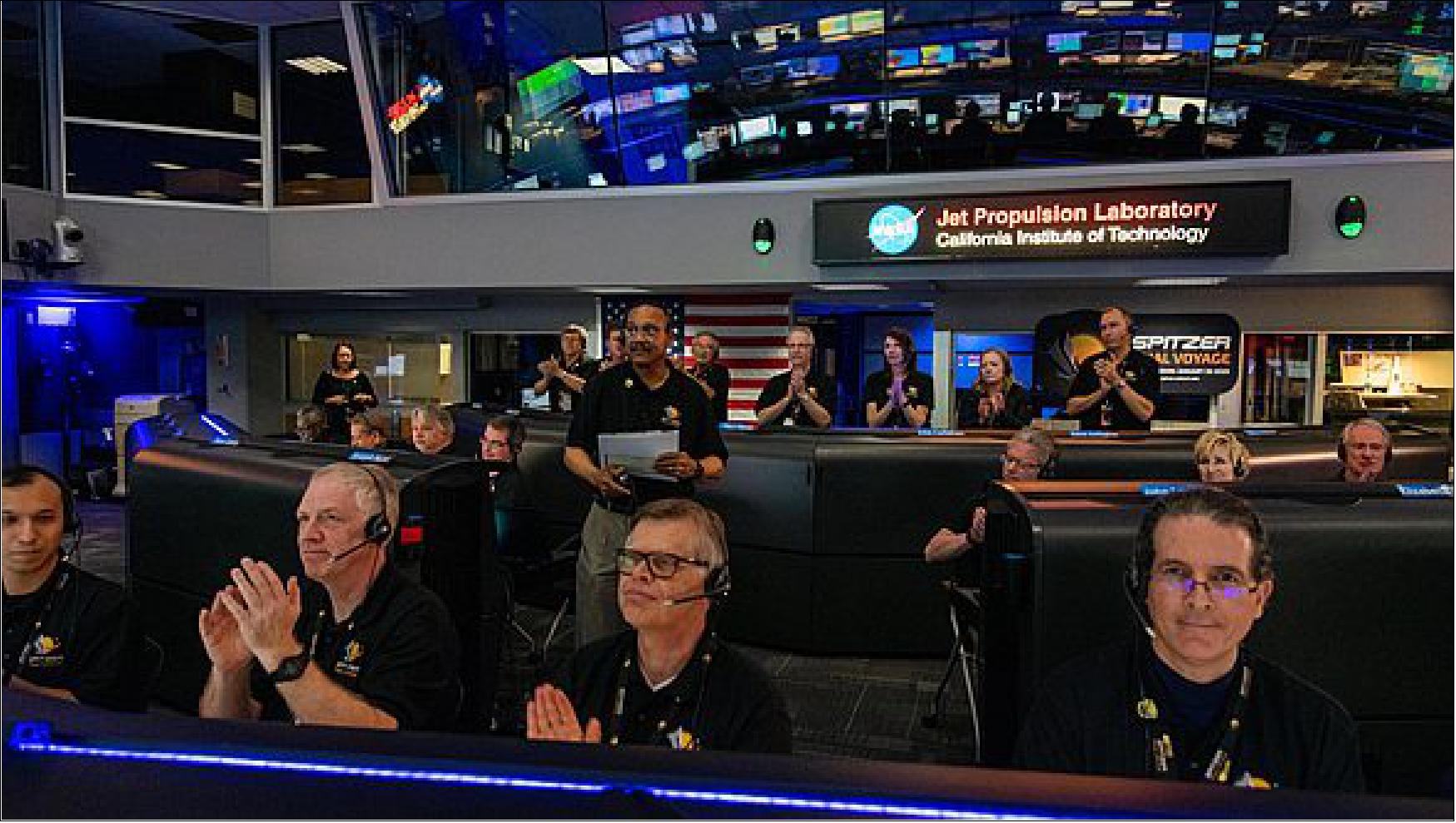
- Among its many scientific contributions, Spitzer studied comets and asteroids in our own solar system and found a previously unidentified ring around Saturn. It studied star and planet formation, the evolution of galaxies from the ancient universe to today, and the composition of interstellar dust. It also proved to be a powerful tool for detecting exoplanets and characterizing their atmospheres. Spitzer's best-known work may be detecting the seven Earth-size planets in the TRAPPIST-1 system - the largest number of terrestrial planets ever found orbiting a single star - and determining their masses and densities.
- In 2016, following a review of operating astrophysics missions,NASA made a decision to close out the Spitzer mission in 2018 in anticipation of the launch of the James Webb Space Telescope, which also will observe the universe in infrared light. When Webb's launch was postponed, Spitzer was granted an extension to continue operations until this year. This gave Spitzer additional time to continue producing transformative science, including insights that will pave the way for Webb, which is scheduled to launch in 2021.
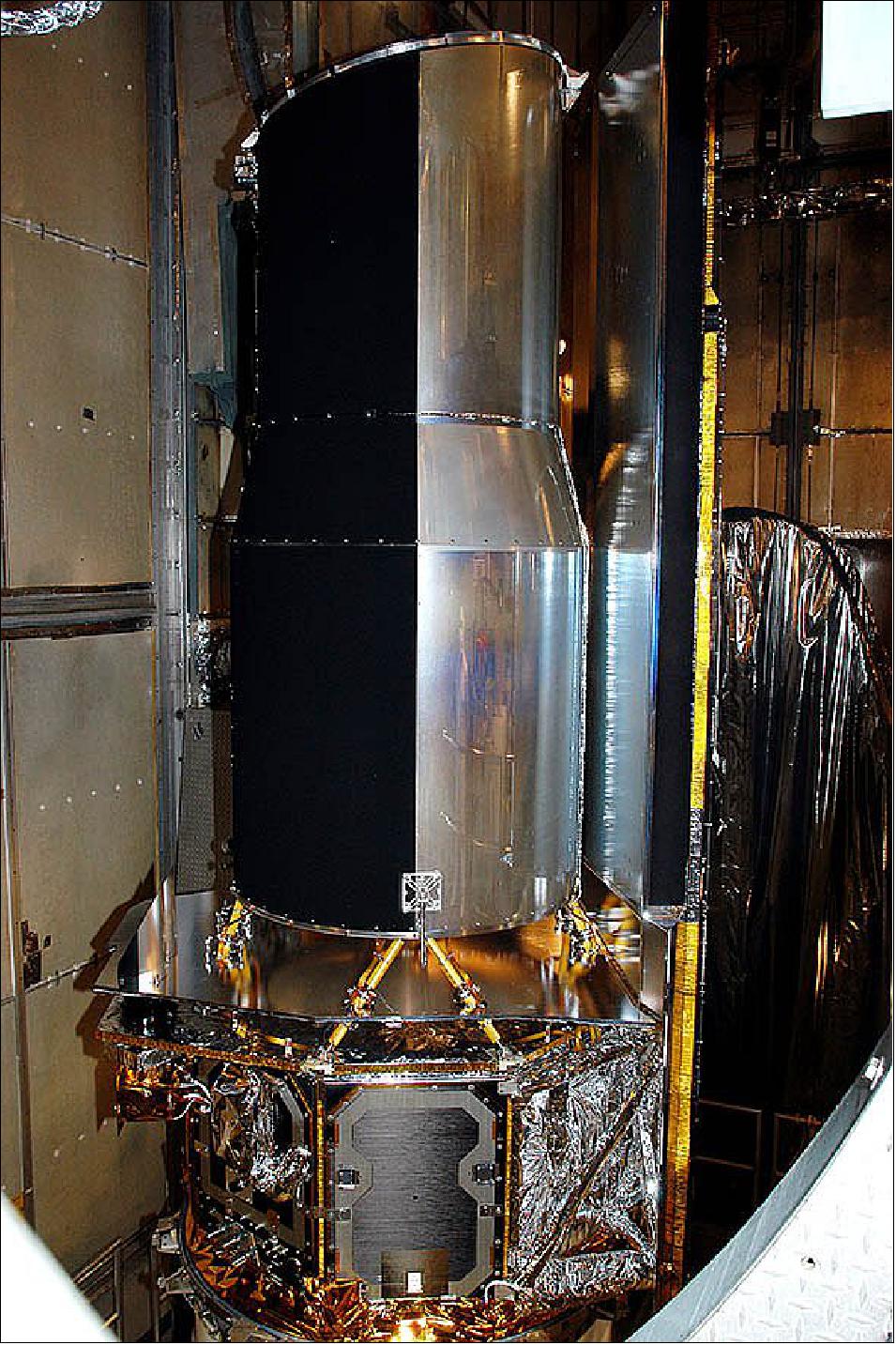
- "Everyone who has worked on this mission should be extremely proud today," Hunt said. "There are literally hundreds of people who contributed directly to Spitzer's success, and thousands who used its scientific capabilities to explore the universe. We leave behind a powerful scientific and technological legacy."
Keeping Cool
- Though it was not NASA's first space-based infrared telescope, Spitzer was the most sensitive infrared telescope in history when it launched, and it delivered a deeper and more far-reaching view of the infrared cosmos than its predecessors. Above Earth's atmosphere, Spitzer could detect some wavelengths that cannot be observed from the ground. The spacecraft's Earth-trailing orbit placed it far away from our planet's infrared emissions, which also gave Spitzer better sensitivity than was possible for larger telescopes on Earth.
- Spitzer's prime mission came to an end in 2009, when the telescope exhausted its supply of the liquid helium coolant necessary for operating two of its three instruments - the Infrared Spectrograph and Multiband Imaging Photometer for Spitzer (MIPS). The mission was deemed a success, having achieved all of its primary science objectives and more. But Spitzer's story wasn't over. Engineers and scientists were able to keep the mission going using only two out of four wavelength channels on the third instrument, the Infrared Array Camera. Despite increasing engineering and operations challenges, Spitzer continued to produce transformational science for another 10 1/2 years - far longer than mission planners anticipated.
- During its extended mission, Spitzer continued to make significant scientific discoveries. In 2014, it detected evidence of asteroid collisions in a newly formed planetary system, providing evidence that such smash-ups might be common in early solar systems and crucial to the formation of some planets. In 2016, Spitzer worked with Hubble to image the most distant galaxy ever detected. From 2016 onward, Spitzer studied the TRAPPIST-1 system for more than 1,000 hours. All of Spitzer's data are free and available to the public in the Spitzer data archive. Mission scientists say they expect researchers to continue making discoveries with Spitzer long after the spacecraft's decommissioning.
- "I think that Spitzer is an example of the very best that people can achieve," said Spitzer Project Scientist Michael Werner. "I feel very fortunate to have worked on this mission, and to have seen the ingenuity, doggedness and brilliance that people on the team showed. When you tap into those things and empower people to use them, then truly incredible things will happen."
- NASA's Jet Propulsion Laboratory (JPL) in Pasadena, California, conducts mission operations and manages the Spitzer Space Telescope mission for the agency's Science Mission Directorate in Washington. Science operations are conducted at the Spitzer Science Center at Caltech in Pasadena. Spacecraft operations are based at Lockheed Martin Space in Littleton, Colorado. Data are archived at the Infrared Science Archive housed at IPAC at Caltech. Caltech manages JPL for NASA.
- Lockheed Martin in Sunnyvale, California, built the Spitzer spacecraft, and during development served as lead for systems and engineering, and integration and testing. Ball Aerospace and Technologies Corporation in Boulder, Colorado provided the optics, cryogenics and thermal shells and shields for Spitzer.
- Ball developed the Infrared Spectrograph (IRS) instrument, with science leadership based at Cornell University, and the Multiband Imaging Photometer for Spitzer (MIPS) instrument, with science leadership based at the University of Arizona in Tucson. NASA's Goddard Space Flight Center in Greenbelt, Maryland, developed the Infrared Array Camera (IRAC) instrument, with science leadership based at the Harvard Smithsonian Astrophysics Observatory in Cambridge, Massachusetts.
• January 27, 2020: The Tarantula Nebula, seen in this image by the Spitzer Space Telescope, was one of the first targets studied by the infrared observatory after its launch in 2003, and the telescope has revisited it many times since. Now that Spitzer is set to be retired on Jan. 30, 2020, scientists have generated a new view of the nebula from Spitzer data. 28)
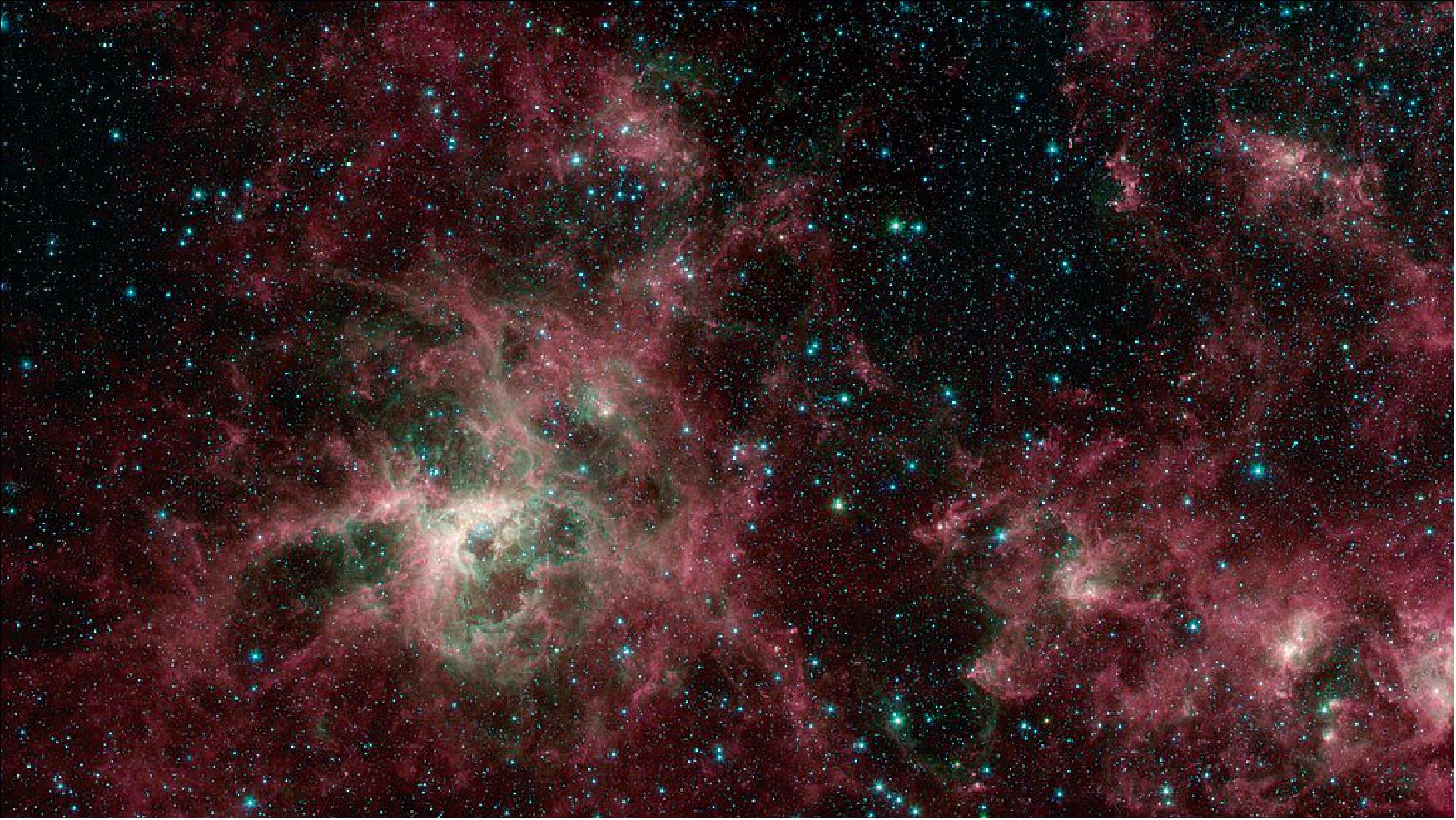
- "I think we chose the Tarantula Nebula as one of our first targets because we knew it would demonstrate the breadth of Spitzer's capabilities," said Michael Werner, who has been Spitzer's project scientist since the mission's inception and is based at NASA's Jet Propulsion Laboratory in Pasadena, California. "That region has a lot of interesting dust structures and a lot of star formation happening, and those are both areas where infrared observatories can see a lot of things that you can't see in other wavelengths."
- Infrared light is invisible to the human eye, but some wavelengths of infrared can pass through clouds of gas and dust where visible light cannot. So scientists use infrared observations to view newborn stars and still-forming "protostars," swaddled in the clouds of gas and dust from which they formed.
- Located in the Large Magellanic Cloud - a dwarf galaxy gravitationally bound to our Milky Way galaxy - the Tarantula Nebula is a hotbed of star formation. In the case of the Large Magellanic Cloud, such studies have helped scientists learn about rates of star formation in galaxies other than the Milky Way.
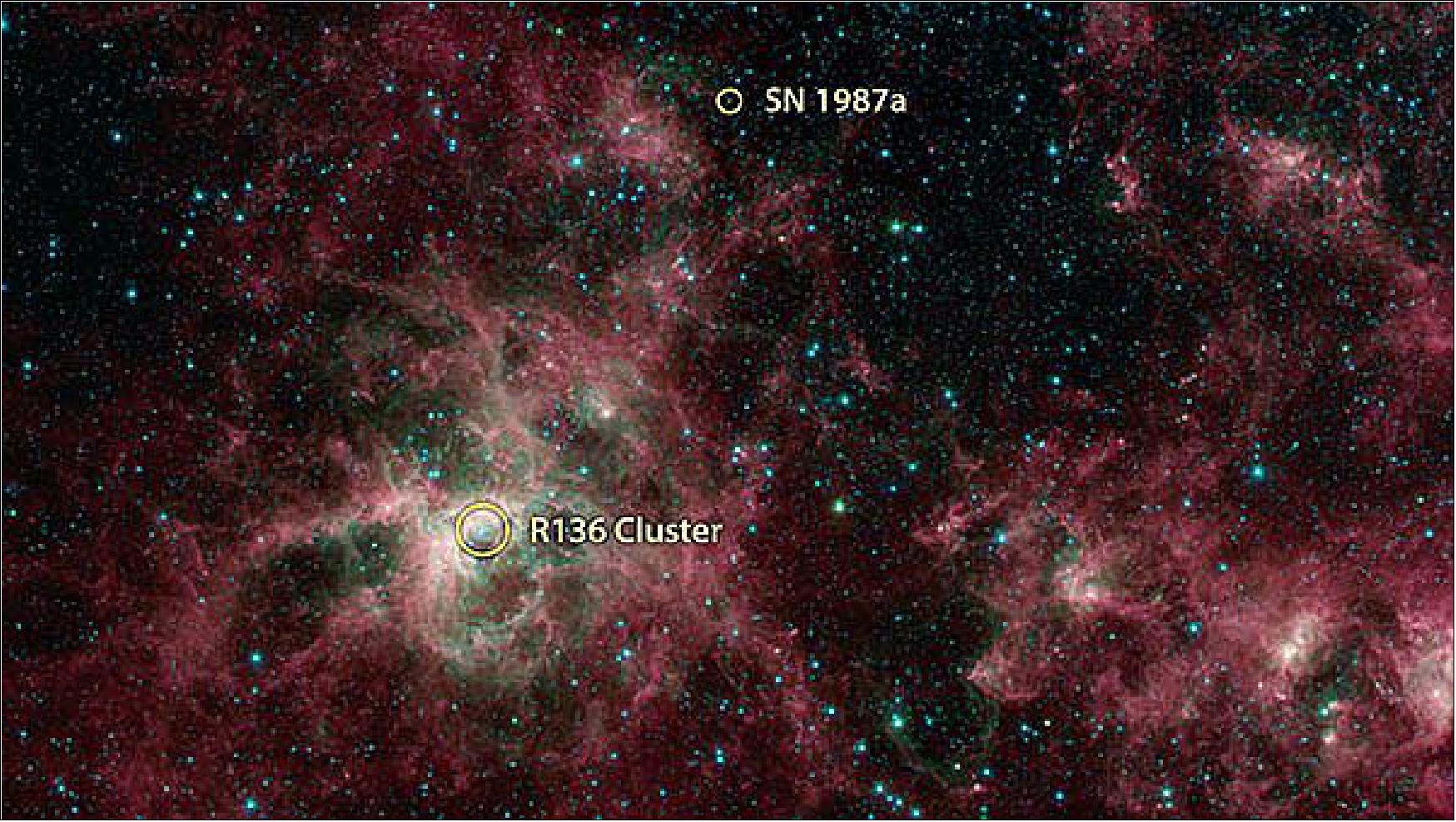
- The nebula also hosts R136, a "starburst" region, where massive stars form in extremely close proximity and at a rate far higher than in the rest of the galaxy. Within R136, in an area less than 1 light-year across (about 6 trillion miles, or 9 trillion kilometers), there are more than 40 massive stars, each containing at least 50 times the mass of our Sun. By contrast, there are no stars at all within 1 light-year of our Sun. Similar starburst regions have been found in other galaxies, containing dozens of massive stars - a higher number of massive stars than what is typically found in the rest of their host galaxies. How these starburst regions arise remains a mystery.
- On the outskirts of the Tarantula Nebula, you can also find one of astronomy's most-studied stars that has exploded in a supernova. Dubbed 1987A because it was the first supernova spotted in 1987, the exploded star burned with the power of 100 million Suns for months. The shockwave from that event continues to move outward into space, encountering material ejected from the star during its dramatic death.
- When the shockwave collides with dust, the dust heats up and begins to radiate in infrared light. In 2006, Spitzer observations saw that light and determined that the dust is largely composed of silicates, a key ingredient in the formation of rocky planets in our solar system. In 2019, scientists used Spitzer to study 1987A to monitor the changing brightness of the expanding shockwave and debris to learn more about how these explosions change their surrounding environment.
More From Spitzer
- To see more amazing images from Spitzer, check out the NASA Selfies App, which has a bundle of new Spitzer images. Available for iOS and Android, the app lets you create a snapshot of yourself in a virtual spacesuit, posing in front of gorgeous cosmic locations, including the Tarantula Nebula. Its simple interface lets you snap a photo of yourself, pick your background and share on social media while also providing you some of the science behind the images.
- For an even more immersive Spitzer experience, check out the new Spitzer Final Voyage VR experience, which places you in a 360-degree starscape that replicates Spitzer's current location orbiting the Sun, about 160 million miles (260 million km) behind Earth. The narrated video shows you how the infrared telescope operates and what the universe looks like in infrared light. The VR experience is viewable on the Spitzer YouTube channel using mobile-based VR headsets, and in the Exoplanets Excursion VR app via Oculus Rift and HTC Vive headsets.
• December 19, 2019: This image from NASA's Spitzer Space Telescope shows the Perseus Molecular Cloud, a massive collection of gas and dust that stretches over 500 light-years across. Home to an abundance of young stars, it has drawn the attention of astronomers for decades. 29)
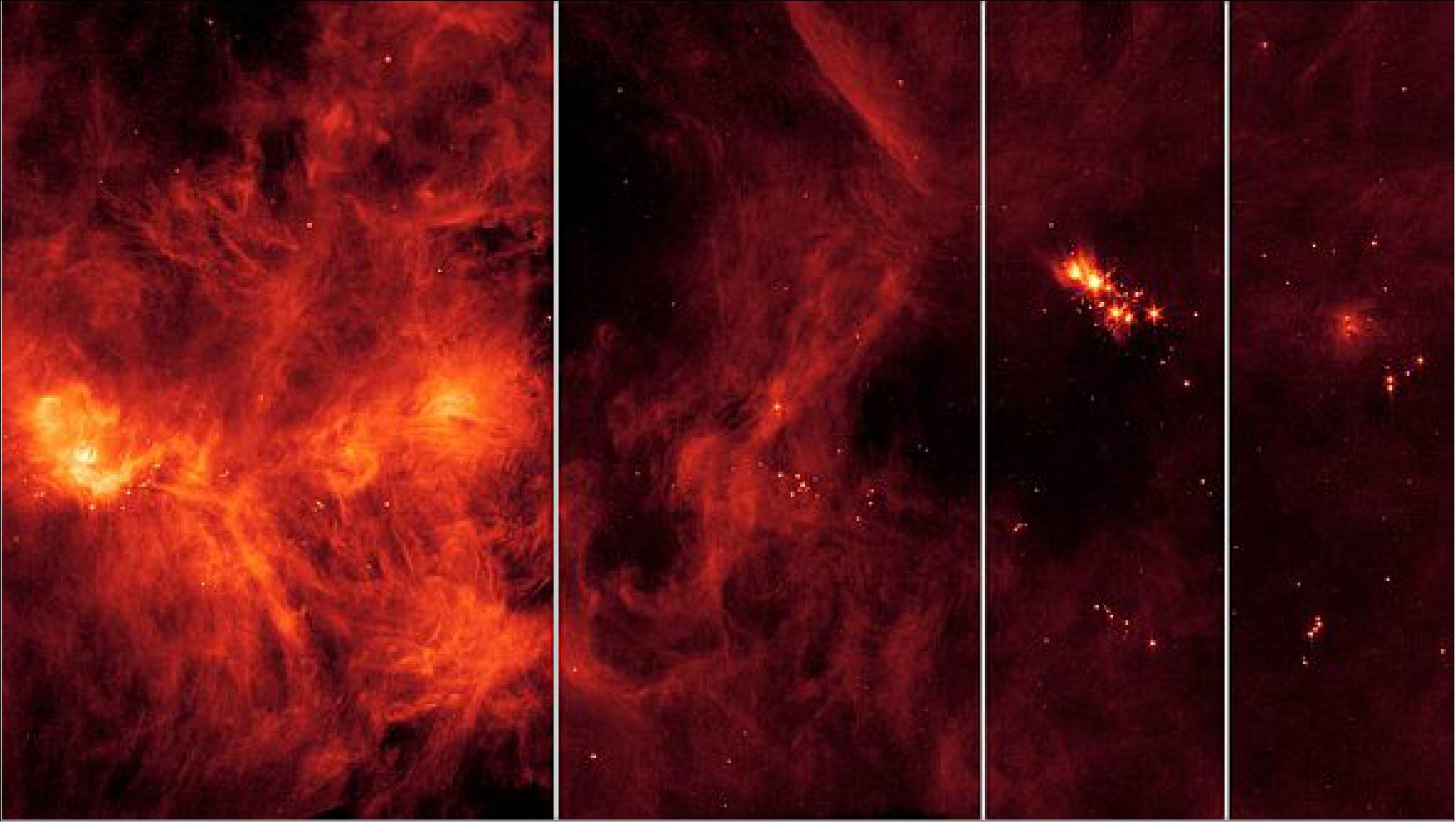
- Infrared radiation from warm dust generates much of the glow seen here from the Perseus Molecular Cloud. Clusters of stars, such as the bright spot near the left side of the image, generate even more infrared light and illuminate the surrounding clouds like the Sun lighting up a cloudy sky at sunset. Much of the dust seen here emits little to no visible light (in fact, the dust blocks visible light) and is therefore revealed most clearly with infrared observatories like Spitzer.
- On the right side of the image is a bright clump of young stars known as NGC 1333, which Spitzer has observed multiple times. It is located about 1,000 light-years from Earth. That sounds far, but it is close compared to the size of our galaxy, which is about 100,000 light-years across. NGC 1333's proximity and strong infrared emissions made it visible to astronomers using some of the earliest infrared instruments.
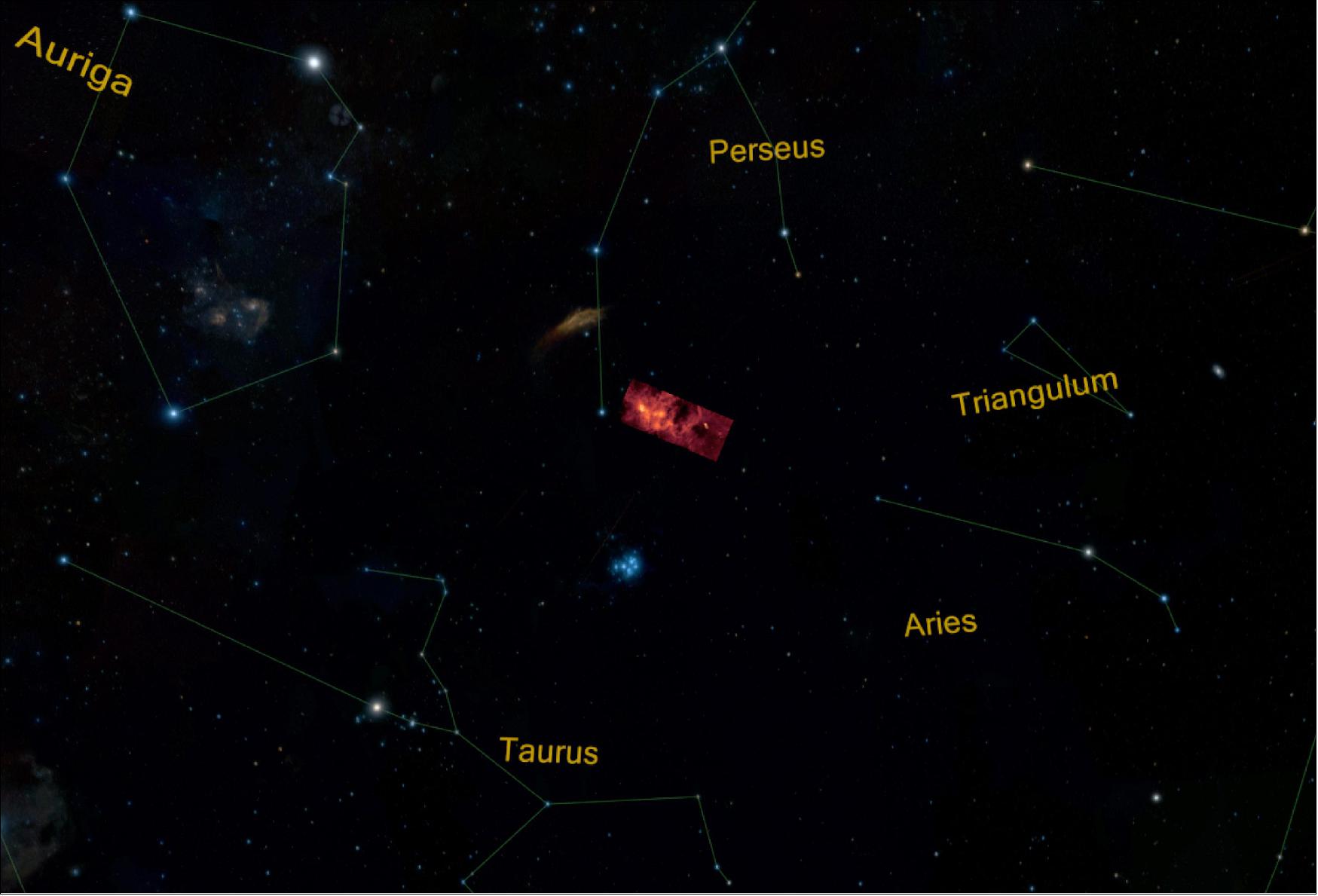
- In fact, some of its stars were first observed in the mid-1980s with the Infrared Astronomical Survey (IRAS), a joint mission between NASA, the United Kingdom and the Netherlands. The first infrared satellite telescope, it observed the sky in infrared wavelengths blocked by Earth's atmosphere, providing the first-ever view of the universe in those wavelengths.
- More than 1,200 peer-reviewed research papers have been written about NGC 1333, and it has been studied in other wavelengths of light, including by the Hubble Space Telescope, which detects mostly visible light, and the Chandra X-Ray Observatory.
- Many young stars in the cluster are sending massive outflows of material - the same material that forms the star - into space. As the material is ejected, it is heated up and smashes into the surrounding interstellar medium. These factors cause the jets to radiate brightly, and they can be seen in close-up studies of the region. This has provided astronomers with a clear glimpse of how stars go from a sometimes-turbulent adolescence into calmer adulthood.
An Evolving Mystery
- Other clusters of stars seen below NGC 1333 in this image have posed a fascinating mystery for astronomers: They appear to contain stellar infants, adolescents and adults. Such a closely packed mixture of ages is extremely odd, according to Luisa Rebull, an astrophysicist at NASA's Infrared Science Archive at Caltech-IPAC who has studied NGC 1333 and some of the clusters below it. Although many stellar siblings may form together in tight clusters, stars are always moving, and as they grow older they tend to move farther and farther apart.
- Finding such a closely packed mixture of apparent ages doesn't fit with current ideas about how stars evolve. "This region is telling astronomers that there's something we don't understand about star formation," said Rebull. The puzzle presented by this region is one thing that keeps astronomers coming back to it. "It's one of my favorite regions to study," she added.
- Since IRAS's early observations, the region has come into clearer focus, a process that is common in astronomy, said Rebull. New instruments bring more sensitivity and new techniques, and the story becomes clearer with each new generation of observatories. On Jan. 30, 2020, NASA will decommission the Spitzer Space Telescope, but its legacy has paved the way for upcoming observatories, including the James Webb Space Telescope, which will also observe infrared light.
- The Spitzer-MIPS data used for this image is at the infrared wavelength of 24 microns. Small gaps along the edges of this image not observed by Spitzer were filled in using 22-micron data from NASA's Wide-Field Infrared Survey Explorer (WISE).
• September 30, 2019: This infrared image from NASA's Spitzer Space Telescope shows a cloud of gas and dust full of bubbles, which are inflated by wind and radiation from young, massive stars. Each bubble is filled with hundreds to thousands of stars, which form from dense clouds of gas and dust. 30)
- Flows of particles emitted by the stars, called stellar winds, as well as the pressure of the light the stars produce, can push the surrounding material outward, sometimes creating a distinct perimeter.
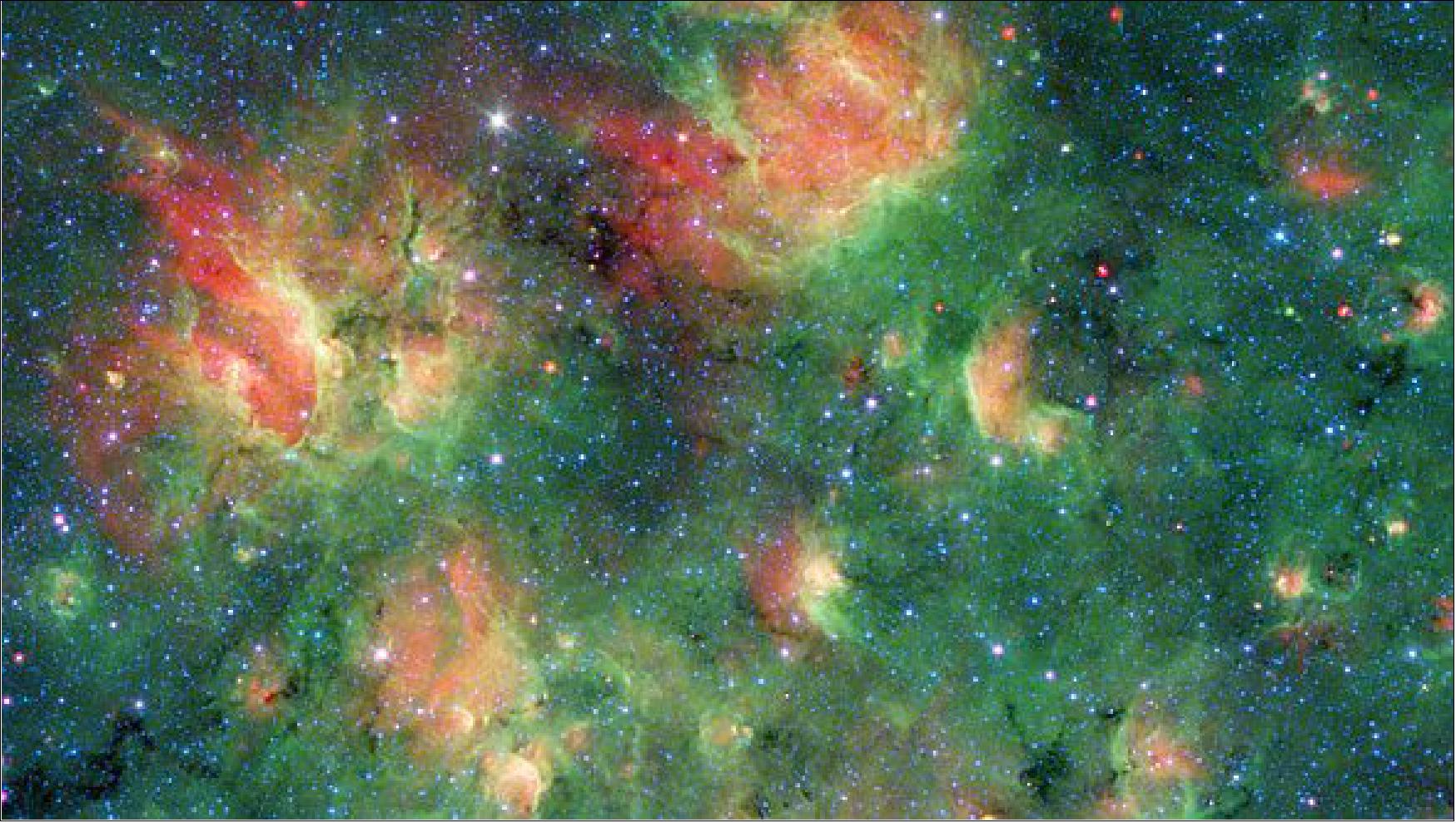
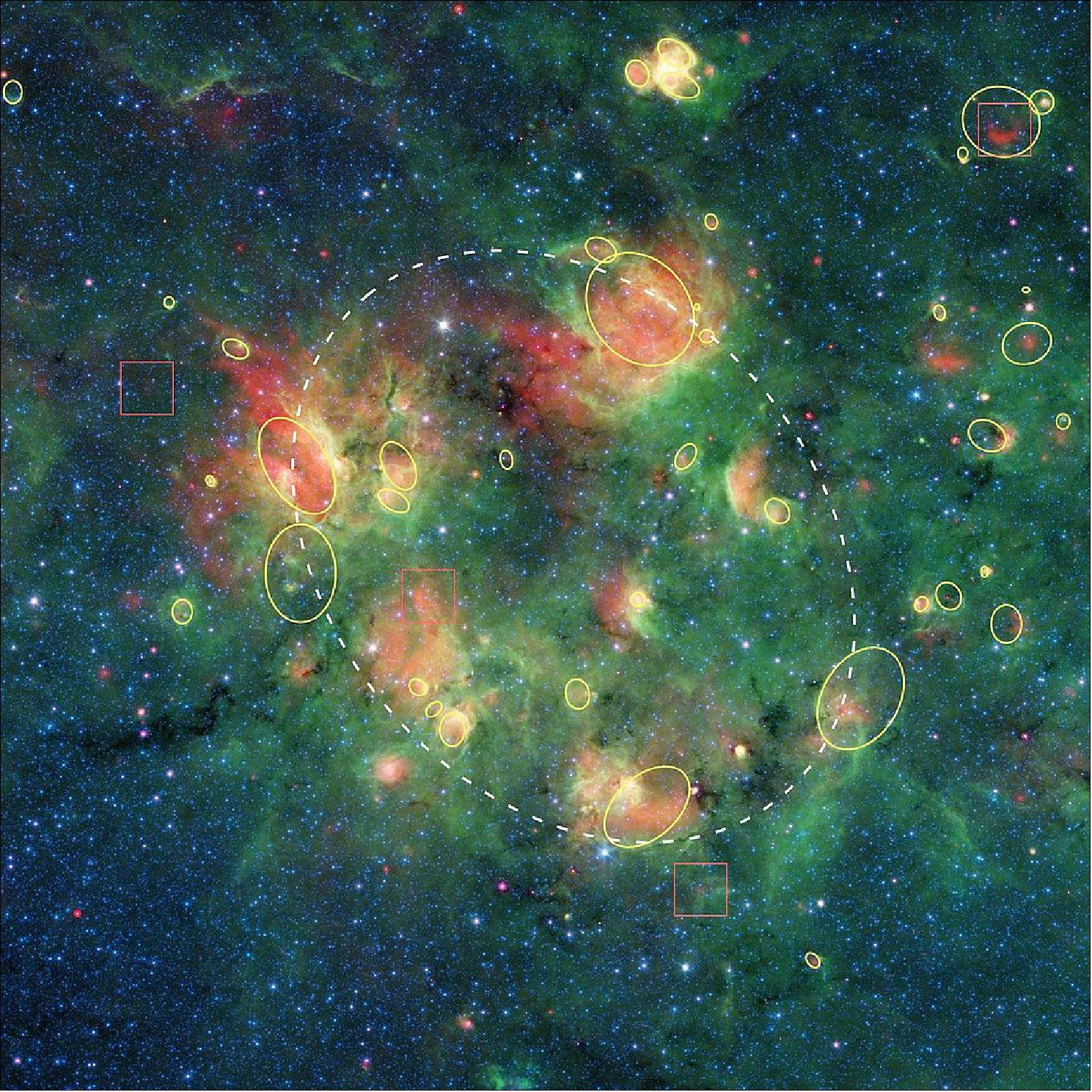
- This active region of star formation is located within the Milky Way galaxy, in the constellation Aquila (also known as the Eagle). Black veins running throughout the cloud are regions of especially dense cold dust and gas where even more new stars are likely to form.
- Spitzer sees infrared light, which isn't visible to the human eye. Many interstellar nebulas (clouds of gas and dust in space) like this one are best observed in infrared light because infrared wavelengths can pass through intervening layers of dust in the Milky Way galaxy. Visible light, however, tends to be blocked more by dust.
- The colors in this image represent different wavelengths of infrared light. Blue represents a wavelength of light primarily emitted by stars; dust and organic molecules called hydrocarbons appear green, and warm dust that's been heated by stars appears red.
- Also visible are four bow shocks — red arcs of warm dust formed as winds from fast-moving stars push aside dust grains scattered sparsely through most of the nebula. The locations of the bow shocks are indicated by squares in the annotated image above and shown close up in the images of Figure 42.

- The bubbles and bow shocks in these images were identified as part of The Milky Way Project, a citizen science initiative on Zooniverse.org that seeks to map star formation throughout the galaxy. Participating citizen scientists looked through images from Spitzer's public data archive and identified as many bubbles as they could. More than 78,000 unique user accounts contributed. Astronomers running this program recently published a catalog of the bubble candidates that multiple citizen scientists had identified. The full Milky Way Project catalogs, which list a total of 2,600 bubbles and 599 bow shocks, are described in a paper published recently in Monthly Notices of the Royal Astronomical Society.
• June 26, 2019: Unlike Andy Warhol's famous silkscreen grids of repeating images rendered in different colors, the varying hues of this galaxy represent how its appearance changes in different wavelengths of light - from visible light to the infrared light seen by NASA's Spitzer Space Telescope. 31)
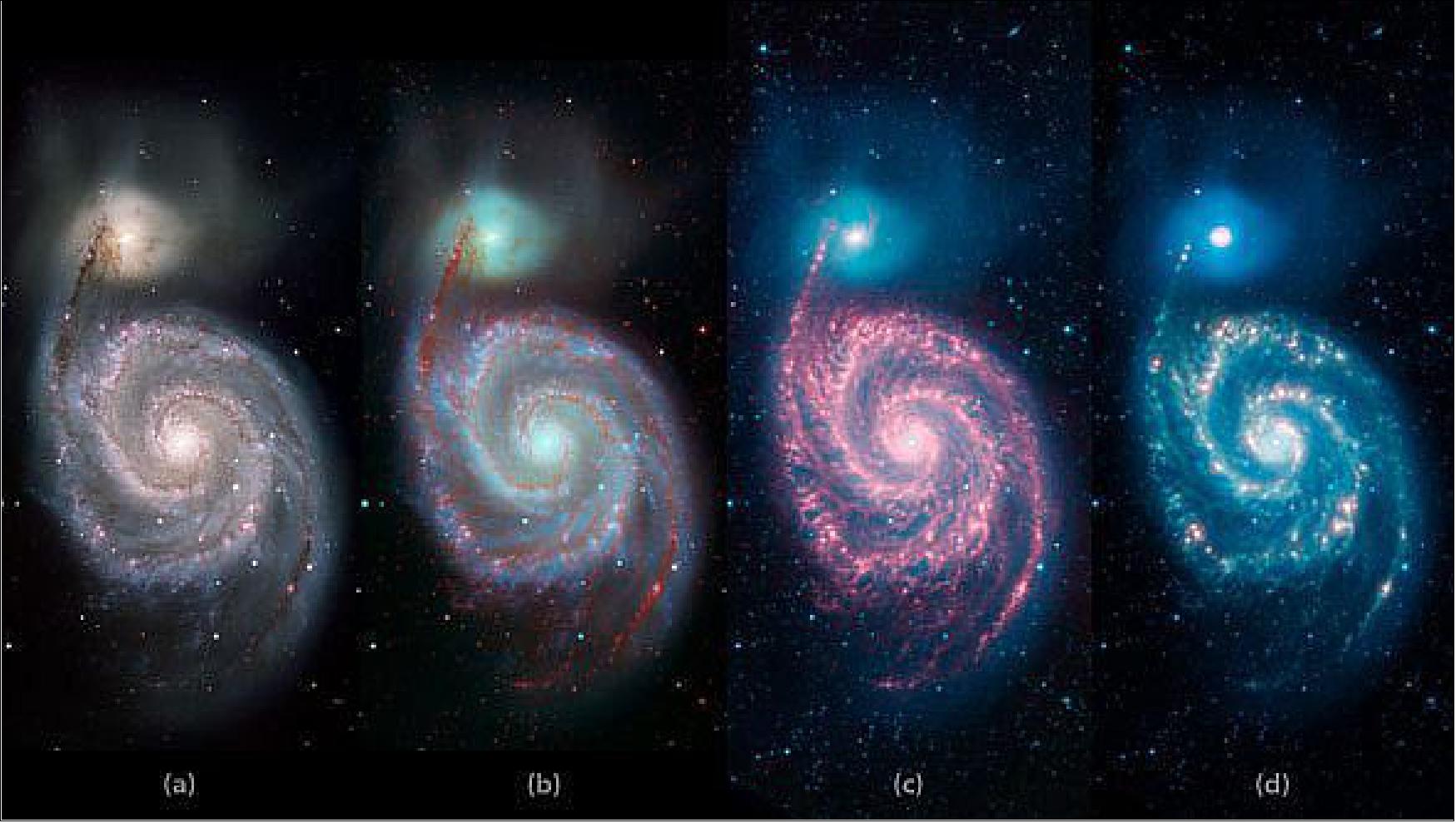
- The leftmost panel (a) shows the Whirlpool in visible light, much as our eye might see it through a powerful telescope. In fact, this image comes from the Kitt Peak National Observatory 2.1-meter (6.8-foot) telescope. The spiraling arms are laced with dark threads of dust that radiate little visible light and obscure stars positioned within or behind them.
- The second panel from the left (b) includes two visible-light wavelengths (in blue and green) from Kitt Peak but adds Spitzer's infrared data in red. This emphasizes how the dark dust veins that block our view in visible light begin to light up at these longer, infrared wavelengths.
- Spitzer's full infrared view can be seen in the right two panels, which cover slightly different ranges of infrared light.
- In the middle-right panel (c), we see three wavelengths of infrared light: 3.6 µm (shown in blue), 4.5 µm (green) and 8 µm (red). The blended light from the billions of stars in the Whirlpool is brightest at the shorter infrared wavelengths and is seen here as a blue haze. The individual blue dots across the image are mostly nearby stars and a few distant galaxies. Red features show us dust composed mostly of carbon that is lit up by the stars in the galaxy.
- This glowing dust helps astronomers see where the densest areas of gas pile up in the spaces between the stars. Dense gas clouds are difficult to see in visible or infrared light, but they will always be present where there is dust.
- The far-right panel (d) expands our infrared view to include light at a wavelength of 24 µm (in red), which is particularly good for highlighting areas where the dust is especially hot. The bright reddish-white spots trace regions where new stars are forming and, in the process, heating their surroundings.
- The infrared views of the Whirlpool galaxy also show how dramatically different its two component parts are: The smaller companion galaxy at the top of the image has been stripped nearly clean of dust features that stand out so brilliantly in the lower spiral galaxy. The faint bluish haze seen around the upper galaxy is likely the blended light from stars thrown out of the galaxies as these two objects pull at each other during their close approach.
- The Kitt Peak visible-light image (a) shows light at 0.4 and 0.7 µm (blue and red). The rightmost two images (c and d) are from Spitzer with red, green and blue corresponding to wavelengths of 3.6, 4.5 and 8.0 µm (middle right) and 3.6, 8.0 and 24 µm (far right). The middle-left (b) image blends visible wavelengths (blue/green) and infrared (yellow/red). All of the data shown here were released as part of the Spitzer Infrared Nearby Galaxies Survey (SINGS) project, captured during Spitzer's cryogenic and warm missions.
References
1) ”Mission Overview,” NASA/JPL, URL: https://www.spitzer.caltech.edu/mission/mission-overview
2) M. W. Werner, T. L. Roellig, F. J. Low, G. H. Rieke, M. Rieke, W. F. Hoffmann, E. Young, J. R. Houck, B. Brandl, G. G. Fazio, J. L. Hora, R. D. Gehrz, G. Helou, B. T. Soifer, J. Stauffer, J. Keene, P. Eisenhardt, D. Gallagher, T. N. Gautier, W. Irace, C. R. Lawrence, L. Simmons, J. E. Van Cleve, M. Jura, E. L. Wright, and D. P. Cruikshank, ”The Spitzer Space Telescope Mission,” The Astrophysical Journal Supplement Series, Volume 154, Number 1, 2004, https://doi.org/10.1086/422992, URL: https://iopscience.iop.org/article/10.1086/422992/pdf
3) ”NASA Helps Decipher How Some Distant Planets Have Clouds of Sand,” NASA News, 7 July 2022, URL: https://www.jpl.nasa.gov/news/nasa-helps-decipher-how-some-distant-planets-have-clouds-of-sand?utm_source=iContact&utm_medium=email&utm_campaign=nasajpl&utm_content=spitzer20220707
4) ”NASA Spots Giant Debris Cloud Created by Clashing Celestial Bodies,” NASA/JPL News, 18 March 2022, URL: https://www.jpl.nasa.gov/news/nasa-spots-giant-debris-cloud-created-by-clashing-celestial-bodies?utm_source=iContact&utm_medium=email&utm_campaign=nasajpl&utm_content=media-spitzer20220318-1
5) Kate Y. L. Su, Grant M. Kennedy, Everett Schlawin, Alan P. Jackson, and G. H. Rieke, ”A Star-sized Impact-produced Dust Clump in the Terrestrial Zone of the HD 166191 System,” The Astrophysical Journal, Volume 927, Number 2, Published: 10 March 2022, https://doi.org/10.3847/1538-4357/ac4bbb, URL: https://iopscience.iop.org/article/10.3847/1538-4357/ac4bbb/pdf
6) ”NASA’s Spitzer Illuminates Exoplanets in Astronomical Society Briefing,” NASA/JPL News, 13 January 2022, URL: https://www.jpl.nasa.gov/news/nasas-spitzer-illuminates-exoplanets-in-astronomical-society-briefing?utm_source=iContact&utm_medium=email&utm_campaign=nasajpl&utm_content=spitzer20220113-1
7) ”A ‘Monster’ Star-Forming Region Spied by NASA’s Spitzer,” NASA/JPL News, 25 October 2021, URL: https://www.jpl.nasa.gov/news/a-monster-star-forming-region-spied-by-nasas-spitzer
8) ”Astronomers Find a ‘Break’ in One of the Milky Way’s Spiral Arms,” NASA/JPL News, 17 August 2021, URL: https://www.jpl.nasa.gov/news/astronomers-find-a-break-in-one-of-the-milky-ways-spiral-arms?utm_source=iContact&utm_medium=email&utm_campaign=nasajpl&utm_content=gaia20210817-1
9) M. A. Kuhn, R. A. Benjamin, C. Zucker, A. Krone-Martins, R. S. de Souza, A. Castro-Ginard, E. E. O. Ishida, M. S. Povich and L. A. Hillenbrand for the COIN Collaboration, ”A high pitch angle structure in the Sagittarius Arm,” Astronomy & Astrophysics, Volume 651, Article No L10, Published online: 21 July 2021, https://doi.org/10.1051/0004-6361/202141198
10) Calla Cofield, ”Stars Are Exploding in Dusty Galaxies. We Just Can’t Always See Them,” NASA/JPL Feature 2021-162, 4 August 2021, URL: https://www.jpl.nasa.gov/news/stars-are-exploding-in-dusty-galaxies-we-just-cant-always-see-them
11) Ori D Fox, Harish Khandrika, David Rubin, Chadwick Casper, Gary Z Li, Tamás Szalai, Lee Armus, Alexei V Filippenko, Michael F Skrutskie, Lou Strolger, Schuyler D Van Dyk, ”A Spitzer survey for dust-obscured supernovae,” MNRAS, Volume 506, Issue 3, September 2021, pp: 4199-4209, Published: 21 June 2021, https://doi.org/10.1093/mnras/stab1740
12) Claire Andreoli, Lynn Jenner, ”Lyman Spitzer: Making Space For Hubble,” NASA Feature, 30 July 2021, URL: https://www.nasa.gov/feature/goddard/2021/lyman-spitzer-making-space-for-hubble
13) ”Cosmic Legacy: Retired Space Telescope Reveals ‘Hot Jupiter' Secrets,” NASA/JPL News Release, 26 July 2021, URL: https://www.spitzer.caltech.edu/news/cosmic-legacy-retired-space-telescope-reveals-hot-jupiter-secrets
14) ”The 7 Rocky TRAPPIST-1 Planets May Be Made of Similar Stuff,” NASA/JPL News Release, 22 January 2021, URL: https://www.spitzer.caltech.edu/news/ssc2021-02-the-7-rocky-trappist-1-planets-may-be-made-of-similar-stuff
15) Elizabeth Landau, ”Citizen Scientists Help Create 3D Map of Cosmic Neighborhood,” NASA/JPL News Release, 13 January 2021, URL: https://www.spitzer.caltech.edu/news/ssc2020-19-citizen-scientists-help-create-3d-map-of-cosmic-neighborhood
16) ”Continue to Follow Spitzer as you “ExploreAstro at Caltech IPAC” NASA/JPL News Release, 16 December 2020, URL: https://www.spitzer.caltech.edu/news/ssc2020-18-continue-to-follow-spitzer-as-you-exploreastro-at-caltech-ipac
17) Calla Cofield, ”16-Year-Old Cosmic Mystery Solved, Revealing Stellar Missing Link,” NASA/JPL News Release, 18 November 2020, URL: https://www.spitzer.caltech.edu/news/ssc2020-17-16-year-old-cosmic-mystery-solved-revealing-stellar-missing-link
18) ”Data reveals evidence of molecular absorption in the atmosphere of a hot Neptune,” NASA/JPL, 26 October 2020, URL: https://www.spitzer.caltech.edu/news/partner105-data-reveals-evidence-of-molecular-absorption-in-the-atmosphere-of-a-hot-neptune
19) Steve Carr, ”Data reveals evidence of molecular absorption in the atmosphere of a hot Neptune,” University of New Mexico, 26 October 2020, URL: http://news.unm.edu/news/data-reveals-evidence-of-molecular-absorption-in-the-atmosphere-of-a-hot-neptune
20) Diana Dragomir, Ian J. M. Crossfield, Björn Benneke, Ian Wong, Tansu Daylan, Matias Diaz, Drake Deming, Paul Molliere, Laura Kreidberg, James S. Jenkins, David Berardo, Jessie L. Christiansen, Courtney D. Dressing, Varoujan Gorjian, Stephen R. Kane, Thomas Mikal-Evans, Farisa Y. Morales, Michael Werner, George R. Ricker, Roland Vanderspek, S. Seager, Joshua N. Winn, Jon M. Jenkins, Knicole D. Colón, Willie Fong, Natalia Guerrero, Katharine Hesse, Hugh P. Osborn, Mark E. Rose, Jeffrey C. Smith, and Eric B. Ting, ”Spitzer Reveals Evidence of Molecular Absorption in the Atmosphere of the Hot Neptune LTT 9779b,” The Astrophysical Journal Letters, Volume 903, Number 1, Published: 26 October 2020, https://doi.org/10.3847/2041-8213/abbc70
21) Calla Cofield, ”Where Are Stars Made? NASA's Spitzer Spies a Hot Spot,” NASA/JPL News Release, 25 August 2020, URL: https://www.spitzer.caltech.edu/news/ssc2020-14-where-are-stars-made-nasas-spitzer-spies-a-hot-spot
22) ”NASA’s TESS, Spitzer Missions Discover a World Orbiting a Unique Young Star,” NASA/JPL News Release, 24 June 2020, URL: https://www.spitzer.caltech.edu/news/ssc2020-13-nasa-s-tess-spitzer-missions-discover-a-world-orbiting-a-unique-young-star
23) Peter Plavchan, Thomas Barclay, [...] Perri Zilberman, ”A planet within the debris disk around the pre-main-sequence star AU Microscopii,” Nature, Volume 582, pp>: 497-500, Published: 15 July 2020, Issue date: 30 July 2020, https://doi.org/10.1038/s41586-020-2516-1
24) Calla Cofield, ”Young Giant Planet Offers Clues to Formation of Exotic Worlds,” NASA/JPL News Release, 22 June 2020, URL: https://www.spitzer.caltech.edu/news/ssc2020-12-young-giant-planet-offers-clues-to-formation-of-exotic-worlds
25) Calla Cofield, ”Spitzer Telescope Reveals the Precise Timing of a Black Hole Dance,” NASA/JPL News Release, 28 April 2020, URL: https://www.spitzer.caltech.edu/news/ssc2020-11-spitzer-telescope-reveals-the-precise-timing-of-a-black-hole-dance
26) Seppo Laine, Lankeswar Dey, Mauri Valtonen, A. Gopakumar, Stanislaw Zola, S. Komossa, Mark Kidger, Pauli Pihajoki, José L. Gómez, Daniel Caton, Stefano Ciprini, Marek Drozdz, Kosmas Gazeas, Vira Godunova, Shirin Haque, Felix Hildebrandt, Rene Hudec, Helen Jermak, Albert K. H. Kong, Harry Lehto, Alexios Liakos, Katsura Matsumoto, Markus Mugrauer, Tapio Pursimo, Daniel E. Reichart, Andrii Simon, Michal Siwak, and Eda Sonbas, ”Spitzer Observations of the Predicted Eddington Flare from Blazar OJ 287,” The Astrophysical Journal Letters, Volume 894, Number 1, Published: 28 April 2020, https://doi.org/10.3847/2041-8213/ab79a4
27) Calla Cofield, ”NASA's Spitzer Space Telescope Ends Mission of Astronomical Discovery,” NASA/JPL News Release, 30 January 2020, URL: https://www.spitzer.caltech.edu/news/ssc2020-08-nasas-spitzer-space-telescope-ends-mission-of-astronomical-discovery
28) Calla Cofield, ”Tarantula Nebula Spins Web of Mystery in Spitzer Image,” NASA/JPL News Release, 27 January 2020, URL: https://www.spitzer.caltech.edu/news/ssc2020-06-tarantula-nebula-spins-web-of-mystery-in-spitzer-image
29) ”Spitzer Studies a Stellar Playground With a Long History,” NASA/JPL News Release, 19 December 2019, URL: https://www.spitzer.caltech.edu/news/ssc2019-18-spitzer-studies-a-stellar-playground-with-a-long-history
30) ”Spitzer Spots a Starry Region Bursting With Bubbles,” NASA/JPL News Release, 30 September 2019, URL: https://www.spitzer.caltech.edu/news/ssc2019-16-spitzer-spots-a-starry-region-bursting-with-bubbles
31) Calla Cofield, ”A Whirlpool 'Warhol' from NASA's Spitzer Telescope,” NASA/JPL News Release, 26 June 2019, URL: https://www.spitzer.caltech.edu/news/ssc2019-11-a-whirlpool-warhol-from-nasas-spitzer-telescope
The information compiled and edited in this article was provided by Herbert J. Kramer from his documentation of: ”Observation of the Earth and Its Environment: Survey of Missions and Sensors” (Springer Verlag) as well as many other sources after the publication of the 4th edition in 2002. Comments and corrections to this article are always welcome for further updates (eoportal@symbios.space).
Spacecraft Launch Sensor Complement Mission Status References Back to top